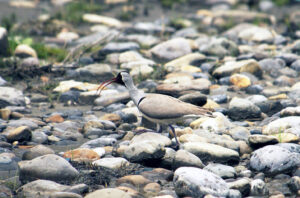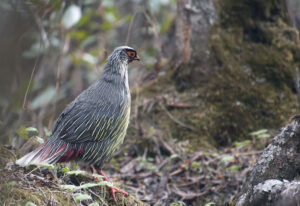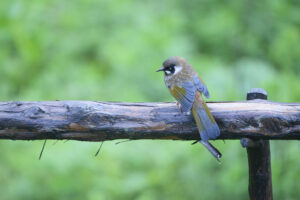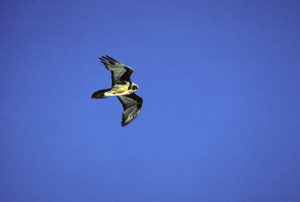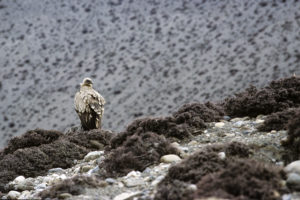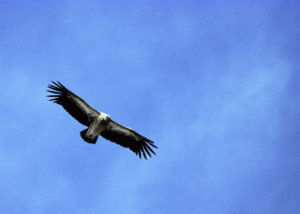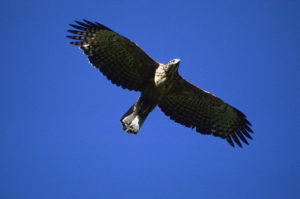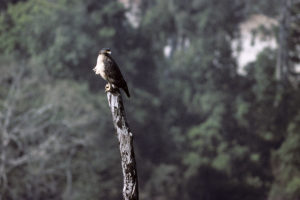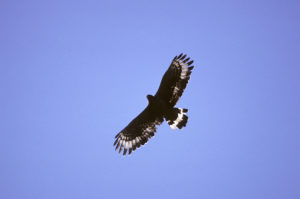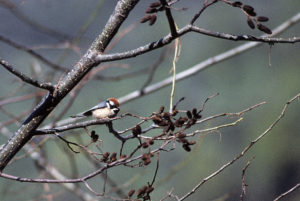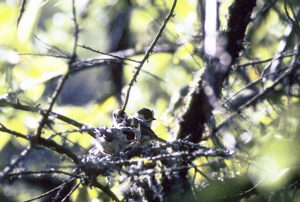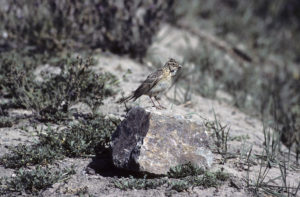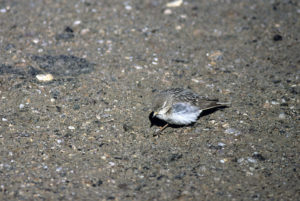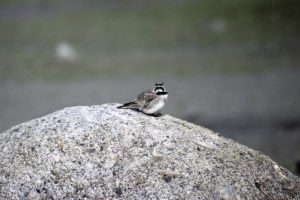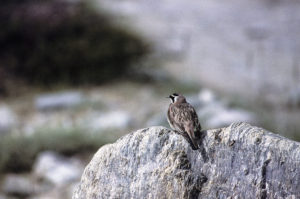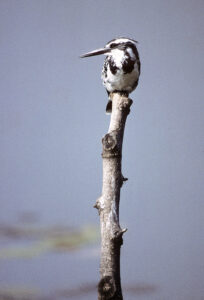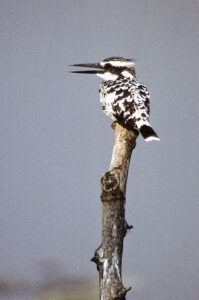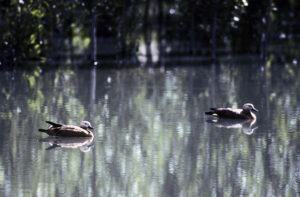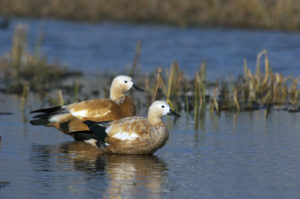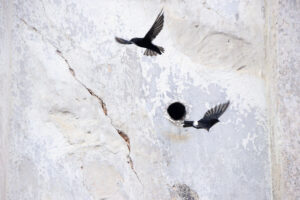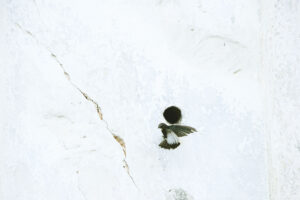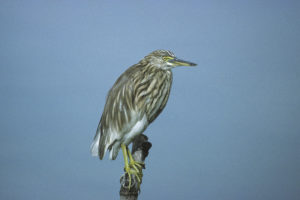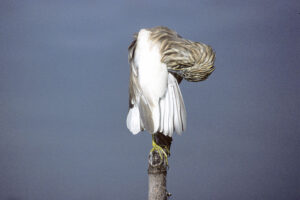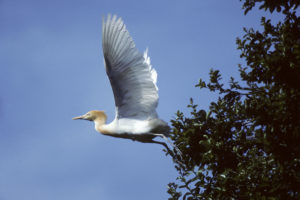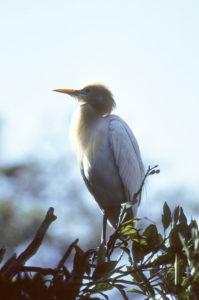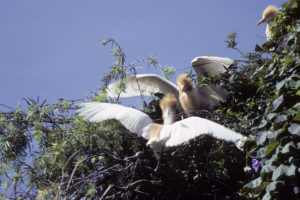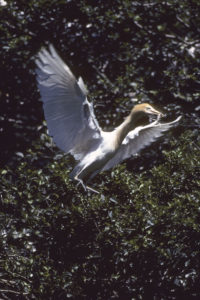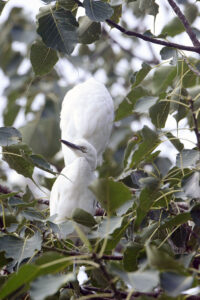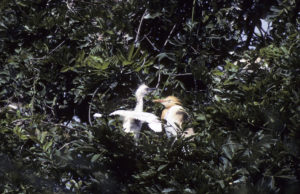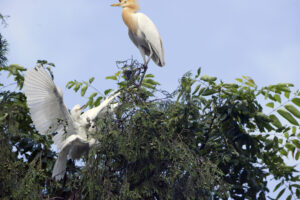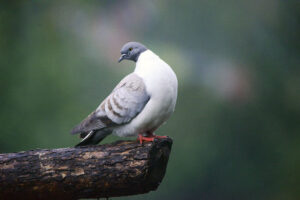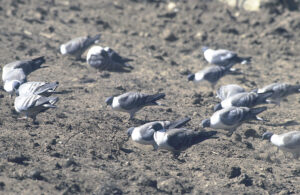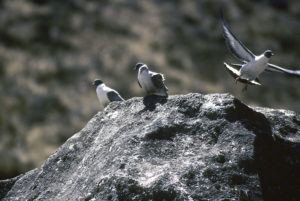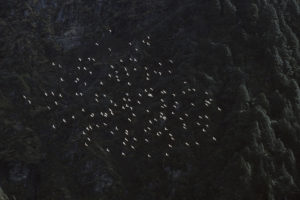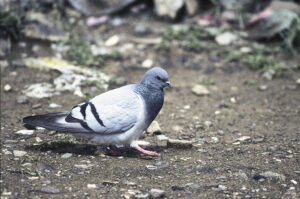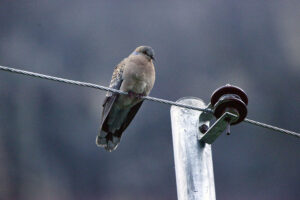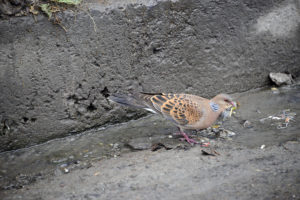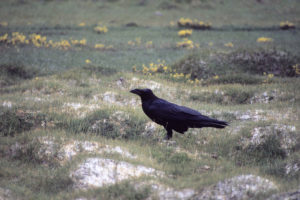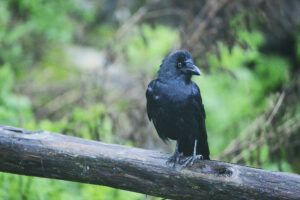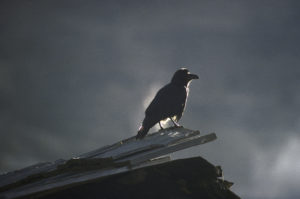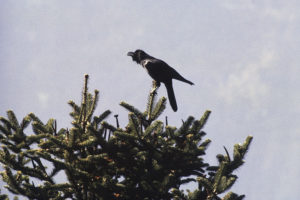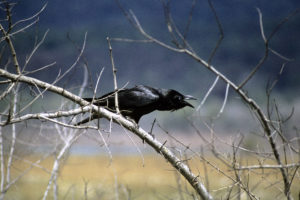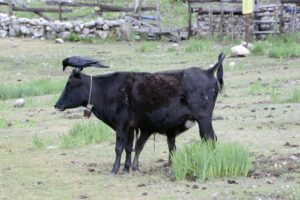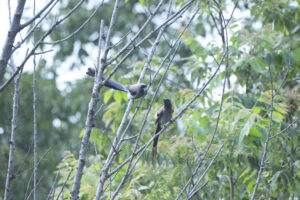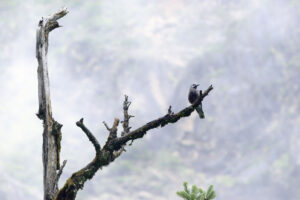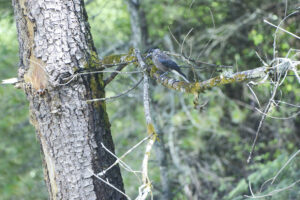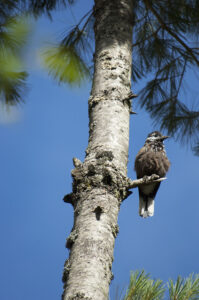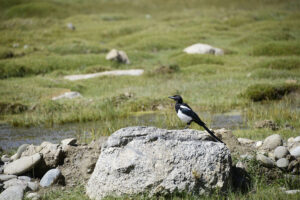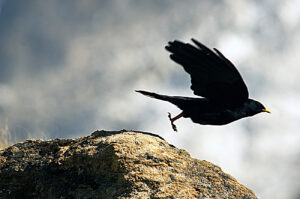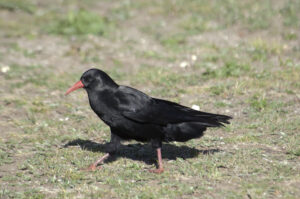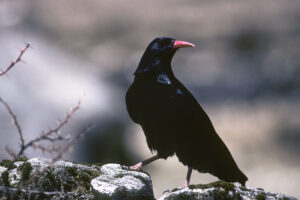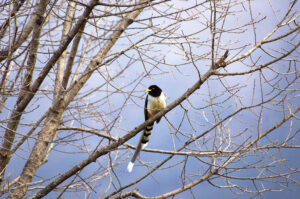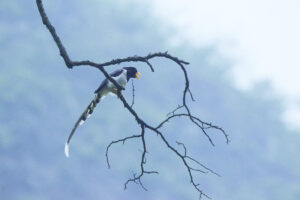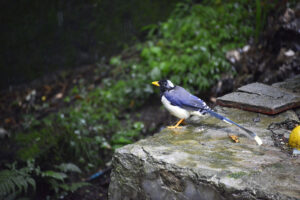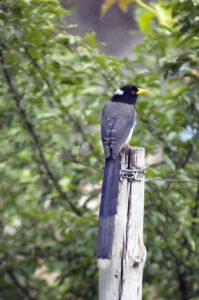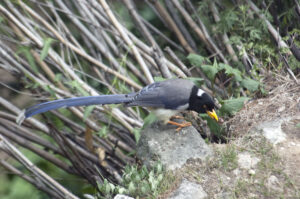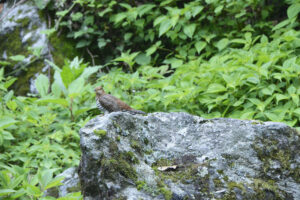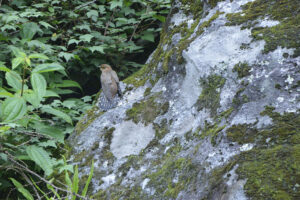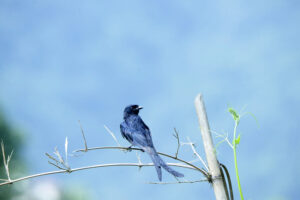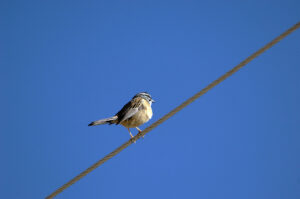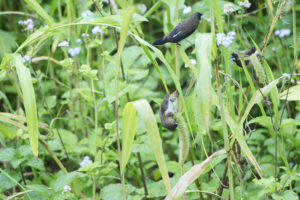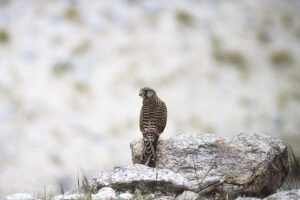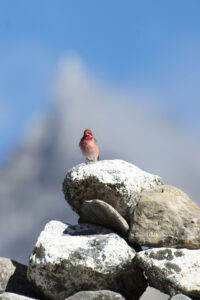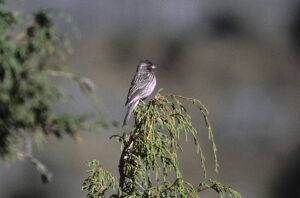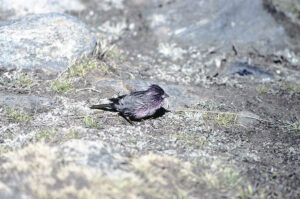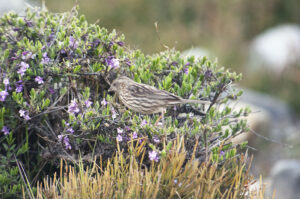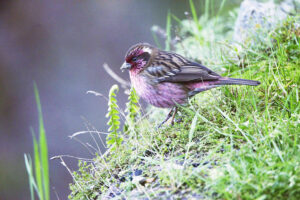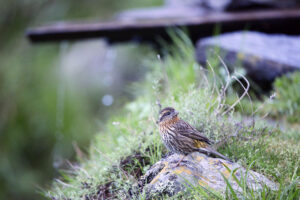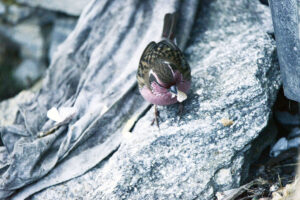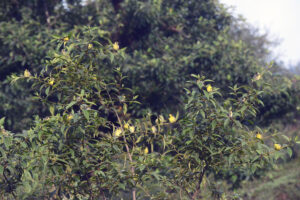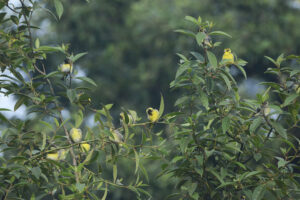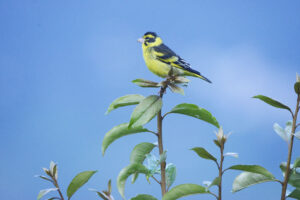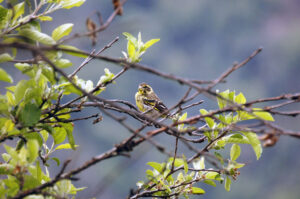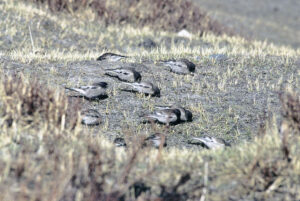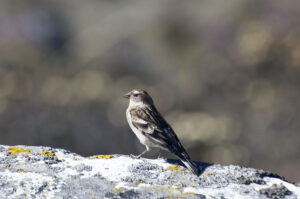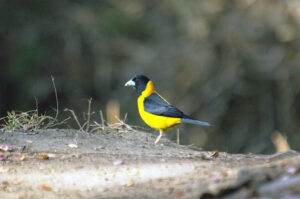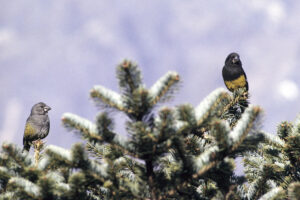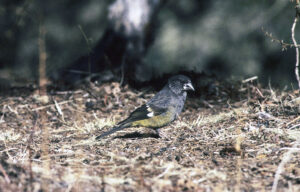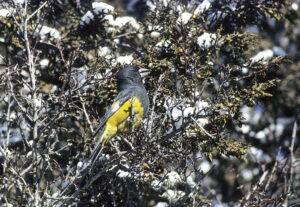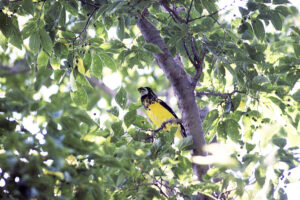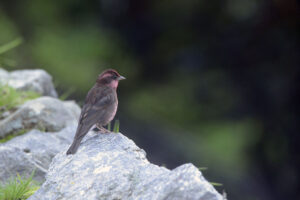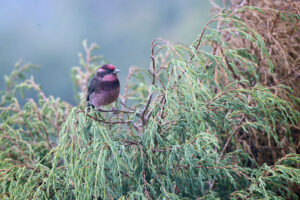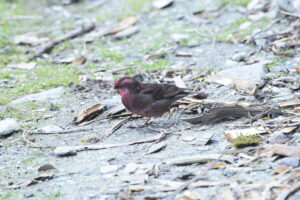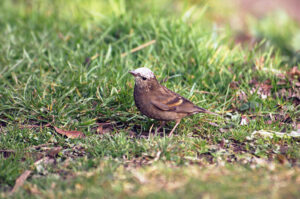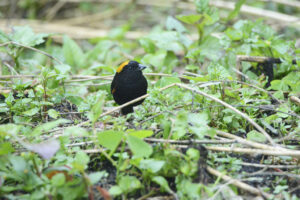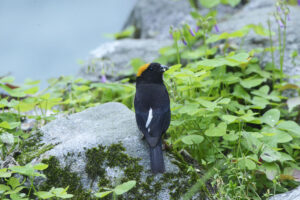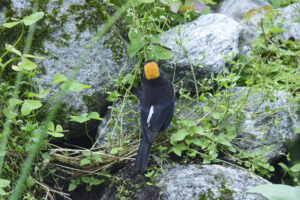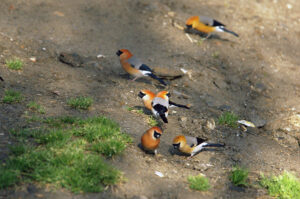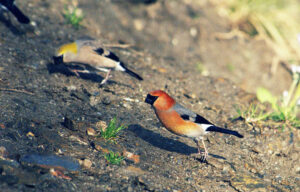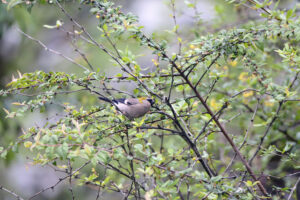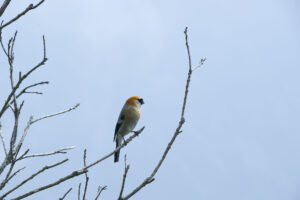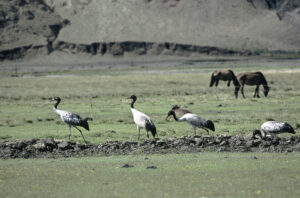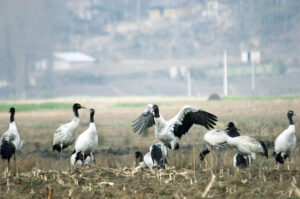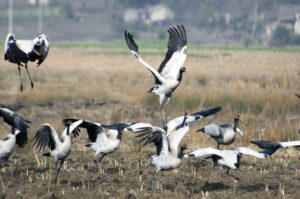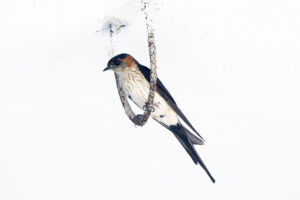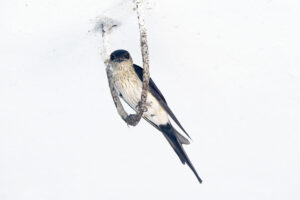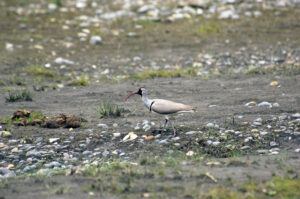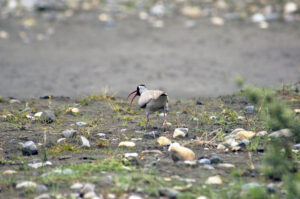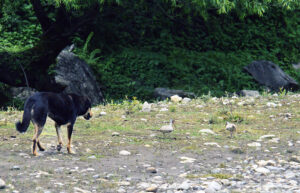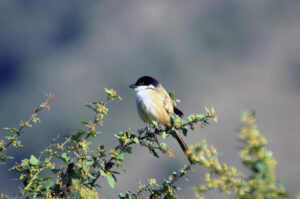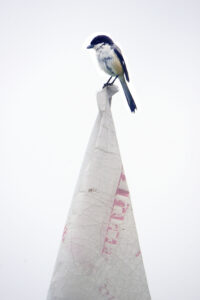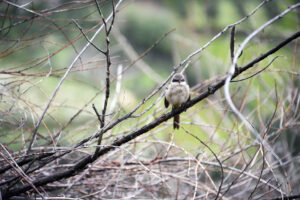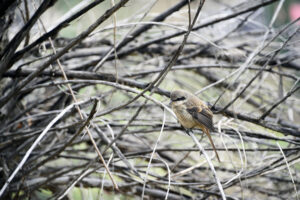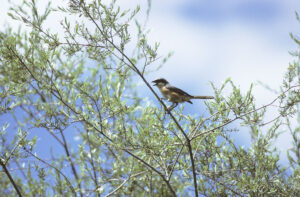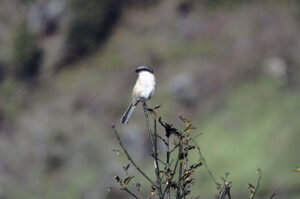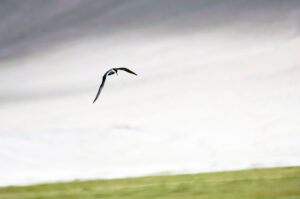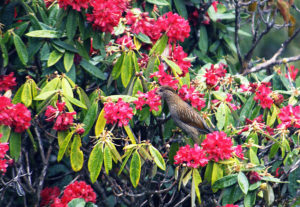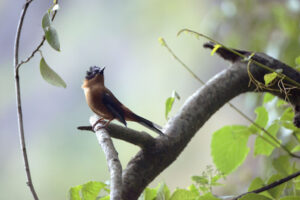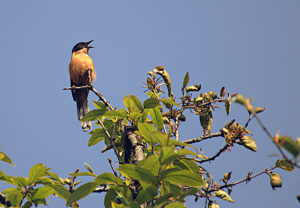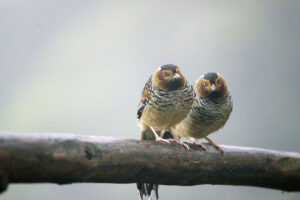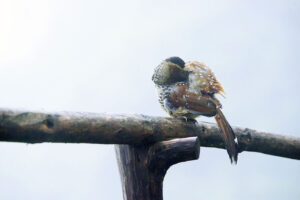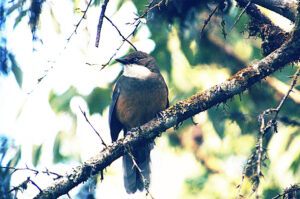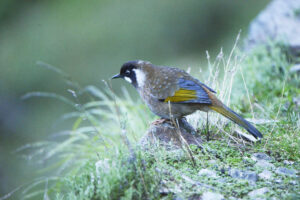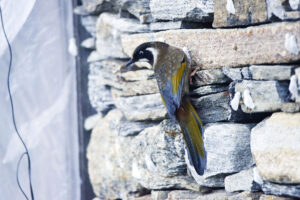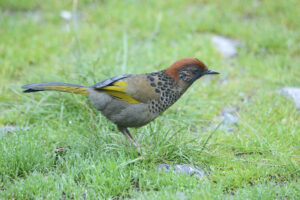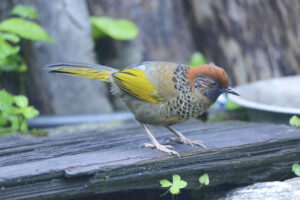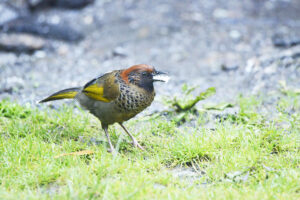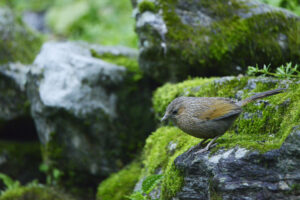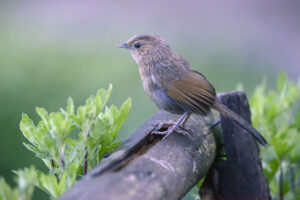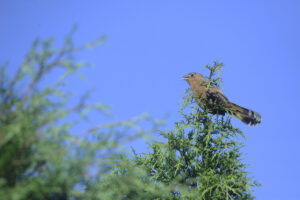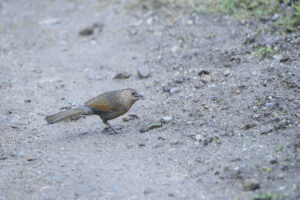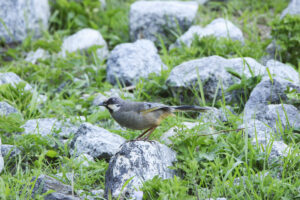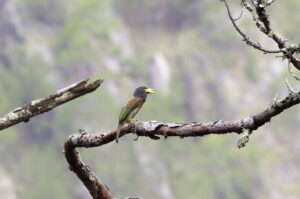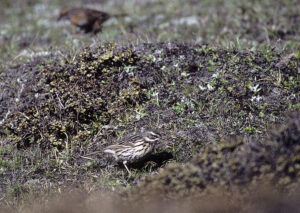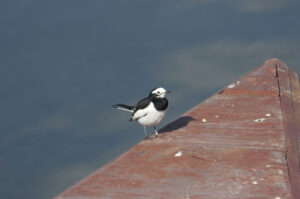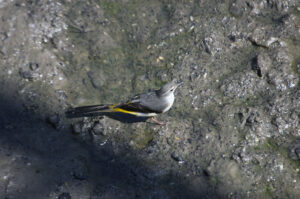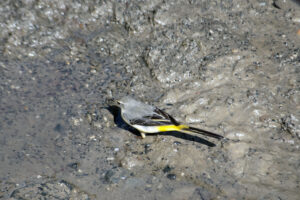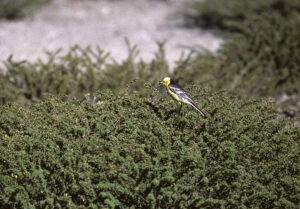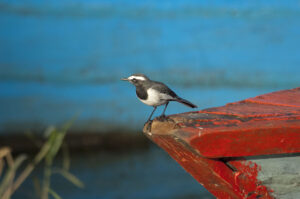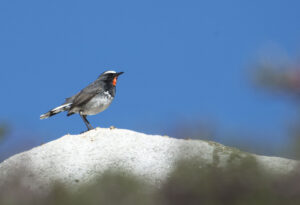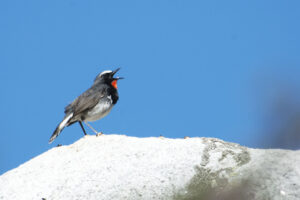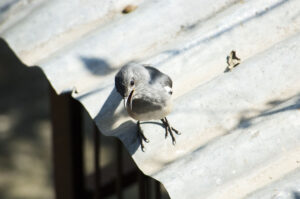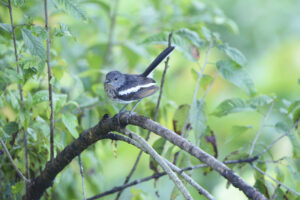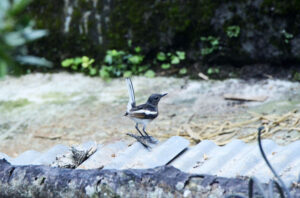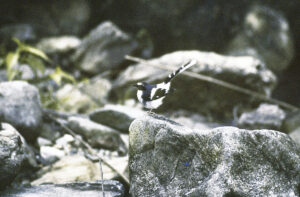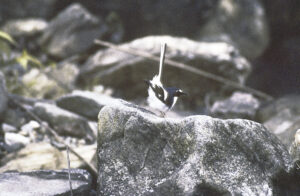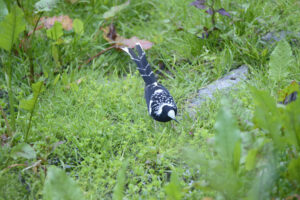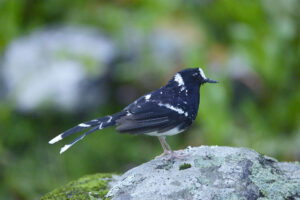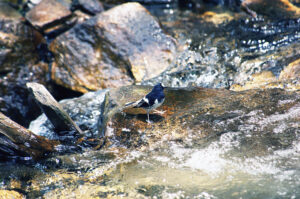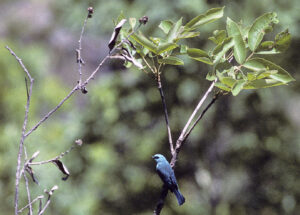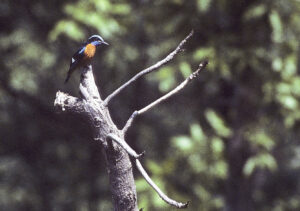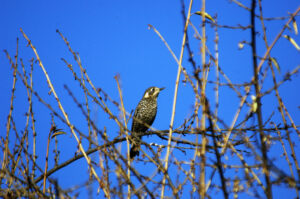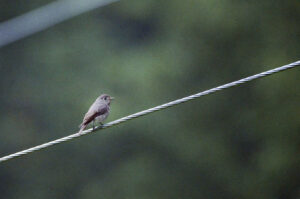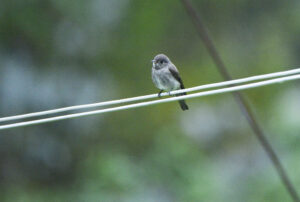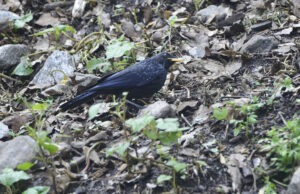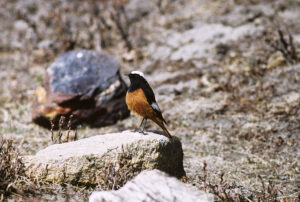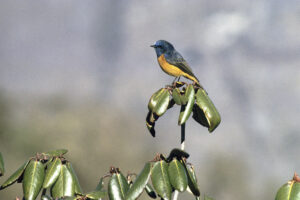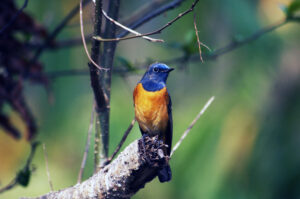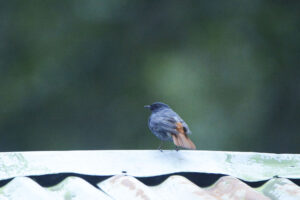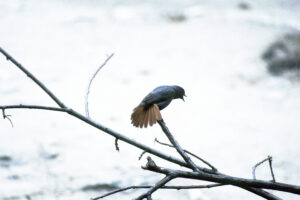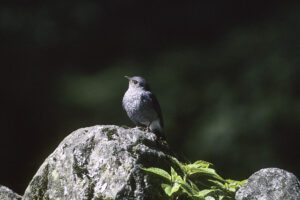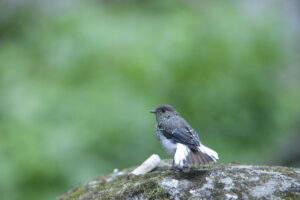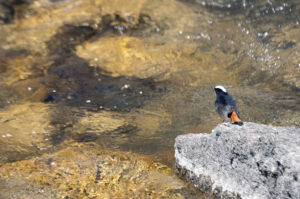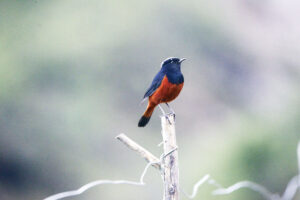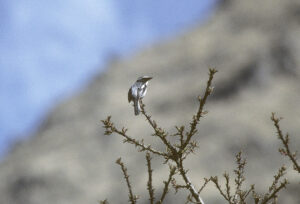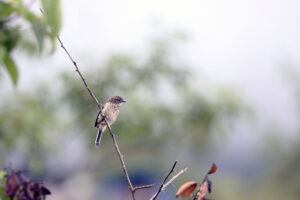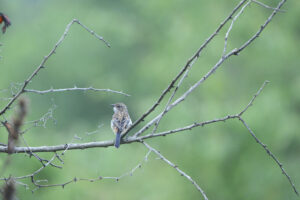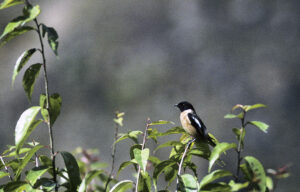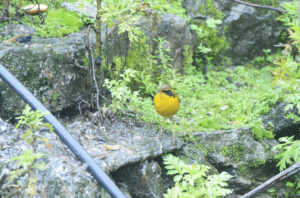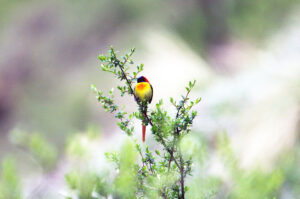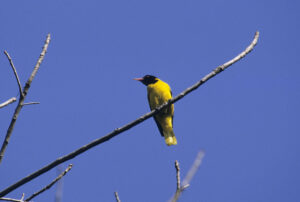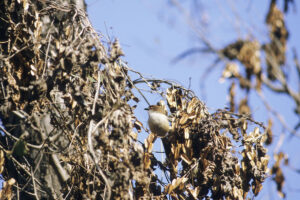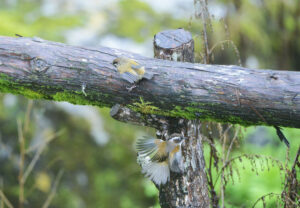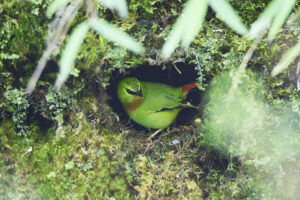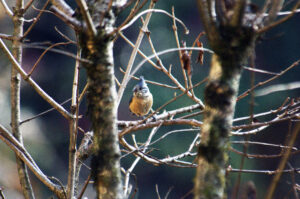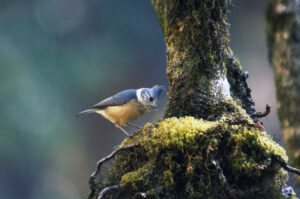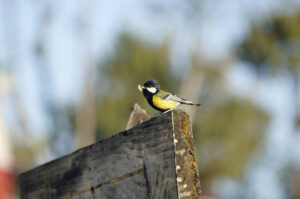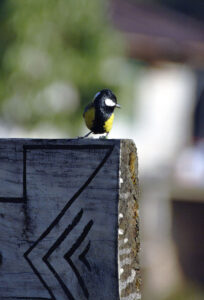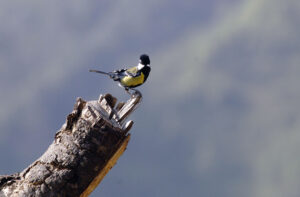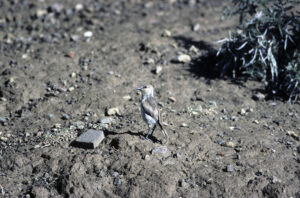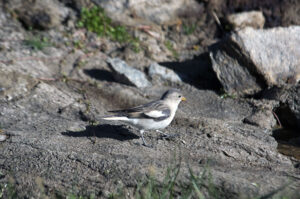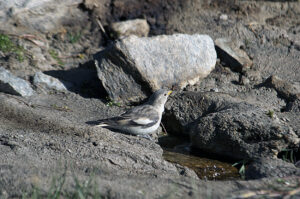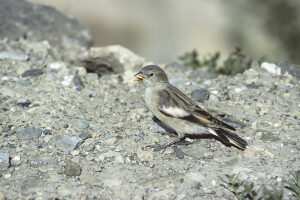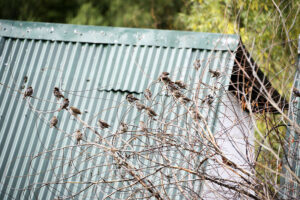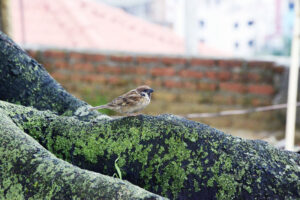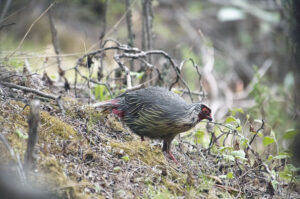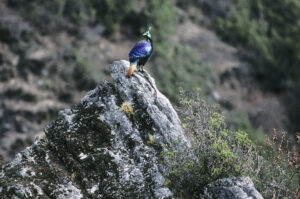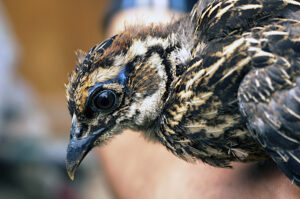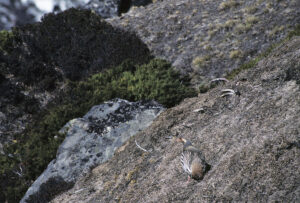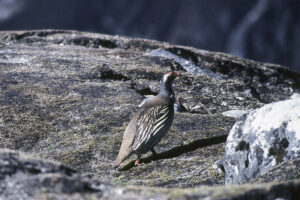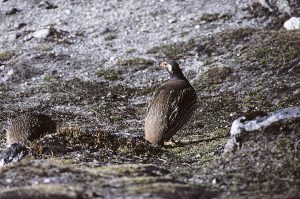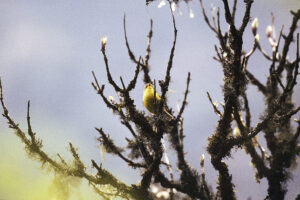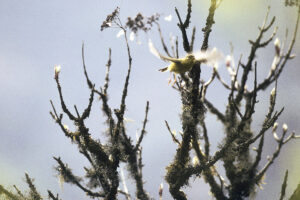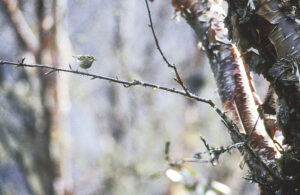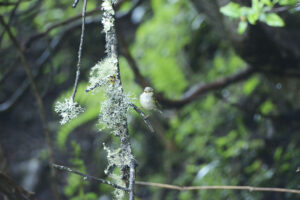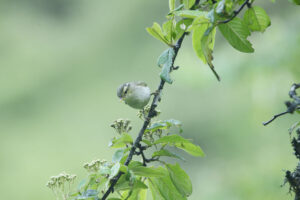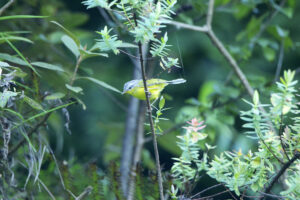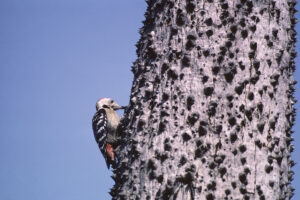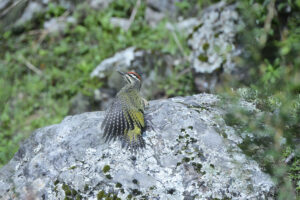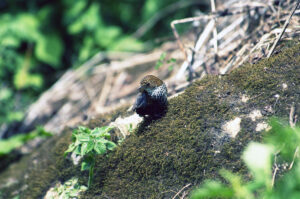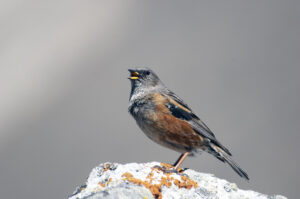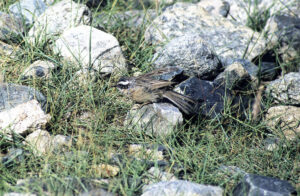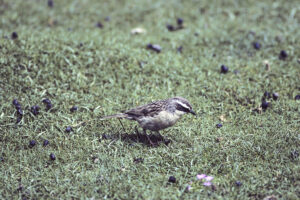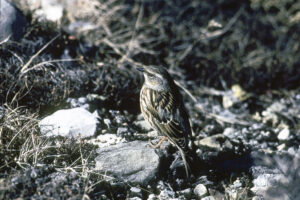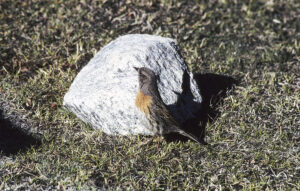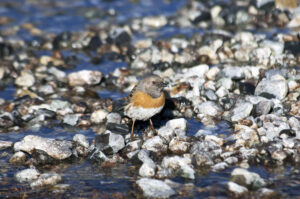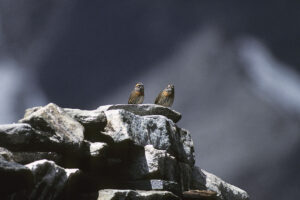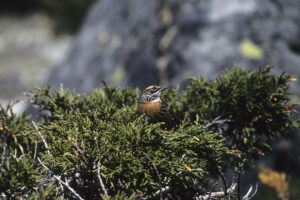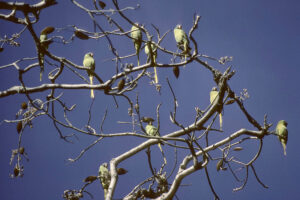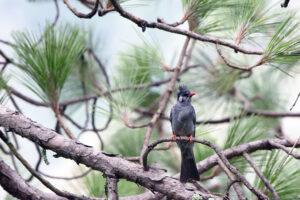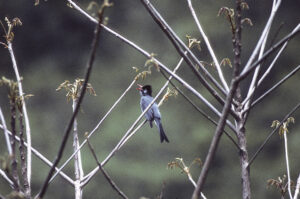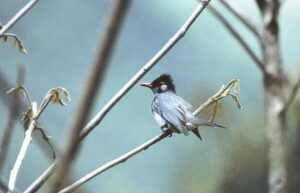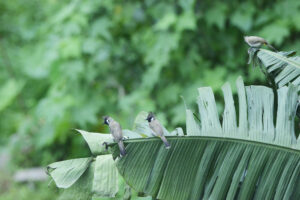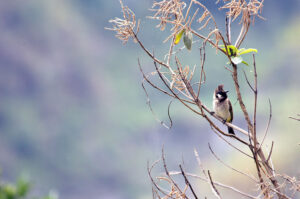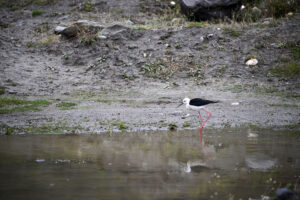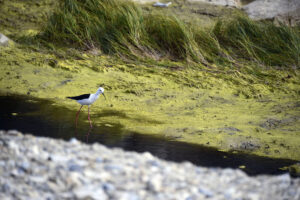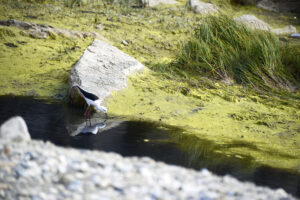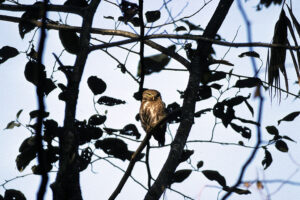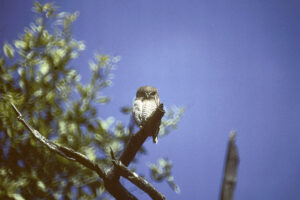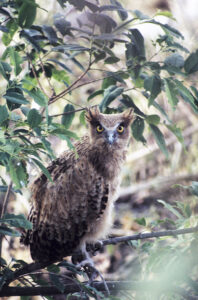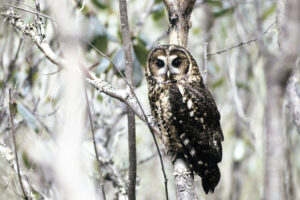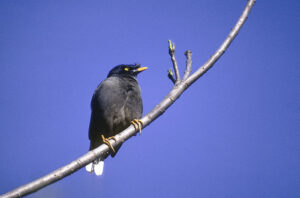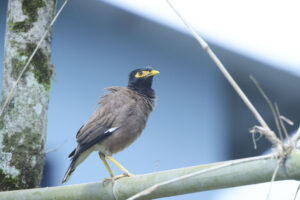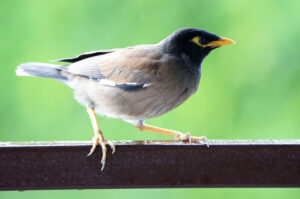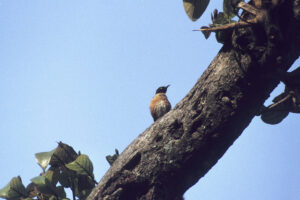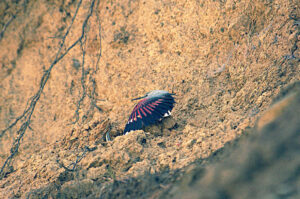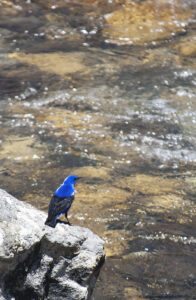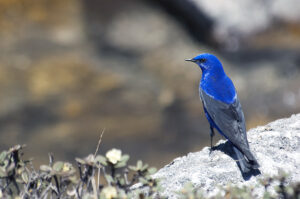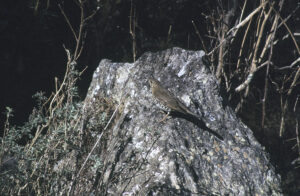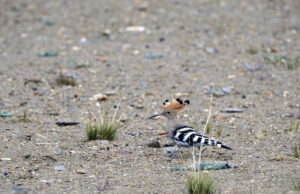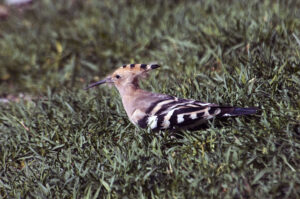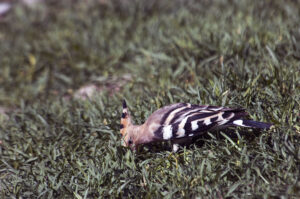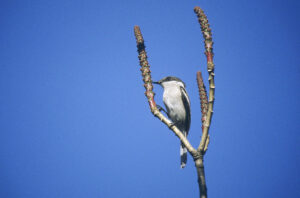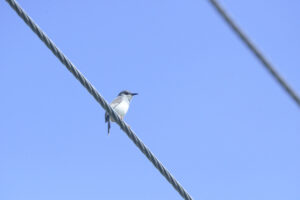Birds in the Himalaya
The ruddy shelduck (Tadorna ferruginea) is a very common breeding bird on the Tibetan Plateau. This one was observed in Lake Longapunga Tso, Gokyo Valley, Khumbu, eastern Nepal. (Photo copyright © by Kaj Halberg)
The ibisbill (Ibidorhyncha struthersii) places its nest among pebbles in broad, shallow rivers of Central Asia. This one was encountered near Kalopani in the Kali Gandaki Valley, Annapurna, central Nepal. (Photo copyright © by Kaj Halberg)
The blood pheasant (Ithaginis cruentus) was named for the plumage of the male, whose breast and rump have several blood-coloured streaks. This male was observed near Deboche, Khumbu, eastern Nepal. (Photo copyright © by Kaj Halberg)
The black-faced laughing-thrush (Trochalopteron affine) is a common resident, distributed from western Nepal eastwards to western China. This one was photographed at Gopte, Langtang National Park, central Nepal. (Photo copyright © by Kaj Halberg)
This page deals with a selection of Himalayan birds, which I have encountered during my travels. Families, genera and species are presented in alphabetical order. Nomenclature largely follows the IOC World Bird List (worldbirdnames.org).
As is obvious from most of the pictures, I prefer to depict birds in their natural surroundings, or studies of their behaviour.
Regarding the altitudinal occurrence of birds in the Himalaya, I have relied heavily on R. Grimmett, C. Inskipp & T. Inskipp, Birds of Nepal, Christopher Helm, London, 2000. This book is now out of date taxonomically, but is otherwise an excellent field guide.
The website datazone.birdlife.org has been of great use regarding the geographical distribution of the birds, whereas information about etymology is often based on J.A. Jobling, The Helm Dictionary of Scientific Bird Names, Christopher Helm, London, 2010.
In case you find any errors on this page, I would be grateful to receive an email. You may use the address at the bottom of the page.
The word Himalaya is derived from the Sanskrit hima (‘snow’) and alaya (‘abode’), thus ‘The Abode of Snow’. The Himalaya consists of a long arch of gigantic mountains, stretching from northern Pakistan southeast to the northern tip of Myanmar – a distance of more than 2,500 km. In these mountains are the Earth’s largest concentration of very high peaks, fourteen of which reach an altitude of more than 8,000 m, whereas hundreds are more than 7,000 m high. (For comparison, the highest mountain outside Central Asia, Aconcagua in Argentina, is a mere 6,962 m.)
The borders of the Himalaya are not well defined. To the northwest, the Karakoram Mountains (which some authorities consider a part of the Himalaya, others do not) merge into the Hindu Kush and Pamir Mountains. To the north and northeast, several mountain chains in Ladakh, Tibet, and China are a continuation of the Himalaya proper.
As a result of the great span in altitude and precipitation – besides various other factors such as micro-climate and soil composition – flora and fauna of the Himalaya are indeed diverse. In these mountains, two bio-geographical regions meet. In most areas, flora and fauna from the Indo-Malayan Region, which includes the Indian Subcontinent and Southeast Asia, dominate, but in northern Pakistan, Kashmir, Ladakh, and in areas of far northern Nepal and Bhutan at altitudes above c. 3,500 m, there is a large element of species from the Palaearctic Region, which includes Central and West Asia.
When the monsoon has passed over the Himalaya from the south, almost all its humidity has already fallen as rain. Thus, the Tibetan Plateau north of the mountains receives very little rainfall. In many places, the annual mean precipitation is less than 100 mm, most of which falls as snow in the winter. For this reason, the major part of the landscape is dry and rather barren, with lush and green areas mainly found along rivers and around the numerous lakes of the region.
On this page, Tibet (called Xizang by the Chinese), Qinghai, and Xinjiang are treated as separate areas. The term ‘western China’ indicates Chinese territories just east of Tibet and Qinghai. The term ‘south-western China’ includes the provinces Yunnan, Guizhou, and Sichuan.
Accipitridae Hawks, eagles, and allies
A huge family, comprising about 66 genera and c. 250 species of small to large raptors, distributed worldwide, with the exception of Antarctica.
The family name is derived from the Latin accipiter (‘hawk’), from accipere (‘to grasp’), naturally alluding to the sharp talons.
Elanus Small kites
This genus, containing 4 quite similar species of small white, grey, and black raptors, is distributed throughout almost the entire globe.
The generic name is a Latinized form of the Ancient Greek elanos (‘kite’).
Elanus caeruleus Black-winged Kite
This bird has a very wide distribution, found in all of sub-Saharan Africa, in north-western Africa, the Iberian Peninsula, France, the Nile Valley of Egypt, at several locations throughout the Middle East, from the entire Indian Subcontinent eastwards to southern China and Taiwan, and thence southwards through Indochina and the Philippines to Indonesia and New Guinea.
In the Himalaya, it may be encountered up to elevations around 1,600 m, but is commonest in the foothills.
The specific name is derived from the Latin caelum, which, strictly speaking, means ‘sky’, but is often used to indicate the colour ‘sky-blue’; and a diminutive suffix, thus loosely translated as ‘the small sky-blue one’, referring to the bluish sheen in the plumage.
Black-winged kite, Corbett National Park, Kumaon, Uttarakhand. (Photo copyright © by Kaj Halberg)
Gypaetus barbatus Lammergeier, bearded vulture
At close quarters, this huge vulture, the only member of the genus, is unmistakable, having a band of black feathers from the eye to the bill, and black feathers hanging down over the side of the bill, together forming what looks like a moustache. It was first described as Vultur barbatus (‘bearded vulture’) in 1758 by Swedish naturalist Carl Linnaeus (1707-1778).
In 1784, German physician, chemist, and naturalist Gottlieb Conrad Christian Storr (1749-1821) changed the generic name to Gypaetus, from Ancient Greek gyps (‘vulture’) and aetos (‘eagle’). Incidentally, this was an excellent observation done by Storr, as recent research has shown that the bearded vulture is no more closely related to typical vultures than to eagles.
The name lammergeier stems from the German word Lämmergeier (‘lamb-vulture’). It has its root in an old superstition that it would attack lambs. (Source: M. Everett 2008. Lammergeiers and lambs. British Birds 101 (4): 215)
This species was once very widely distributed, from large parts of Central Asia westwards across the Middle East to the Balkans, the Alps, the large Mediterranean islands, the Iberian Peninsula, and north-western Africa, and from Egypt southwards through eastern Africa to South Africa. Today, it has gone extinct in large parts of Europe and Africa, and it is only relatively common in Central Asia, including the Himalaya. It has recently been reintroduced to the Alps.
The lammergeier is restricted to montane or rocky areas, often with grassy areas and small patches of forest. In the Himalaya, it is often soaring at elevations between 1,000 and 5,000 m, rarely observed at low altitudes.
This bird has very unusual feeding habits. When other vultures have cleaned a carcass of meat, it ascends with a bone from the carcass, dropping it on rocky ground, whereupon it descends to eat the marrow of the splintered bone, and also quite large bones.
In his De Materia Medica, Greek physician, pharmacologist, and botanist Pedanius Dioscorides (died 90 A.D.) says that the stomach of the lammergeier is used against urinary stones – a credible claim, considering that its stomach acid is incredibly acid, able to digest bones completely. But how to get it into the urinary tract without harming tissue is anybody’s guess.
In some areas, the lammergeier has adapted to searching for bones in refuse dumps on the outskirts of villages and towns. This behaviour has been observed in Ethiopia, and I also once noticed it in the Jhong River Valley, Mustang, central Nepal.
Lammergeier, Jarsang Valley, Upper Marsyangdi Valley, Annapurna, central Nepal. (Photos copyright © by Kaj Halberg)
Lammergeier, Govindghat, Kumaon, Uttarakhand. (Photo copyright © by Kaj Halberg)
Gyps Griffon vultures
A genus of 8 species of carrion-eating raptors, distributed in Europe, Asia, and Africa.
The generic name is the Ancient Greek word for vultures.
Since the 1980s, most populations of vultures in the Indian Subcontinent have diminished alarmingly due to poisoning from diclofenac, a veterinary drug widely used to treat diseases in livestock. Research has shown that when the vultures feed on cattle carcasses, diclofenac will destroy their kidneys. In 2006, the Indian government announced a ban on the usage of diclofenac. Another drug, meloxicam, which seems to be a good substitute for diclofenac, is harmless to vultures. However, it is more expensive than diclofenac, and the ban has not had much effect, as it is largely ignored, probably by corrupt officials who benefit economically from the distribution of diclofenac.
Since 2016, re-introduction programmes have been instigated, primarily in nature reserves, where diclofenac is not present.
The Himalayan griffon vulture (below) is still fairly common, as it lives in the high Himalaya, where cattle cannot thrive.
The African griffon species have also decreased dramatically in numbers in recent years, described on the page Animals – Birds: Birds in Africa.
Gyps himalayensis Himalayan griffon vulture
This huge vulture lives mainly on the Tibetan Plateau, at elevations between 1,200 and 5,500 m. It is distributed from eastern Kazakhstan and Kyrgyzstan eastwards to Qinghai, and thence southwards to the higher regions of the Himalaya. Although decreasing, it is still fairly common in many places.
In former days, in Tibet, a common ‘burial’ method was to cut up deceased people and feed the meat to vultures. I once watched this practice, described on the page Travel episodes – Tibet 1987: Tibetan summer.
Himalayan griffon vulture, resting on a bluff along the Kali Gandaki River, Mustang, central Nepal. In the lower picture, the red gompa (Buddhist monastery) of Kagbeni is seen in the background. (Photos copyright © by Kaj Halberg)
Soaring Himalayan griffon vulture, Upper Marsyangdi Valley, Annapurna, central Nepal. (Photo copyright © by Kaj Halberg)
Milvus Kites
A small genus with 3 or 4 species, erected in 1799 by French naturalist Bernard Germain de Lacépède (1756-1825).
The generic name is the classical Latin name of the red kite (M. milvus).
Milvus migrans Black kite
A very widespread species, divided into 5 subspecies. It is found from central and southern Europe and northern Africa eastwards across Asia to Japan and Taiwan, and thence southwards to New Guinea and Australia.
The rather pale subspecies govinda is distributed from eastern Pakistan eastwards across warmer parts of India and Sri Lanka to Indochina and the Malacca Peninsula. It is often observed in urban areas. In the higher parts of the Himalaya, it is replaced by subspecies lineatus, which is widespread in Central and East Asia.
The specific name is derived from the Latin migrare (‘to migrate’), alluding to the northernmost populations being migratory.
The subspecific name govinda alludes to the Hindu god Krishna, an avatar (incarnation) of the mighty god Vishnu. It is told that Krishna persuaded people who lived beneath the mountain Govardhana to worship the mountain instead of the rain god Indra, as he was of the opinion that the mountain, rather than the rain god, provided them with nourishment. Indra got furious, when the people no longer worshipped him and, as a punishment, sent torrential rain in order to drown people and cattle. However, Krishna protected them by raising the mountain, so that they could seek shelter beneath it. Indra acknowledged the superiority of Krishna, giving him the name Govinda, meaning ‘protector of cattle’.
Krishna and other Hindu gods are described in depth on the page Religion: Hinduism.
Indian black kite, resting on a house roof, Pokhara, central Nepal. (Photo copyright © by Kaj Halberg)
Nisaetus Old World hawk-eagles
This genus of 10 species is found in tropical and subtropical Asia, from Pakistan eastwards to Japan and Taiwan, and thence southwards to the Philippines and Indonesia. They were earlier placed within the genus Spizaetus, which then consisted of Old World as well as New World eagles. However, genetic research has shown that the two groups are not closely related, and, consequently, the Old World species were moved to a separate genus.
The generic name is derived from Ancient Greek, from the name Nisos, and aetos (‘eagle’). Nisos was a king of Megara, who possessed a purple lock of hair, which would protect him and his kingdom. According to one version of the legend, when King Minos of Crete besieged Megara, he tempted Nisos’s daughter Scylla with a golden necklace to betray and kill her father. In another version, she fell in love with Minos from a distance, and after cutting off her father’s purple lock, she presented it to Minos. However, Minos was disgusted with her act, calling her a disgrace. As Minos’s ships set sail, Scylla attempted to climb up one of them, but Nisos, who had turned into a sea eagle, attacked her, and she fell into the water and drowned. She was changed into a bird, possibly a heron, constantly pursued by Nisos.
Nisaetus nipalensis Mountain hawk-eagle
This magnificent bird is distributed from northern Pakistan through the Himalaya eastwards to northern Myanmar, Thailand, Laos, and probably Vietnam, southern China, Taiwan, and Japan, northwards to Hokkaido. In the Himalaya, it is locally fairly common, mainly found at elevations between 1,500 and 2,900 m.
Another name of this species is Hodgson’s hawk-eagle, referring to British naturalist and ethnologist Brian Houghton Hodgson (1801-1894), who described the bird after collecting a specimen himself in the Himalaya.
Soaring mountain hawk-eagle, Mahakoma, Uttarakhand. (Photo copyright © by Kaj Halberg)
Spilornis Serpent-eagles
At least 6 species of these birds are found in forests of southern Asia. They often feed on snakes, hence their common name.
The generic name is derived from Ancient Greek spilos (‘spot’) and ornis (‘bird’), given in allusion to the white spots on breast and wings of the crested serpent-eagle (below).
Spilornis cheela Crested serpent-eagle
This eagle, comprising a large number of subspecies, is distributed from the Indian Subcontinent eastwards to southern Japan and Taiwan, and thence southwards to the Philippines and Indonesia. It is very variable, and some authorities propose treating several of the subspecies as separate species.
It is common in the lower parts of the Himalaya, up to an elevation of at least 2,100 m, and some may even stray to 3,000 m.
The specific name is derived from the Hindi word cheel (‘hawk’ or ‘kite’).
A dead tree in the Mai Khola Valley, eastern Nepal, serves as a lookout perch for this crested serpent-eagle. (Photo copyright © by Kaj Halberg)
Soaring crested serpent-eagle, Pokhara, central Nepal. (Photo copyright © by Kaj Halberg)
Aegithalidae
According to the latest revision, this family contains 4 genera with about 14 species of tiny passerines. It is a bit of a mystery to me, why the American bushtit (Psaltriparus minimus) is placed in this otherwise purely Eurasian family.
Aegithalos Bushtits, long-tailed tits
A genus with about 10 small, long-tailed birds, most of which are restricted to Central and East Asia. One species, the long-tailed tit (A. caudatus), is widely distributed, from the British Isles and Portugal eastwards to Japan.
The generic name is an ancient word, used by Greek philosopher Aristotle (384-322 B.C.) for tits.
Aegithalos concinnus Red-headed bushtit
This tiny bird, also known as black-throated bushtit, ranges from northern Pakistan eastwards across the Himalaya to northern Indochina, southern China, and Taiwan. It is common and widespread in the Himalaya, living in forested areas, mainly at elevations between 1,400 and 2,700 m.
The specific name is Latin, meaning ‘elegant’, ‘neat’, or ‘pleasing’.
Red-headed bushtit, searching for insects in a Nepalese alder (Alnus nepalensis), Dhunche, Langtang National Park, central Nepal. (Photo copyright © by Kaj Halberg)
Aegithalos iouschistos Rufous-fronted bushtit
This bird occurs in montane forests at altitudes between 2,600 and 3,700 m, from central Nepal eastwards to northern Myanmar and southern Yunnan Province.
It was described in 1845 by English zoologist Edward Blyth (1810-1873), who worked as a curator of zoology at the museum of the Asiatic Society of India in Calcutta (today Kolkata).
The specific name is derived from Ancient Greek ioeis (‘dark’) and Latin schistus (‘slate’), thus ‘dark slate-coloured’, probably alluding to the wing colour.
Rufous-fronted bushtit with fledged young, Ghora Tabela, Upper Langtang Valley, central Nepal. (Photo copyright © by Kaj Halberg)
Alaudidae Larks
This family contains 21 genera with about 100 species, distributed in Africa and Eurasia, with a single species reaching the Americas, and Australia, respectively.
Alauda
A small genus with 4 species, distributed in Eurasia and northern Africa.
The generic name is the classical Latin word for lark.
Alauda gulgula Oriental skylark
This bird, divided into about 13 subspecies, is widely distributed, from Iran and Turkmenistan eastwards to Qinghai, Gansu, and south-western Inner Mongolia, southwards across the Pamir Mountains, the Tibetan plateau, and China to south India and Sri Lanka, Indochina, and the Philippines. In the Himalaya, it is breeding in grassy areas up to an elevation of at least 3,600 m.
The specific name probably refers to the fine song of this species, derived from the Latin gula (‘throat’).
Oriental skylark, Gyantse, Tibet. (Photo copyright © by Kaj Halberg)
Calandrella
This small genus of 6 species was introduced in 1829 by German naturalist Johann Jakob von Kaup (1803-1873), who believed in a strict mathematical order in nature, classifying plants and animals based on the rather strange Quinarian system, with emphasis on the number five: it proposes that all taxa are divisible into five subgroups, and if fewer than five subgroups are known, quinarians believed that a missing subgroup remained to be found.
The generic name is a diminutive of Ancient Greek kalandros, the calandra lark (Melanocorypha calandra). Apparently, Kaup found that the type species, the greater short-toed lark (C. brachydactyla) resembled a small calandra lark.
Calandrella acutirostris Hume’s short-toed lark
This bird is distributed from north-eastern Iran and eastern Kazakhstan eastwards to the Gansu province, southwards across the Tibetan Plateau to Pakistan and along the Himalaya to northern Myanmar. It breeds in high-altitude deserts and semi-deserts, wintering in the lowlands, sometimes as far south as Maharashtra in India. It is a common breeding bird in Ladakh.
The specific name is derived from the latin acutus (‘sharp’) and rostrum (‘bill’), referring to the pointed bill. The common name commemorates British naturalist Allan Octavian Hume (1829-1912), who described the species. He was a member of the Indian Civil Service and one of the founders of the Indian National Congress. Hume has been called ‘the Father of Indian Ornithology’. He founded a journal called Stray Feathers, in which he and his subscribers recorded notes on birds from across India.
Hume’s short-toed lark, Tso Kar, Ladakh. (Photo copyright © by Kaj Halberg)
Eremophila Horned larks, shore larks
A small genus with only 2 species.
The generic name is derived from Ancient Greek eremos (‘desert’) and phileo (‘to love’), alluding to the preferred habitat of Temminck’s lark (E. bilopha), which was described in 1823 by Dutch zoologist and museum director Coenraad Jacob Temminck (1778-1858). Initially, it was placed in the genus Alauda, but both horned larks were moved to Eremophila in 1828 by German zoologist and lawyer Friedrich Boie (1789-1870).
Eremophila alpestris Horned lark
As opposed to most other larks, this species has a striking appearance, with a black stripe from the base of the bill to the eye and further down the cheek, a black breast-band, and a narrow, black, semicircular ‘crown’. In the breeding plumage, the ‘crown’ of the male is extended into two small tufts, which gave rise to the popular name.
No less than about 42 subspecies of this bird have been described. It is distributed across most of the Northern Hemisphere, along the Arctic coasts from Scandinavia eastwards to Alaska and north-eastern Canada, southwards to Mexico, with an isolated population in Columbia. It is also found in the major part of Central Asia, southwards to the Himalaya, westwards to Ukraine, the Middle East, and the Balkans, with an isolated population in the Atlas Mountains of north-western Africa. Arctic populations are migratory.
In the Himalaya, subspecies longirostris is a rather common breeding bird in Ladakh and other semi-desert areas in the northern outskirts.
Male horned lark, ssp. longirostris, Nimaling, Markha Valley, Ladakh. (Photo copyright © by Kaj Halberg)
Female horned lark, ssp. longirostris, Tso Moriri, Ladakh. (Photo copyright © by Kaj Halberg)
Alcedinidae Kingfishers
Kingfishers, comprising about 114 species of small to medium-sized, often brilliantly coloured birds, are characterized by having a large head, a long, sharp, pointed bill, and very short legs. As their name implies, most of these birds eat fish, although many species live away from water, eating mainly small invertebrates.
These birds are divided into 3 subfamilies: river kingfishers (Alcedininae), tree kingfishers (Halcyoninae), and water kingfishers (Cerylinae). One species of the former subfamily is presented on the page Animals – Birds: Birds in Taiwan, whereas members of the other two subfamilies are dealt with below.
Ceryle rudis Pied kingfisher
This species, the only member of the genus, also has a very wide distribution, found in sub-Saharan Africa and Egypt, and in Asia, from Turkey eastwards across the Middle East, the Indian Subcontinent, and Indochina to south-eastern China. In the Himalaya, it may be observed up to elevations around 1,600 m.
The generic name is derived from Ancient Greek kerylos, an unidentified bird mentioned by scientist and philosopher Aristotle (384-322 B.C.) and other authors. This bird was probably mythical, associated with the halkyon (see genus Halcyon below).
The specific name is Latin, meaning ‘rude’ or ‘uncultivated’. This strange name was applied by Swedish naturalist Fredrik Hasselquist (1722-1752) who probably confused the Latin word hispida (‘kingfisher’) with hispidus (‘rough’ or ‘rude’).
Pied kingfisher, Dal Lake, Kashmir. (Photos copyright © by Kaj Halberg)
Halcyon
A genus of 11 medium-sized kingfishers, distributed in warmer areas of Africa and Asia.
The generic name is associated with a bird of Greek legend, called Halcyon, generally thought to be the common kingfisher (Alcedo atthis). The Ancients believed that this bird made a floating nest in the Aegean Sea and had the power to calm the waves while brooding her eggs. Two weeks of calm weather were to be expected when the Halcyon was nesting, which took place around winter solstice. These Halcyon days were generally regarded as beginning on the 14th or 15th of December.
This belief in the bird’s power to calm the sea originated in a myth recorded by Roman poet Publius Ovidius Naso (43 B.C. – c. 17 A.D.), known as Ovid. The story goes that Aeolus, ruler of the winds, had a daughter named Alcyone, who was married to Ceyx, the king of Thessaly. Ceyx drowned at sea, and in her grief, Alcyone threw herself into the waves. However, instead of drowning, she was transformed into a bird and carried to her husband by the wind. (Source: phrases.org.uk)
Halcyon smyrnensis White-breasted kingfisher, white-throated kingfisher
This bird is widely distributed in Asia, from Turkey eastwards to the Philippines. In the Himalaya, it is common below an elevation of 1,000 m, but may occasionally be observed up to around 1,800 m.
The specific name refers to the Ancient Greek city of Smyrna, now called Izmir, in what is today western Turkey. Initially, Swedish naturalist Carl Linnaeus (1707-1778) named this bird Alcedo smyrnensis, citing the work A natural history of birds : illustrated with a hundred and one copper plates, curiously engraven from the life (1731-1738), by English naturalist and illustrator Eleazar Albin (c. 1690-1742), which includes a description and an illustration of the Smirna kingfisher.
White-breasted kingfisher, photographed at Dal Lake, Kashmir. (Photo copyright © by Kaj Halberg)
Anatidae Ducks, geese, and swans
At present, this large family contains 43 genera with about 146 species, distributed almost worldwide. The family name is derived from anas, the classical Latin word for duck.
Anser Grey geese
A genus of 11 species, distributed in arctic, subarctic, and temperate areas of the Northern Hemisphere.
The generic name is the classical Latin term for geese.
Anser indicus Bar-headed goose
This goose is easily identified by its white head, a white vertical band down the side of the otherwise grey neck, and two black bars on the back of the head. It is a common breeding bird at high-altitude lakes at scattered locations across Central Asia, spending the winter in the Indian Subcontinent, as far south as Karnataka. It is a common breeder in Ladakh.
The bar-headed goose is a common breeding bird in Lake Tso Moriri, Ladakh. This picture shows a pair with a half-grown gosling. (Photo copyright © by Kaj Halberg)
A pair of bar-headed goose shows aggressive behaviour towards another pair, Tso Moriri. (Photo copyright © by Kaj Halberg)
On their way to the breeding area on the Tibetan Plateau, these bar-headed geese have made a stop-over to rest in Longapunga Tso, an alpine lake in Gokyo Valley, Khumbu, eastern Nepal. (Photos copyright © by Kaj Halberg)
Mergus Mergansers
Mergansers are 4 species of fish-eating ducks, of which two, the common merganser (below) and the red-breasted merganser (M. serrator), are widely distributed across the Northern Hemisphere, whereas the Brazilian merganser (M. octosetaceus) and the scaly-sided merganser (M. squamatus) of China are highly endangered.
The generic name is a Latin word, used by Roman naturalist Pliny the Elder (23-79 A.D.) as the name of an unspecified waterbird.
Previously, two other ducks were included in the genus, the hooded merganser, now called Lophodytes cucullatus, and the smew, today named Mergellus albellus. Research has shown that they are not closely related to mergansers.
Mergus merganser Goosander, common merganser
The goosander, in America called common merganser, nests in holes in trees. It is found in rivers and lakes in forested areas of Europe, northern and central Asia, and North America, as far south as the central Rocky Mountains, Pennsylvania, the Alps, the southern part of the Tibetan Plateau, and north-eastern China. Northern populations are migratory. It is a rather common winter visitor to the Himalaya, observed at elevations up to 3,000 m.
The specific name is a concoction of the generic name and the Latin anser (‘goose’).
Female common merganser, resting on a stone in the Modi Khola River, near Landruk, Annapurna, central Nepal. (Photo copyright © by Kaj Halberg)
Tadorna Shelducks
A small genus of 6 species of large ducks, distributed in Eurasia, Africa, Australia, and New Zealand. One species, the crested shelduck (T. cristata) of Korea, may have gone extinct.
The generic name is derived from tadorne, the French name of the common shelduck (T. tadorna). It may have Celtic roots, meaning ‘pied waterfowl’. The English name, originally sheld duck, dates from around 1700, with a similar meaning.
Tadorna ferruginea Ruddy shelduck, Brahminy duck
The specific name of this colourful bird is Latin for ‘rusty’, referring to the plumage, which is mainly orange-brown. The head is paler, and tail and flight feathers are black, contrasting with the white wing-coverts. In India, this bird is known as Brahminy duck, likewise alluding to its colour, which resembles that of the robe of certain Brahmins (the uppermost caste of Hinduism).
This is essentially a Central Asian species, with breeding populations extending across the Middle East as far as south-eastern Europe, with isolated populations in north-western Africa and the highlands of Ethiopia. It is very common on the Tibetan Plateau. In the Himalaya, it breeds in several alpine lakes.
The ruddy shelduck is a very common breeding bird on the Tibetan Plateau. This pair was observed in a reservoir in the town of Gyantse. (Photo copyright © by Kaj Halberg)
The ruddy shelduck breeds in several alpine lakes in the Himalaya. This bird is feeding on insects in Gokyo Lake, Gokyo Valley, Khumbu, eastern Nepal. (Photo copyright © by Kaj Halberg)
In autumn, the birds from the Tibetan Plateau migrate to the lowlands of China and India. These birds were photographed in Lake Cao Hai, Guizhou Province, China. (Photos copyright © by Kaj Halberg)
Apodidae Swifts
This family contains about 19 genera and 113 species of fast-flying birds, adapted to catching insects in the air. They are superficially similar to swallows, but are not even distantly related to them, the resemblance being a result of convergent evolution due to similar life styles.
Apus Typical swifts
A genus with about 20 species, distributed in Eurasia and Africa, and on islands in the Pacific Ocean.
The generic name is the classical Latin word for swifts, derived from Ancient Greek a (‘without’) and pous (‘foot’). Due to the tiny, weak legs of these birds, the Ancients believed that they were a type of swallow without feet.
Apus nipalensis House swift
Previously, it was thought that the most common swift of East and Southeast Asia was a subspecies of the widespread little swift (Apus affinis). Today, however, birds distributed from Nepal eastwards to Japan, and thence southwards through Indochina and Malaysia to Indonesia and the Philippines, are generally regarded as a separate species.
It is very common in Nepal, at all seasons encountered up to elevations around 1,000 m, in summer up to about 2,100 m.
House swifts, feeding among houses, Bandipur, central Nepal. (Photo copyright © by Kaj Halberg)
House swifts at their breeding site in Bandipur, a hole in a wall. (Photos copyright © by Kaj Halberg)
Ardeidae Herons, egrets, and bitterns
Herons comprise about 64 species of long-legged and long-beaked, fish-eating water birds, distributed almost worldwide. Some species are called egrets, mainly birds with ornate plumes during the breeding season, whereas birds of the genera Botaurus, Ixobrychus, and Zebrilus are called bitterns.
Ardeola Pond herons
A genus of 6 species of small herons, most of which are found in tropical areas of Asia and Africa. One species, the squacco heron (A. ralloides), breeds in southern Europe and the Middle East, migrating to Africa in autumn.
Most of the year, the plumage of these birds is buff or brownish, making them extremely well camouflaged among various types of vegetation. When they take to flight, however, they are transformed as if by magic, when their brilliant white wings are displayed.
The generic name is composed of ardea, the Latin word for heron, and ola, a suffix denoting something diminutive, thus ‘small heron’.
Ardeola grayii Indian pond heron, paddy bird
This bird breeds from southern Iran eastwards to the Indian Subcontinent and Myanmar. It is a very common resident in the lower parts of the Himalaya up to altitudes around 1,500 m, but has strayed to an elevation of 2,700 m.
It is easily overlooked in its drab winter plumage when standing at the edge of lakes, ponds, or paddy fields. It relies on its camouflage to a degree that it can be approached closely before taking to flight. This behaviour gave rise to the Hindi name andha bagla (‘blind heron’), as well as the Sri Lankan name kana koka (‘half-blind heron’).
Formerly, this bird was shot for meat. In his book A New Account of the East Indies, from 1744, Alexander Hamilton writes the following: “They have also store of wild fowl; but who have a mind to eat them must shoot them. Flamingoes are large and good meat. The paddy-bird is also good in their season.”
The specific name honours British zoologist John Edward Gray (1800-1875), who was keeper of zoology at the British Museum in London 1840-1874, until the natural history department was re-named the Natural History Museum.
Stone fence with a resting Indian pond heron, Jamuna, Ilam, eastern Nepal. (Photo copyright © by Kaj Halberg)
Indian pond heron, resting on a floating waterlily stem (Nymphaea), Dal Lake, Kashmir. (Photo copyright © by Kaj Halberg)
Preening Indian pond heron, Dal Lake. (Photos copyright © by Kaj Halberg)
Bubulcus ibis Cattle egret
This species is very widely distributed, found in most warmer areas of the world, only avoiding rain forests and desert areas. Originally, it was native to southern Spain and Portugal, the northern half of Africa, and across the Middle East and the Indian Subcontinent eastwards to Japan, and thence southwards to northern and eastern Australia.
However, in the late 1800s it began expanding its range into southern Africa, and in 1877 it was observed in northern South America, having apparently flown across the Atlantic Ocean. By the 1930s, it had become established as a breeding bird in this area, rapidly spreading to North America, where it is now found as far north as southern Canada. In later years, it has also spread northwards in Europe.
As its name implies, it often follows cattle to snap grasshoppers and other small animals, flushed by the grazers. It is also often observed in newly ploughed fields. The generic name is Latin, meaning ‘cowherd’. The specific name is the Ancient Greek term for ibises. Why it was applied to the cattle egret is not clear.
Today, some authorities split the cattle egret into two species, the western (B. ibis) and the eastern (B. coromandus). Apart from minor differences, they are identical, so why this split was made, is incomprehensible. I prefer to regard all cattle egrets as a single species.
Previously, a large breeding colony of cattle egrets was found in the heart of Kathmandu, close to the new Royal Palace. In later years, however, I haven’t been able to locate this colony, but a rather large colony is present in the suburb Banepa.
Cattle egrets, Kathmandu. (Photos copyright © by Kaj Halberg)
Cattle egrets, bringing sticks to their nest, Kathmandu. The climber in the upper picture is purple morning-glory (Ipomoea purpurea). (Photos copyright © by Kaj Halberg)
Young cattle egret in the nest, Banepa. (Photo copyright © by Kaj Halberg)
Young cattle egrets, begging for food, Kathmandu (top), and Banepa. (Photos copyright © by Kaj Halberg)
Columbidae Pigeons and doves
A large family with about 50 genera and c. 345 species. The word pigeon generally denotes larger species, dove smaller species. These birds are found on all continents except Antarctica.
Columba
A rather large genus with about 35 species, widely distributed in the Old World. Previously, a number of American pigeons were placed in this genus, but they have been moved to a separate genus, Patagioenas.
The generic name is Latin, meaning ‘dove’, the feminine form of columbus (‘male dove’), a Latinized version of Ancient Greek kolumbos (‘diver’). This name was applied by Greek comic-writer Aristophanes (c. 446-386 B.C.) to the rock pigeon (below), due to the ‘swimming’ motion made by its wings in flight.
Columba leuconota Snow pigeon
As its name implies, this bird lives in cold regions. It is very common in higher mountains, from Afghanistan eastwards along the Himalaya to the Yunnan Province, northwards across the Tibetan Plateau to Qinghai. In the Himalaya, it has been noticed up to an elevation of 5,700 m. In harsh winter weather, it may descend to around 1,500 m.
The specific name is derived from Ancient Greek leukos (‘white’) and noton (‘back’).
Snow pigeons, preening on a rock in morning mist, Thangshyap, Langtang Valley, central Nepal. (Photo copyright © by Kaj Halberg)
Portrait of a snow pigeon, Thangshyap. (Photo copyright © by Kaj Halberg)
Snow pigeons, feeding in a ploughed field, Namche Bazaar, Khumbu, eastern Nepal. (Photo copyright © by Kaj Halberg)
Snow pigeons, resting on a rock, Namche Bazaar. (Photo copyright © by Kaj Halberg)
Outside the breeding season, snow pigeons move about in large flocks, here at Ghumtarao, Great Himalayan National Park, Himachal Pradesh (3 upper pictures), and near the village of Bharku, Langtang Nationalpark, central Nepal. (Photos copyright © by Kaj Halberg)
Columba livia Rock pigeon
It is believed that in the wild, this species was originally found in southern Europe, northern Africa, and from the Middle East eastwards to Afghanistan and India, with isolated populations in Ireland, Scotland, the Faroe Islands, the Azores, Madeira, the Canary Islands, and the Cape Verde Islands.
However, the bird was domesticated at a very early stage, and it has been brought to almost every corner of the world. Over time, more than a thousand breeds have evolved. In numerous cities around the world, birds have escaped to form huge feral populations. Feeding these birds is often a very popular occupation, despite the fact that they are a nuisance, dropping their guano everywhere, and maybe also spreading contagious diseases.
The specific name stems from Theodore Gaza’s work from 1476, Aristotelis de natura animalium, in which he translates the classical Greek word for dove, peleia (probably derived from pellos = ‘dark-coloured’), into livia, derived from the Latin livens (‘lead-coloured’), ultimately from livere (‘being bluish’).
Several pictures, depicting this bird, are shown on the page Animals: Urban animal life.
Feeding feral pigeons on Durbar Square, Kathmandu, Nepal. (Photo copyright © by Kaj Halberg)
Warmly dressed on a chilly spring morning, a little boy has fun chasing feral pigeons on Durbar Square. (Photo copyright © by Kaj Halberg)
Feral pigeons, feeding on offerings of rice on ‘The Sleeping Vishnu’, a 6-metre-long sculpture, depicting the Hindu god Vishnu, reclining in the Cosmic Ocean, resting on a somewhat unusual bed, consisting of the 11-headed serpent Anantha Naga. – Budhanilkantha, Kathmandu. (Photo copyright © by Kaj Halberg)
Columba rupestris Hill pigeon
Very similar to the rock pigeon (above), but may be identified by the tail, which has a broad white band, contrasting with a black terminal band. It is distributed from Uzbekistan and Tajikistan eastwards across Mongolia to north-eastern China, southwards to the northern outskirts of the Himalaya, south-western China, and Korea.
The specific name is derived from the Latin rupes (‘rock’ or ‘cliff’), alluding to the main habitat of the bird.
Hill pigeon, observed on the mountain pass Tso La, east of Lhatze, Tibet. The cairns in the upper picture mark the peak of the pass. (Photos copyright © by Kaj Halberg)
Streptopelia Turtle doves
A genus of c. 13 species of small to medium-sized doves, most of which are found in Africa, with several species in tropical and subtropical Asia, one of which, the oriental turtle dove (below), is also found in temperate areas of Asia, whereas another, the collared dove (S. decaocto), has expanded its distribution area to the Middle East and the entire Europe. This expansion is described on the page Animals: Urban animal life.
The generic name is derived from Ancient Greek streptos (literally meaning ‘twisted’, but in this connection ‘wearing a torc’, a twisted metal collar, alluding to the semi-collar of many members of the genus), and peleia (‘dove’).
Other species, which were formerly placed in this genus, have been moved to the genera Spilopelia and Nesoenas.
Streptopelia orientalis Oriental turtle dove
This species is widely distributed, from the southern Ural Mountains, Kazakhstan, and Afghanistan eastwards to the Pacific Ocean, and from the Indian Subcontinent eastwards through Indochina and China to Taiwan and Japan. It breeds in forests, along forest edges, and in parks and larger gardens. In the Himalaya, it may ascend to about 4,500 m in summer, usually wintering below 2,000 m.
Oriental turtle dove, Changdam (top), and Thangshyap, both Langtang Valley, central Nepal. (Photos copyright © by Kaj Halberg)
Oriental turtle dove, feeding in a gutter in the town of Kielang, Lahaul, Himachal Pradesh. (Photos copyright © by Kaj Halberg)
Corvidae Crows and allies
This almost cosmopolitan family, which constitute the largest passerines, contains 24 genera with more than 120 species of ravens, crows, rooks, jackdaws, jays, magpies, treepies, choughs, nutcrackers, and others.
Corvus Ravens, crows, rooks
A genus with about 45 species, with members occurring in virtually all temperate areas of the globe, with the exception of South America. They are among the most intelligent birds. The term raven applies to the largest species, crow and rook to slightly smaller species.
The generic name is the classical Latin term for raven.
Previously, jackdaws were also placed in this genus. Following genetic research, they have been moved to a separate genus, Coloeus.
Corvus corax Common raven
The most widespread member of the family, the common raven occurs in almost all arctic and temperate areas of the Northern Hemisphere. In the Himalaya, it is a common resident, mainly at altitudes between 3,500 and 5,000 m.
Due to its intelligent behaviour, this bird appears in several mythologies across Eurasia. In Norse mythology, two ravens, Hugin (‘thought’) and Munin (‘memory’), were the servants of the supreme god Odin, bringing news to him from all over the world.
The specific name is the classical Greek word for the common raven.
Common raven, Markha Valley, Ladakh. (Photo copyright © by Kaj Halberg)
Corvus macrorhynchos Large-billed crow
In former days, this species was called jungle crow, a name that also included two other crows, which some authorities today treat as separate species, the Indian jungle crow (C. culminatus) and the eastern jungle crow (C. levaillantii). They are extremely similar, so why these splits were made, is a mystery to me.
In its widest sense, including the two splits, this bird is found from Afghanistan and the entire Indian Subcontinent eastwards to south-eastern Siberia (Ussuriland) and Japan, and thence southwards through Indochina and the Philippines to Indonesia. It lives in a wide variety of habitats, including forests, rocky areas, cultivated land, and along rivers. In the Himalaya, it is found up to an elevation of at least 3,000 m.
The large-billed crow is quite similar to the common raven (above), but, besides its smaller size, it may be identified by the slimmer bill and the steeper ‘forehead’.
The specific name is derived from Ancient Greek makros (‘long’) and rhynkhos (‘bill’).
Large-billed crow, Gopte, Langtang National Park, central Nepal. (Photo copyright © by Kaj Halberg)
The large-billed crow is often encountered near human habitation, in this case on a house roof in the village of Namche Bazaar, Khumbu, eastern Nepal. The bird is sucking up the heat of the morning sun, while humidity is evaporating from its feathers. (Photo copyright © by Kaj Halberg)
Large-billed crow, calling from the top of a Himalayan silver fir (Abies spectabilis), Namche Bazaar, Khumbu, eastern Nepal. (Photo copyright © by Kaj Halberg)
Calling large-billed crow, Corbett National Park, Kumaon, Uttarakhand. (Photo copyright © by Kaj Halberg)
Large-billed crow, sitting on a cow, Mundo, Langtang Valley, central Nepal. (Photo copyright © by Kaj Halberg)
Dendrocitta Treepies
Members of this genus of long-tailed corvids, comprising 7 species, are resident in tropical and subtropical areas, from the Indian Subcontinent eastwards to southern China and Taiwan, and thence southwards through Indochina to Sumatra and Borneo.
The generic name is derived from Ancient Greek dendron (‘tree’) and kissa, which was the classical Greek name of the common jay (Garrulus glandarius), but also refers to magpies in general. The word pie is of Indo-European origin, meaning ‘pointed’, referring to the long, pointed tail of these birds.
Dendrocitta formosae Grey treepie
This species, also called Himalayan treepie, is distributed from Pakistan eastwards along the Himalaya and through northern Indochina and southern China to Taiwan. It is common in forests of the Himalaya, in summer encountered up to elevations around 1,100 m in Pakistan, further east gradually higher, and in the eastern part of the mountains up to about 2,300 m. In winter, it descends to milder climatic conditions.
In 1544, when the Portuguese first saw Taiwan from the sea, they named it Formosa (‘beautiful’). Since then many plants and animals, which were described from specimens collected on the island, were named various forms of this word.
Grey treepies, Dhulikhel, near Kathmandu. (Photo copyright © by Kaj Halberg)
Nucifraga Nutcrackers
A small genus of 2-3 species. The spotted nutcracker (below) is widespread in Europe and Asia, with one subspecies, the Kashmir nutcracker, recognized by some authorities as a distinct species, N. multipunctata, found in the western part of the Himalaya. The third species, Clark’s nutcracker (N. columbiana), lives in western North America.
The most important food item for these birds are seeds of various pines (Pinus), which they break open with their powerful bill. This fact is reflected by the generic name, which is derived from the Latin nuci (‘nut’) and frango (‘to break’).
When pine nuts are abundant, they make caches of surplus seeds, storing as many as 30,000 in a single season. They are able to remember the location of as many as about 70% of their stash, even when buried in snow. They often store the nuts far away from where they were collected, and are thus important in re-establishing forests in logged or burned areas. (Source: D.F. Tomback 2016, in Why birds matter: avian ecological function and ecosystem services, edited by Sekercioglu, Wenny & Whelan, University of Chicago Press)
In regions without pine trees, seeds of spruce (Picea) and hazelnuts (Corylus) form an important part of the diet.
Nucifraga caryocatactes Spotted nutcracker
This bird has a very wide distribution, from southern Norway eastwards in a broad belt across the Siberian taiga to Kamchatka, Korea, and Japan, and also in several montane areas of central Europe, in the Himalaya, in western and northern China, and in Taiwan.
The plumage of this bird is quite variable, and as many as 9 subspecies have been described. In the Himalaya, 3 subspecies occur: multipunctata, by some recognized as a separate species, found in northern Kashmir, northern Pakistan, and eastern Afghanistan; hemispila, distributed from southern Kashmir eastwards to western Nepal; and macella, which lives from western Nepal eastwards to northern Myanmar and the Yunnan Province.
The specific name has the same meaning as the generic name, but is derived from Ancient Greek karyon (‘nut’) and kataseio (‘to shatter’).
Spotted nutcracker, subspecies macella, Ghora Tabela (top), and between Sherpagaon and Surkhe, both Langtang Valley, central Nepal. (Photos copyright © by Kaj Halberg)
Spotted nutcracker, subspecies macella, resting in a blue pine (Pinus wallichiana), Ringmo, Solu, eastern Nepal. (Photo copyright © by Kaj Halberg)
Pica Magpies
In the past, only 2 species were recognized in this genus, the black-billed magpie (Pica pica) of Eurasia and western North America, and the yellow-billed magpie (P. nuttalli), which is restricted to California.
However, following genetic research it has been suggested that the former black-billed magpie should be split into a number of separate species, the Eurasian magpie (P. pica), the Maghreb magpie (P. mauritanica) of North Africa, the Asir magpie (P. asirensis) of south-western Saudi Arabia, the Oriental magpie (P. serica) of eastern and southern China, Taiwan, and northern Indochina, the black-rumped magpie (P. bottanensis) of west-central China and the north-eastern Himalaya, and the black-billed magpie (P. hudsonia) of western North America. They are all very much alike, so why this split was made is a mystery to me, and I prefer to regards these magpies as subspecies of a single species.
The generic name is the classical Latin name of the magpie, derived from the Latin picata, which, strictly speaking, means ‘smeared with tar’, but in a wider sense ‘black-and-white’.
The word pie is of Indo-European origin, meaning ‘pointed’, in this case no doubt referring to the long, pointed tail of these birds. The prefix mag dates from the 16th Century, a short form of the name Margaret, which was a term used for women in general. The call of the bird was likened to the chattering of women, and so it was called mag-pie. (Source: etymonline.com/word/magpie)
The role of the magpie in European folklore is related on the page Animals: Urban animal life.
Pica pica Common magpie
This bird, comprising about 11 subspecies, is found all over Europe, and thence eastwards in a broad belt across temperate areas of Asia to the Pacific coast in north-eastern Siberia, and further on into western North America. The southern limits are north-western Africa, south-western Iran, Ladakh, north-eastern India, northern Indochina, Hainan Island, Taiwan, and south-western United States.
As described above, some subspecies have been upgraded to separate species by some authorities.
The distribution of subspecies bactriana, called Russian magpie, just reaches northern Pakistan and Ladakh. The subspecific name refers to Bactriana, in Persian Bakhtar, an ancient region north of the Hindu Kush Mountains and south of the Amu Darya River, covering a flat region in present-day Afghanistan, Tajikistan, and Uzbekistan. The black-rumped magpie, subspecies bottanensis, is found in Bhutan and Arunachal Pradesh.
Russian magpie, subspecies bactriana, Shey Palace, Ladakh. (Photo copyright © by Kaj Halberg)
Russian magpie, sitting on a chorten (a Tibetan Buddhist shrine, similar to a stupa), Thikse Gompa, Ladakh. Chortens and gompas are described on the page Religion: Buddhism. (Photo copyright © by Kaj Halberg)
Pyrrhocorax Choughs
This genus consists of only two species of smaller, jet-black corvids, which are easily identified by their brightly coloured bill and feet, and by their calls, one of which has given them their English name. They are master navigators in the air, and you often observe them in large flocks, swooping and diving, while calling incessantly – obviously showing sheer pleasure of flying.
The generic name is derived from Ancient Greek pyrrhos (‘flame-coloured’), from pyr (‘fire’), and korax (‘raven’), presumably alluding to the bright red bill of the red-billed chough.
Pyrrhocorax graculus Alpine chough, yellow-billed chough
This is the smallest of the two choughs, having a bright yellow bill and reddish feet. It is widely distributed, found in Morocco, the Pyrenees, the Alps, and other Central European mountains, in Italy and the Balkans, on Crete, and in Turkey, the Caucasus, the Alborz Mountains of Iran, and in the Himalaya and other nearby Central Asian mountains.
It is very common in the Himalaya, generally found at higher altitudes than the red-billed chough (below).
The specific name was the classical Latin word for an unidentified bird, which later authors identified as the jackdaw (Coloeus monedula). Perhaps it refers to the fact that this bird is small, just like the jackdaw.
Alpine choughs, Annapurna Base Camp, Upper Modi Khola Valley, central Nepal. (Photos copyright © by Kaj Halberg)
Alpine choughs are often confiding. This bird was photographed outside a restaurant in the hamlet of Tughla, Khumbu, eastern Nepal. (Photo copyright © by Kaj Halberg)
Alpine choughs, soaring over the Upper Ghunsa Valley, eastern Nepal. (Photo copyright © by Kaj Halberg)
Pyrrhocorax pyrrhocorax Red-billed chough
This bird is a bit larger than the Alpine chough, with a longer, bright red bill. It is quite common in the Himalaya and large parts of Central Asia, and is also widespread across the Middle East and in Europe, where it is found in Ireland, Wales, France, the south-western Alps, Italy, the Balkans, and large parts of the Iberian Peninsula. In Africa, it occurs in the Atlas Mountains of Morocco, in Tunisia, in the highlands of Ethiopia, and on the Canarian island La Palma.
Feeding red-billed chough, Deboche, Khumbu, eastern Nepal. (Photos copyright © by Kaj Halberg)
Red-billed chough, Namche Bazaar, Khumbu, eastern Nepal. (Photo copyright © by Kaj Halberg)
Urocissa Blue magpies
This genus contains 5 species of gorgeously coloured birds, distributed in the Indian Subcontinent, Indochina, southern China, and Taiwan. One species is described below, two others on the page Animals – Birds: Corvids.
These birds feed mainly on large insects and other invertebrates, and on various fruits, but are also notorious plunderers of eggs and young from smaller birds’ nests.
The generic name is derived from Ancient Greek oura (‘tail’) and kissa, which, originally, was the name of the jay (Garrulus glandarius), but could also refer to magpies in general, thus ‘long-tailed magpie’.
Urocissa flavirostris Yellow-billed blue magpie
This species is distributed along the Himalaya, from Afghanistan to northern and western Myanmar, with a disjunct population in northern Vietnam, in the breeding season usually encountered at altitudes between 1,500 and 3,000 m, moving to slightly lower elevations in the winter.
The specific name is Latin, meaning ‘yellow-billed’.
Yellow-billed blue magpie, Tharke Ghyang, Helambu, central Nepal. (Photo copyright © by Kaj Halberg)
Calling yellow-billed blue magpie, Changdam, Langtang National Park, central Nepal. (Photo copyright © by Kaj Halberg)
Yellow-billed blue magpie in rainy weather, Manali, Himachal Pradesh. (Photo copyright © by Kaj Halberg)
Yellow-billed blue magpie, Benkar, Khumbu, eastern Nepal. In the upper picture, a gust of wind is ruffling its feathers. (Photos copyright © by Kaj Halberg)
Cuculidae Cuckoos
This family contains about 30 genera of mainly brood-parasitic birds, distributed almost worldwide.
Cuculus Typical cuckoos
A genus with about 11 species, all brood-parasites.
The generic name is the classical Latin word for cuckoos.
Cuculus poliocephalus Lesser cuckoo
As a breeding bird, this species is distributed from the entire Himalaya eastwards across northern Indochina and the major part of China to Korea, south-eastern Siberia (Ussuriland), and Japan. It is resident on Taiwan and Hainan, whereas other populations migrate to spend the winter in southern India, Sri Lanka, and eastern Africa. In the Himalaya, it is mainly found at elevations between 1,500 and 3,600 m.
This bird is very noisy during the breeding season, with a distinctive chattering call of 5 to 6 notes, rendered as ‘That’s your choky pepper … choky pepper’ (accent on the first choky), or pretty-peel-lay-ka-beet. It lays its eggs in the nests of babblers, warblers, and other small birds. (Source: indiabiodiversity.org)
The specific name is derived from Ancient Greek polios (‘grey’) and kephale (‘head’).
Lesser cuckoo, Shyabru, Langtang National Park, central Nepal. (Photo copyright © by Kaj Halberg)
Lesser cuckoo, female rufous phase, Riverside, Langtang Valley, central Nepal. (Photos copyright © by Kaj Halberg)
Dicruridae Drongos
This family contains only a single genus, Dicrurus, with altogether about 30 species, of which 8 have been observed in the Himalaya. The plumage of most species is black, often with a sheen. Several species are excellent imitators, one example described on the page Quotes on Nature.
The generic name is derived from Ancient Greek dikros (‘forked’) and oura (‘tail’), referring to the forked tail of these birds.
In Australia, the common name is slang for foolish or stupid people. It stems back from the 1920s, when an Australian racehorse, which was apparently named after the bird, never won a race during its active 5 years, and the word was transferred to indicate any slow-witted or clumsy person. This can by no means apply to the clever and agile drongos!
Dicrurus leucophaeus Ashy drongo, grey drongo
Comprising about 15 subspecies, this species is widely distributed, found from the Indian Subcontinent eastwards to China and Taiwan, and thence southwards to Indonesia and Palawan. It is a common summer visitor to the Himalaya up to altitudes around 3,000 m, subspecies longicaudatus breeding in the western part, hopwoodi in the eastern part. In winter, they descend below 1,500 m.
Himalayan birds resemble the black drongo (below), but are greyer. At close quarters, you notice the red iris, whereas the black drongo has black iris. The latter often has a small white dot below the eye.
Ashy drongos, Nagarkot, Kathmandu Valley. (Photo copyright © by Kaj Halberg)
Dicrurus macrocercus Black drongo
This is a common resident in tropical and some subtropical areas of Asia, from southern Iran through the Indian Subcontinent to southern China and Taiwan, and thence southwards to Indonesia. It has also been introduced to certain Pacific islands, where it constitutes a threat to native bird species. In the Himalaya, it is common from the lowland up to elevations around 1,500 m, in summer to 2,000 m.
The black drongo lives in open areas, where it catches flying insects from a prominent perch, such as an electric wire or a bare branch. As its name implies, the plumage of this species is jet-black, with very little sheen.
Previously, it was regarded as conspecific with the African fork-tailed drongo, which is today treated as a separate species, D. adsimilis.
Black drongo, near Bhumeshwor Shiva Temple, Pokhara, central Nepal. (Photo copyright © by Kaj Halberg)
Emberizidae Old World Buntings
This family was formerly much larger, including many species now placed in the families Passerellidae (New World sparrows) and Calcariidae (longspurs and snow buntings). Today, only a single genus, Emberiza, remains in the family, containing about 44 species, distributed in Europe, Africa, and Asia.
The generic name is derived from the Old German word for these birds, Embritz.
Emberiza zia Rock bunting
This bird breeds in open, dry and rocky areas, from southern Europe and North Africa eastwards across the Middle East to central Asia and the Himalaya, northwards to Kazakhstan, southern Siberia, and Mongolia. The northernmost Asian populations are migratory, wintering further south, often mixing with the resident populations.
In the Himalaya, it is distributed from central Nepal westwards, in the summer occurring at elevations between 2,400 and 4,600 m, in the winter descending to about 1,800 m.
The specific name is derived from a local Italian name for this bird, from zirlare (‘to chirp’).
Male rock bunting, Khinga, Jhong River Valley, Mustang, central Nepal. (Photo copyright © by Kaj Halberg)
Estrildidae Munias and allies
Munia, mannikin, silverbill, avadavat, waxbill, seedcracker, firefinch, twinspot – members of this family have numerous names. It is large, comprising c. 130 species of small, seed-eating birds, distributed across warmer parts of Africa and Asia. Their bill is short and thick, adapted to crushing grass seeds and other seeds.
A large number of these birds are in the pet trade, and many of them have escaped to form feral populations.
Lonchura Munias, mannikins
A genus with about 30 species, distributed from Pakistan eastwards through Indochina to Taiwan and the Philippines, and thence southwards to New Guinea and northern Australia. The stronghold of the genus is New Guinea and surrounding islands.
The generic name is derived from Ancient Greek lonkhe (‘spear-head’ or ‘lance’) and oura (‘tail’), alluding to the pointed tail of some members of the genus.
Lonchura striata White-rumped munia
This species, also known as white-rumped mannikin, is distributed from the Indian Subcontinent eastwards to southern China and Taiwan, and thence southwards to Sumatra. In the Himalaya, it is common many places in the foothills, from Uttarakhand eastwards, mainly below 1,200 m, in summer ascending to about 2,100 m.
The specific name alludes to the pale brown streaks on the upperside.
White-rumped munias, eating millet, Begnas Tal, central Nepal. (Photos copyright © by Kaj Halberg)
Falconidae Falcons and caracaras
This family, counting about 60 species, is divided into 3 subfamilies, Herpetotherinae (laughing falcon and forest falcons), Polyborinae (caracaras and Spiziapteryx), and Falconinae (typical falcons and falconets).
Falco Typical falcons
The largest genus of the family, comprising about 40 species. It is widely distributed on all continents, except Antarctica.
The generic name is derived from the Latin falx, or falcis (‘sickle’), referring to the claws.
Falco tinnunculus Common kestrel
This species is very widely distributed, from Iceland, Portugal, the Canary Islands, and North Africa eastwards across temperate and subtropical areas of Asia to the Pacific coast. It is also widespread in sub-Saharan Africa. In the Himalaya, it is a rather common resident, passage migrant, and winter visitor, sometimes encountered up to altitudes around 5,200 m.
The specific name is the classical Latin name of the kestrel, derived from tinnulus (‘shrill sound’). The term kestrel is usually applied to smaller falcons, which often hunt by hovering.
The term kestrel is usually applied to falcons, which often hunt by hovering.
Female common kestrel, Tso Kar, Ladakh. (Photo copyright © by Kaj Halberg)
Fringillidae Finches
A large family with about 228 species, divided into 50 genera. They are distributed worldwide, except for Australia and the polar regions. Most species have stout conical bills, adapted for eating seeds and nuts.
The family name is derived from the Latin fringilla (‘finch’), originally from frigutio (‘I chirp’).
Carpodacus Rosefinches
As their name implies, these birds have various shades of red in their plumage, although this only accounts for the males, whereas the females are brown. The genus contains about 27 species, occurring throughout Eurasia, with the greatest diversity in China and Central Asia, suggesting that the genus originated in this region. 14 species have been encountered in the Himalaya, quite a few of them very common.
The generic name is derived from Ancient Greek karpos (‘fruit’) and dakno (‘to bite’).
Carpodacus erythrinus Common rosefinch
This bird is very widespread, breeding from northern and central Europe eastwards across Russia and Siberia to the Pacific coast, and also in northern parts of the Middle East and in Central Asia. Some populations are migratory, wintering in the Indian Subcontinent and the northern part of Indochina.
In the Himalaya, it is a fairly common breeding bird, in summer found at elevations between 3,300 and 4,000 m, in winter descending to the lowlands and up to about 2,000 m. Two subspecies are encountered, roseatus, in which the male is bright red all over, except for the reddish-brown wings and the whitish vent, and erythrinus, where the red is restricted to the upper breast and head, and the rump. The former race is resident, the latter a passage migrant.
The specific name is derived from Ancient Greek erythros (‘red’), alluding to the bright red plumage of the male.
Male common rosefinch, Dusum, Khumbu, eastern Nepal. (Photo copyright © by Kaj Halberg)
Carpodacus pulcherrimus Beautiful rosefinch
This bird is a common resident, found from Himachal Pradesh eastwards to Arunachal Pradesh, in large parts of western China, and in scattered locations in Mongolia. It lives in temperate and subtropical shrubland. In the Himalaya, in summer found at altitudes between 3,600 and 4,600 m, in winter descending to slightly lower elevations, between 2,100 and 3,300 m.
The specific name is composed of the Latin pulcher (‘beautiful’), and a superlative adjective, thus ‘very beautiful’.
Some authorities now regard subspecies davidianus as a separate species, named Chinese beautiful rosefinch (C. davidianus).
Male beautiful rosefinch, Deboche, Khumbu, eastern Nepal. In the upper picture, it is sitting in a drooping juniper (Juniperus recurva). (Photos copyright © by Kaj Halberg)
Female beautiful rosefinch, resting in a species of honeysuckle, Lonicera rupicola, Dingboche, Khumbu, eastern Nepal. (Photo copyright © by Kaj Halberg)
Carpodacus thura Himalayan white-browed rosefinch
The male of this pretty rosefinch has dark pink underside, brown upperparts with darker streaks, and a broad pink eyebrow, ending in a white patch. The female has a whitish underside with numerous dark streaks, buffy eyebrow, ochre-coloured throat and upper breast, and yellow undertail coverts.
It is found from north-eastern Afghanistan along the Himalaya eastwards to Bhutan and adjacent areas of Tibet, breeding in alpine meadows, shrubberies, and forest edges at elevations between 2,400 and 4,200 m. In winter, many birds descend to lower areas, some as low as 1,800 m.
The specific name was given in honour of Thura Nilsson, daughter of Swedish zoologist and archaeologist Sven Nilsson (1787-1883).
Eastern populations have been elevated to a separate species, the Chinese white-browed rosefinch (C. dubius).
White-browed rosefinch male (top) and female, Phedi, near Gosainkund, Langtang National Park, central Nepal. (Photos copyright © by Kaj Halberg)
Male white-browed rosefinch, eating a moth of the species Gazalina chrysolopha, Phedi. (Photo copyright © by Kaj Halberg)
Chloris Greenfinches
Members of this genus, comprising 5 species, are distributed in eastern Asia, except for the European greenfinch (C. chloris), which is found in Europe, North Africa, and the Middle East. These birds were formerly placed in the genus Carduelis.
The generic name is derived from khloris, the classical Greek name of the European greenfinch, from khloros (‘green’).
Chloris spinoides Yellow-breasted greenfinch
The specific name of this beautiful bird means ‘resembling Spinus‘, alluding to its similarity to the Eurasian siskin (Spinus spinus). The male has yellow underparts, face, and supercilium, black cap and back, and black wings with yellow and white bands. The female is somewhat paler. These birds are often observed in flocks, foraging in trees or on the ground. The song is a series of constant twittering.
This species occurs from Afghanistan along the Himalaya to northern Vietnam, living in temperate forest and shrubland. In the Himalaya, it may be encountered in summer at altitudes between 2,400 and 4,000 m, in winter between 900 and 1,800 m.
Flock of yellow-breasted greenfinch, Mukharka, between Cholang Pati and Shyabru, Langtang National Park, central Nepal. (Photos copyright © by Kaj Halberg)
Yellow-breasted greenfinch, Sherpagaon, Langtang Valley, central Nepal. The centre picture shows an adult male, the bottom picture an immature male. (Photos copyright © by Kaj Halberg)
Leucosticte Mountain finches, rosy finches
This genus, comprising 6 species, is distributed in northern and central Asia, and North America. The plumage of the two Himalayan species is rather drab, causing them to blend very well with the grey and brown rocks, among which they live.
The generic name is derived from Ancient Greek leukostiktos (‘white-speckled’, ‘white-spotted’, or ‘grizzled’), from leukos (‘white’) and stiktos (‘spotted’). It may apply to the speckled underside of Brandt’s mountain finch (below).
Leucosticte brandti Brandt’s mountain finch
This bird lives in high-altitude grasslands, from southern Siberia and Mongolia towards the south-west to Kyrgyzstan, Xinjiang, and Afghanistan, and thence eastwards across Central Asia and the Himalaya to western China. Northern populations are migratory.
In the Himalaya, it occurs at elevations above 4,200 m in summer, occasionally encountered up to about 6,000 m. In winter, it descends to slightly lower altitudes, usually above 3,000 m.
This species is also known as black-headed mountain finch, alluding to the black head of the male in the breeding season.
The specific and common names honour Johann Friedrich von Brandt (1802-1879), a Prussian zoologist in the Russian service, and explorer of Siberia.
Feeding flock of Brandt’s mountain finch, Lhonak, Upper Ghunsa Valley, eastern Nepal. (Photo copyright © by Kaj Halberg)
Leucosticte nemoricola Plain mountain finch
A common and widespread resident, distributed in about the same areas as the above species. Northern populations are migratory. In the Himalaya, it occurs in summer at altitudes between 4,200 and 5,200 m, in winter between 2,000 m and 3,700 m. The plumage is quite similar to that of the female Brandt’s mountain finch, but the back is very boldly streaked black and pale brown, occasionally white.
Another name of this species is Hodgson’s mountain finch, so named in honour of British naturalist and ethnologist Brian Houghton Hodgson (1801-1894), who described numerous new species of birds and mammals in the Himalaya, including this bird, in 1836.
The specific name is derived from the Latin nemus (‘forest’ or ‘wood’) and cola (‘dweller’), from colere (‘to dwell’) – not a well-chosen name for this bird, which is mainly living in open areas.
Plain mountain finch, Gokyo Valley, Khumbu, eastern Nepal. (Photo copyright © by Kaj Halberg)
Mycerobas Asiatic grosbeaks
A small genus of 4 species, distributed from Turkmenistan, Uzbekistan, and Afghanistan eastwards along the Himalaya to northern Indochina. These birds are the largest members of the finch family, sometimes reaching a length of 24 cm. They are characterized by the very powerful bill, which is able to crack open the hard seeds of junipers.
The generic name is derived from Ancient Greek mykerobas (‘nut-breaker’), from mykeros (‘almond’).
Mycerobas affinis Collared grosbeak
This bird lives in lush, deciduous or mixed montane forests, from Himachal Pradesh eastwards to northern Myanmar and western China. The male is a gorgeous bird, glossy black on head and throat, wings, and tail, contrasting sharply with the yellow underside and collar, and orange mantle. The female has yellowish underparts, olive-green back and wings, and greyish head and throat.
In the Himalaya, it breeds at elevations between 2,700 and 4,200 m, in winter moving to lower altitudes, occasionally as low as 1,100 m.
The specific name is Latin, meaning ‘related to’, in this case referring to the black-and-yellow grosbeak (M. icterioides).
This gorgeous male collared grosbeak is feeding on the forest floor, Banthanti, Annapurna, central Nepal. (Photos copyright © by Kaj Halberg)
Female collared grosbeak, Banthanti. (Photo copyright © by Kaj Halberg)
Mycerobas carnipes White-winged grosbeak
This bird is widely distributed, from the Alborz Mountains of northern Iran eastwards to southern Kazakhstan and Kyrgyzstan, southwards to Afghanistan and western Pakistan, also along the Himalaya to northern Myanmar and western China, and in a belt along the Kunlun Mountains of Xinjiang. It is partial to growths of junipers (Juniperus).
In the Himalaya, it breeds at elevations between 3,000 and 4,600 m, in winter moving to lower altitudes around 2,800 m.
The specific name is derived from the Latin carnis (‘flesh’) and pes (‘foot’), thus ‘with flesh-coloured feet’. The popular name alludes to a white patch on the primaries.
The popular name alludes to a white patch on the primaries.
Female (left) and male white-winged grosbeak, resting in a Himalayan fir (Abies spectabilis), Tengboche Monastery, Khumbu, eastern Nepal. (Photo copyright © by Kaj Halberg)
Female white-winged grosbeak, feeding on the ground near the Tengboche Monastery. (Photo copyright © by Kaj Halberg)
This male is cracking open cones of a snow-clad Indian juniper (Juniperus indicus), Ghyaru, Upper Marsyangdi Valley, Annapurna, central Nepal. (Photo copyright © by Kaj Halberg)
Mycerobas melanozanthos Spot-winged grosbeak
This bird is found from eastern Afghanistan eastwards along the Himalaya to western China and northern Indochina, eastwards to Vietnam. It mainly lives in subtropical forests.
In the Himalaya it is rather uncommon, in summer encountered up to altitudes around 3,400 m, in winter found as low as 1,400 m.
The male is similar to the male collared grosbeak (above), but mantle and back are black, and it has many white spots in the wing. The female is yellowish, heavily streaked with black above and below. Immature males are a mixture of the two.
The specific name is derived from Ancient Greek melas (‘black’) and xanthos (‘yellow’).
Immature male spot-winged grosbeak, eating fruits of a tree, between Ransi and Jugasu, Garhwal, Uttarakhand. (Photo copyright © by Kaj Halberg)
Procarduelis nipalensis Dark-breasted rosefinch
This bird was previously included in the genus Carpodacus (above), but has now been moved to the monotypic genus Procarduelis. It is distributed from northern Pakistan eastwards along the Himalaya to south-western China and northern Indochina. It lives in temperate and subtropical forests, in the Himalaya encountered in summer at elevations between 1,800 and 2,800 m, in winter slightly lower.
The generic name is derived from Ancient Greek pro (‘before’ or ‘close to’), and the genus name Carduelis (European goldfinch). It is not easy to see the connection, as the two birds look entirely different.
Dark-breasted rosefinch males, Phedi, near Gosainkund, Langtang National Park, central Nepal. (Photos copyright © by Kaj Halberg)
The head of this female dark-breasted rosefinch is smeared in pollen from feeding in flowers of Rhododendron arboreum, Banthanti, Annapurna, central Nepal. (Photo copyright © by Kaj Halberg)
Pyrrhoplectes epauletta Gold-naped finch
Male and female of this small finch are highly dimorphic, the male being glossy black with a bright orange nape and white rump, the female yellowish-brown with grey head and yellowish nape, and black wing tips. It is distributed from western Nepal eastwards along the Himalaya to south-western China and northern Indochina, breeding in forests at elevations between 2,500 and 3,600 m, in winter occasionally encountered as low as 1,400 m.
In 1836, British naturalist and ethnologist Brian Houghton Hodgson (1801-1894) described this bird, calling it Pyrrhoplectes epauletta, from Pyrrhula (bullfinch, below), Euplectes (the African bishops), and the French épaulette (‘shoulder ornament’), thus ‘the epauletted bird that looks like a mixture of a bullfinch and a bishop’.
Male gold-naped finch, eating seeds of common chickweed (Stellaria media), Changdam, Langtang National Park, central Nepal. (Photos copyright © by Kaj Halberg)
Female gold-naped finch, eating seeds of a plant of the cabbage family (Brassicaceae), Changdam. (Photo copyright © by Kaj Halberg)
Pyrrhula Bullfinches
A small genus of thick-billed finches, comprising 7 species, 5 of which are purely Asian. The Eurasian bullfinch (P. pyrrhula) is widespread from Europe and the Middle East eastwards across temperate areas of Asia to Japan, whereas the Azores bullfinch (P. murina) is restricted to a single island in the Azores.
The generic name is derived from Ancient Greek pyr (‘fire’), and the Latin ulus, a suffix indicating something small, thus ‘a small fire’, naturally alluding to the red or reddish colour of the males of several species of the genus.
Pyrrhula erythrocephala Red-headed bullfinch
This is the most colourful among the 4 species of the genus, found in the Himalaya. It is restricted to the Himalaya, from Kashmir eastwards to Arunachal Pradesh. It is quite common, living mainly in broad-leaved forests, in summer at altitudes between 3,000 and 4,000 m, in winter sometimes as low as 1,800 m.
The specific name is derived from Ancient Greek erythros (‘red’) and kephale (‘head’).
Red-headed bullfinches, Banthanti, Annapurna, central Nepal. Bullfinches are not often seen feeding on the ground. (Photos copyright © by Kaj Halberg)
Female red-headed bullfinch, eating barberry flower buds, Ghora Tabela, Langtang Valley, central Nepal. (Photo copyright © by Kaj Halberg)
Immature male red-headed bullfinch, Shyabru, Langtang National Park, central Nepal. (Photo copyright © by Kaj Halberg)
Gruidae Cranes
A family of 15 species of large, long-legged, and long-necked birds, belonging to 4 genera. They are distributed on all continents, except Antarctica and South America.
Grus Typical cranes
Today, this genus contains 8 species, distributed in Asia, Europe, Africa, and North America.
The generic name is the classical Latin name of cranes, presumably an imitation of their call.
Grus nigricollis Black-necked crane
This species is restricted to wetlands at high altitudes in Central Asia, breeding in Tibet, Sichuan, Gansu, and Xinjiang, and also a few in Mongolia and Ladakh. Traditionally, Tibetans and Indians have protected these cranes for religious reasons. However, from the 1950s, the population was greatly decimated, mainly due to draining of breeding areas, and poaching. In later years, due to better protection measures, it has increased, and the population is somewhere between 6,000 and 10,000 birds.
In winter, the birds migrate to less harsh areas of southern Tibet and the provinces of Guizhou and Yunnan, and also a few hundred to Assam and Bhutan.
An account of my encounter with this bird is related on the page Travel episodes – China 2009: Among black-necked cranes.
The specific name is derived from the Latin niger (‘black’) and collum (‘neck’).
Black-necked cranes, feeding in a meadow among grazing horses, near Kaka, southern Tibet. (Photo copyright © by Kaj Halberg)
Black-necked cranes, taking off after feeding in a field near Lake Cao Hai, Guizhou Province, China. (Photos copyright © by Kaj Halberg)
Hirundinidae Swallows and martins
A large family with 19 genera and about 90 species, distributed around the world on all continents, including Antarctica, where the barn swallow (Hirundo rustica) is an occasional visitor. The greatest diversity is found in Africa.
In Europe, the term swallow is mainly used for species with forked tails, martin mainly for species with squarish tails. In America, however, the term martin is reserved for members of the genus Progne.
Cecropis
A small genus with 9 species, distributed in warmer areas of Africa and Asia, with a single species, the red-rumped swallow (below), also occurring in southern Europe. Some authorities include these birds in the genus Hirundo.
The genus may be named for Kekropia, a mythical king of Athens. Jobling (2010) mentions Kekropis, a woman from Athens, without further explanation.
Cecropis daurica Red-rumped swallow
This species, previously known as Hirundo daurica, is widely distributed, found in Africa southwards to the Sahel zone and Zambia, and from southern Europe eastwards across Kazakhstan and Mongolia to south-eastern Siberia and Japan, and thence southwards to central India and northern Indochina. Subspecies nipalensis is very common in the Himalaya, in summer found up to elevations around 3,300 m, in winter descending to the lowlands.
Some subspecies of this bird are extremely similar to the striated swallow (C. striolata), which breeds in Southeast Asia and the Far East. Striated tends to be a little larger and with less rufous on crown and cheeks, but the two species are very difficult to separate in the field. To me, it is a bit of a mystery why they are not regarded as a single species.
The specific name refers to Dauria, a landscape in south-eastern Siberia, in which a nomadic Mongolian tribe, the Dauuri or Daguuri, once lived. Presumably the type specimen was collected there.
Red-rumped swallow, subspecies nipalensis, sitting on a hook in the ceiling of a restaurant near the Kali Temple, Gorkha, central Nepal. (Photos copyright © by Kaj Halberg)
Ibidorhynchidae
Ibidorhyncha struthersii Ibisbill
This large wading bird was once placed with avocets and stilts in the family Recurvirostridae (below). However, recent genetic research has revealed that it differs sufficiently from those birds to form a separate family, where it is the only member.
It places its nest among pebbles in broad, shallow rivers of Central Asia, distributed from southern Kazakhstan southwards to northern Afghanistan and thence eastwards across the entire Tibet to western and north-central China. In the Himalaya, it is a fairly frequent breeding bird, found at elevations between 3,800 and 4,200 m. The winter months are spent in the foothills.
The generic name is derived from Ancient Greek ibis (‘ibis’) and rhynkhos (‘bill’), alluding to the ibis-like bill. The specific name was given in honour of Dr. Struthers of Glasgow, who collected specimens of the bird from the Himalaya in the 19th Century.
Ibisbill in its nesting area, the stony bed of the Kali Gandaki River near Kalopani, Annapurna, central Nepal. (Photos copyright © by Kaj Halberg)
When a dog entered the nesting area in the pictures above, the two ibisbill fluttered in front of it for several minutes, luring it away. (Photo copyright © by Kaj Halberg)
Laniidae Shrikes
Shrikes are a group of striking passerines, which perch on trees, bushes, poles, or wires, scanning the surroundings for small prey, such as beetles, dragonflies, bees, lizards, and mice. They constitute a small family with 33 species in 4 genera, mainly distributed in Eurasia and Africa, with one species reaching New Guinea, and 2 in North America.
Previously, the family was much larger, including bushshrikes, puffbacks, tchagras, boubous, and helmetshrikes. However, genetic research has shown that these groups are not closely related to shrikes. As a consequence, bushshrikes, puffbacks, tchagras, and boubous have been moved to the family Malaconotidae, helmetshrikes to the family Vangidae.
Lanius Typical shrikes
The major part of the 30 species in this genus occur in Eurasia and Africa, with one species in New Guinea, and 2 in North America. About 6 species have been observed in the Himalaya.
The generic name is derived from the Latin lanio (‘butcher’), derived from laniare (‘tearing to pieces’). Shrikes were formerly known as ‘butcher-birds’, referring to their habit of storing prey by impaling it on thorns and sharp twigs, thus resembling a butcher’s slaughterhouse. The name shrike stems from Old English scric, alluding to their call.
Lanius schach Long-tailed shrike
This species is distributed from Uzbekistan southwards to the Indian Subcontinent, including the Himalaya, and from the southern half of China and Taiwan southwards through Southeast Asia to Indonesia and the Philippines, with an isolated population in Papua New Guinea.
The distribution area of two subspecies overlap in the central Himalaya, erythronotus, sometimes called rufous-backed shrike, in the western part, and tricolor, often called black-headed shrike, in the eastern part. Occasionally, mixed breeding pairs of the two races occur. This bird may be encountered up to elevations around 3,000 m, but chiefly breeds between 1,500 and 2,700 m, descending in winter, sometimes to the lowlands.
The specific name is onomatopoeic, applied to the long-tailed shrike in 1757 by Swedish explorer and naturalist Pehr Osbeck (1723-1805), who was an apostle of the famous Carl Linnaeus (1707-1778). In 1750-1752, he travelled on board the Prins Carl to Asia, where he spent four months studying flora, fauna, and culture in the Canton region of southern China. Returning home, he contributed more than 600 plant species to Linnaeus’ Species Plantarum, published in 1753. In 1757, he published an account of his work in China, called Dagbok öfwer en Ostindisk resa åren 1750, 1751, 1752: Med anmärkningar uti naturkunnigheten, främmande folkslags språk, seder, hushållning, m. m. (‘Diary of a Journey to the East Indies 1750, 1751, 1752: with comments on natural history, and language, customs, household etc. of foreign peoples’).
Other pictures, depicting this bird, may be seen on the page Animals – Birds: Birds in Taiwan.
Long-tailed shrike, ssp. tricolor, Kimrong Khola, Modi Khola Valley, Annapurna, central Nepal. The bird is sitting in a species of barberry, Berberis asiatica. (Photo copyright © by Kaj Halberg)
Long-tailed shrike, probably a cross between subspecies erythronotus and tricolor, sitting on a pole with a Buddhist prayer flag, Surkhe, Langtang Valley, central Nepal. (Photo copyright © by Kaj Halberg)
Immature long-tailed shrikes are barred, with a rufous tinge on back, underside, and tail. – Peokar, near Kielang, Lahaul, Himachal Pradesh. (Photos copyright © by Kaj Halberg)
Lanius tephronotus Grey-backed shrike
This species is quite similar to the long-tailed shrike, but the tail is shorter, and the back is uniformly grey. It is distributed in the entire Himalaya, from Pakistan to Myanmar, in Bangladesh and the major part of Indochina, and thence northwards through western China and eastern Tibet to Qinghai.
In the breeding season, it may be found at elevations between 2,200 and 4,600 m, in winter descending to lower altitudes around 2,000 m, sometimes as low as 300 m.
The specific name is derived from Ancient Greek tephros (‘ash-coloured’) and noton (‘back’).
Sitting in a willow tree at the outskirts of the town of Shigatse, Tibet, this grey-backed shrike emits its alarm call, when I approach too close. (Photo copyright © by Kaj Halberg)
Grey-backed shrike, Gyapla, Ghunsa Valley, eastern Nepal. (Photo copyright © by Kaj Halberg)
Laridae Gulls, terns, and skimmers
This large cosmopolitan family constitutes 22 genera with about 100 species.
Sterna Typical terns
This genus, comprising 11-13 species, occurs almost worldwide, mainly in coastal regions. Previously, 4 other terns were included in the genus, but have now been transferred to the genus Onychoprion.
The generic name is derived from Old English stearn, which appears in the poem The Seafarer, from the 10th Century. A similar word was used for these birds by the Frisians, whereas the Scandinavians used, and still use, the word terne (Danish and Norwegian) or tärna (Swedish).
Sterna hirundo Common tern
As a breeding bird, this tern is distributed in most temperate and subtropical areas of the Northern Hemisphere, and also in arctic areas of northern Norway and extreme north-western Russia. Since 1980, a small breeding colony has existed on a tiny coral island off the east coast of Sri Lanka.
Subspecies tibetana is an uncommon breeding bird in Ladakh. In the remaining part of the Himalaya, the species may be observed on passage. It spends the winter along coasts from about 20 degrees northern latitude southwards to southern South America, Africa, and Australia.
The specific name is the Latin name of swallows. It dates back to the 1600s, where the bird was called Hirundo marina (‘sea-swallow’) by English ornithologist and ichthyologist Francis Willughby (1635-1672). The name alludes to the elegant flight of terns.
Common tern, Puga Marshes, Ladakh. (Photo copyright © by Kaj Halberg)
Leiothrichidae Laughing-thrushes and allies
Laughing-thrushes, comprising altogether 45 species of colourful, noisy passerines in the genera Garrulax, Grammatoptila, Ianthocincla, Montecincla, Pterorhinus, and Trochalopteron, are now placed in the recently established family Leiothrichidae, together with sibias (below), minlas (Minla), barwings (Actinodura), liocichlas (Liocichla), leiothrixes (Leiothrix), and others.
In the past, these genera all belonged to the family Timaliidae, which constituted a true ‘waste-bin of systematics’, in which hundreds of bird species were placed. Today, most of these species have been moved to other families.
The Asian members of the family live in a wide range of habitats, from humid tropical rainforests to rather cold areas in China, Taiwan, and the Himalaya.
Grammatoptila striata Striated laughing-thrush
This bird, once in the genus Garrulax, is now the sole member of the genus Grammatoptila. It is locally fairly common, distributed from Himachal Pradesh eastwards to Myanmar and the Yunnan Province, living in lush forests at elevations between 1,200 and 2,900 m.
The generic name is derived from Ancient Greek grammatos (‘line’ or ‘letter’) and ptilon (‘wing’ or ‘feather’), thus ‘with lined wing’ (or plumage).
This striated laughing-thrush is feeding in flowers of Rhododendron arboreum, which produce a profusion of pollen. – Sinuwa, Modi Khola Valley, Annapurna, central Nepal. (Photo copyright © by Kaj Halberg)
Heterophasia Sibias
A genus of 7 colourful species, restricted to forests in the Indian Subcontinent, Indochina, and the Far East. Some authorities only include the long-tailed sibia (H. picaoides) in this genus, placing the others in the genus Malacias.
The generic name is derived from Ancient Greek heteros (‘different’, in this connection ‘varied’) and phasis (‘appearance’). It is not clear what it refers to.
Heterophasia capistrata Black-capped sibia, rufous sibia
This beautiful bird is very common in the Himalaya, from Pakistan eastwards to Arunachal Pradesh, living in evergreen broad-leaved forests at elevations between 1,500 and 3,200 m. It is an excellent singer, the song somewhat reminiscent of that of the Eurasian yellowhammer (Emberiza citrinella).
The specific name is Latin, meaning ‘haltered’. What it refers to is not clear.
Black-capped sibia, Pairo, Lower Langtang Valley, central Nepal. (Photos copyright © by Kaj Halberg)
Black-capped sibia, marking its territory through song, Ghasa, Kali Gandaki Valley, Annapurna, central Nepal. (Photo copyright © by Kaj Halberg)
Ianthocincla Laughing-thrushes
A genus of 8 species, found from northern China southwards to the Himalaya and Indochina. They were formerly placed in the genus Garrulax.
The generic name is derived from Ancient Greek ianthos (‘violet-coloured’), and the Latin cinclus (‘thrush’).
Ianthocincla ocellata Spotted laughing-thrush
This striking bird is widely distributed in montane areas, from the western Himalaya eastwards to the Yunnan Province, and thence northwards to central China, living in forest and bamboo, mainly at elevations between 2,000 and 3,700 m.
The specific name is Latin, meaning ‘marked with small eyes’, derived from oculus (‘eye’), alluding to the markings on back and wings.
Spotted laughing-thrush, Gopte, Langtang National Park, central Nepal. (Photos copyright © by Kaj Halberg)
Pterorhinus Laughing-thrushes
For many years, members of this genus were placed in the large genus Garrulax, which, however, was split into several genera in 2018. Thus, the genus Pterorhinus was restored. It had originally been erected by British naturalist Robert Swinhoe (1836-1877) who, in 1860, became the first European consular representative to Taiwan. He discovered many new species, and 4 mammals and 15 birds are named after him.
As of today, the genus contains 23 species, distributed from the Indian Subcontinent eastwards to southern China and Taiwan, and thence southwards to Indonesia.
The generic name is derived from Ancient Greek pteron (‘feather’) and rhinos (‘nose’), alluding to the feathered nostrils of these birds.
Pterorhinus albogularis White-throated laughing-thrush
This bird is distributed from Pakistan eastwards along the Himalaya to western China and northern Indochina. Its natural habitat is moist montane forests, in summer breeding mainly at altitudes between 1,800 and 3,000 m, in winter often descending to about 1,200 m.
The specific name is derived from the Latin albus (‘white’) and gula (‘throat’).
Previously, it was thought that this species was also found in montane forests of Taiwan. However, birds here have been upgraded to a separate species, P. ruficeps.
White-throated laughing-thrush, Tharke Ghyang, Helambu, central Nepal. (Photo copyright © by Kaj Halberg)
Trochalopteron Laughing-thrushes
This genus, comprising 19 species, is for the major part distributed in the Himalaya, Indochina, China, and Taiwan, with a single species, the streaked laughing-thush (below) also found in Central Asia, and another, the Malayan laughing-thush (T. peninsulae), living in southern Thailand and the Malacca Peninsula.
The generic name is derived from Ancient Greek trokhos (‘wheel’) and pteron (‘wing’), alluding to the short rounded wings of these birds.
Trochalopteron affine Black-faced laughing-thrush
This species is a common resident, from western Nepal eastwards to western China and northern Indochina, breeding in forests and shrubberies at high elevations between 2,800 and 4,000 m, in winter often descending to about 1,800 m.
The specific name is Latin, meaning ‘related to’, in this case referring to the variegated laughing-thrush (below).
Black-faced laughing-thrush, Phedi, near Gosainkund, Langtang National Park, central Nepal. In the bottom picture, it is catching moths of the species Gazalina chrysolopha. (Photos copyright © by Kaj Halberg)
Trochalopteron erythrocephalum Chestnut-crowned laughing-thrush
This very pretty bird is rather common, but not often seen. It is distributed from Himachal Pradesh eastwards along the Himalaya to Assam and south-eastern Tibet, breeding in forest and shrubberies at elevations between 1,800 and 3,400 m, in winter encountered down to about 1,200 m, occasionally lower.
The specific name is derived from Ancient Greek erythros (‘red’) and kephale (‘head’).
Chestnut-crowned laughing-thrush, Changdam, Langtang Valley, central Nepal. In the bottom picture, it is eating boiled rice that was left in an outdoor sink. (Photos copyright © by Kaj Halberg)
Trochalopteron lineatum Streaked laughing-thrush
This bird is widely distributed, from eastern Uzbekistan and Tajikistan eastwards along the Karakoram and Himalaya to Sikkim, and also in mountain ranges in south-eastern Afghanistan and western Pakistan. It is a common resident, breeding in shrubberies and agricultural areas at altitudes chiefly between 2,400 and 3,900 m. In winter, it may be encountered at elevations between 1,000 and 2,700 m.
The plumage of this species is quite variable, reddish-brown with varying amounts of grey. The flight feathers, however, are always bright reddish-brown.
The specific name is Latin, meaning ‘marked with lines’.
Streaked laughing-thrush, Changdam (top), and Sherpagaon, both Langtang Valley, central Nepal. (Photos copyright © by Kaj Halberg)
Singing streaked laughing-thrushes, Sherpagaon, Langtang Valley (top), and Nagarkot, Kathmandu Valley. (Photos copyright © by Kaj Halberg)
Streaked laughing-thrush, carrying food, Changdam, Langtang Valley. (Photo copyright © by Kaj Halberg)
Streaked laughing-thrush, eating a butterfly larva, between Surkhe and Shyabrubesi, Langtang Valley. (Photo copyright © by Kaj Halberg)
Trochalopteron variegatum Variegated laughing-thrush
This brownish bird is widely distributed, from eastern Afghanistan and northern Pakistan eastwards along the Himalaya to Bhutan. It has a black mask and a whitish cheek, golden flight feathers, and ochre-coloured rump. It breeds in forests and shrubberies, often among rhododendrons, at elevations between 1,700 and 4,100 m, in winter chiefly encountered between 1,000 and 3,200 m, occasionally down to 400 m.
Variegated laughing-thrush, Thangshyap, Langtang Valley, central Nepal. (Photo copyright © by Kaj Halberg)
Turdoides Babblers
A genus of about 19 species, chiefly found in Africa, with a single species in Asia, the spiny babbler (below).
The generic name is derived from the Latin turdus (‘thrush’), and Ancient Greek oides (‘resembling’).
The popular name refers to the noisy behaviour of some babblers of the genus Argya, which were previously placed in Turdoides.
Turdoides nipalensis Spiny babbler
This bird, named for the spine-like markings on its breast, is restricted to elevations between 1,000 and 2,200 m in Nepal, where it lives in thorny shrubberies, reflected in its Nepalese name, kande bhyakur (‘bird of thorns’). It is not easy to see, but early in the breeding season, the males emerge to sing from the top of bushes. Besides the ‘spines’ on the breast, the blue iris is distinctive.
It was described in 1836 by British naturalist and ethnologist Brian Houghton Hodgson (1801-1894), but was not seen again until the late 1940s, where it was re-discovered by American ornithologist Sidney Dillon Ripley (1913-2001).
It is threatened by expansion of urban areas and clearance of shrubberies to create fields.
Spiny babbler, Bandipur, central Nepal. (Photo copyright © by Kaj Halberg)
Megalaimidae Asian barbets
A family with altogether 35 species, distributed in forests and shrubland, from Pakistan eastwards to southern China and Taiwan, southwards to Sri Lanka and Indonesia. Previously, they were all named Megalaima, with the exception of two species of Caloramphus. Today, Megalaima has been replaced by Psilopogon, but the family name Megalaimidae has been retained.
These colourful, small to medium-sized birds were formerly placed in the family Capitonidae, which also included New World barbets and African barbets, but the Asian species have been found to be distinctive and now constitute a separate family, with African barbets (Lybiidae) and toucans (Ramphastidae) as sister groups.
Fruits of various fig species (Ficus) constitute a significant part of the diet of these birds.
Psilopogon
The generic name is derived from Ancient Greek psilos, which has many meanings, including ‘naked’, ‘bald’, ‘smooth’, ‘small’, ‘frail’, ‘delicate’, and ‘simple’; and pogon (‘beard’). The last part refers to the bristles around the bill of these birds, but what the first part alludes to is not clear. The name barbet stems from French barbe (‘beard’), also referring to the bristles.
Psilopogon asiaticus Blue-throated barbet
This bird is distributed from northern Pakistan along the Himalaya to north-eastern India, Bangladesh, much of northern Indochina, and southern China. It lives in open forests, groves, and larger gardens, mainly in the lowlands, but is fairly common up to elevations around 1,500 m in the Himalaya, occasionally encountered up to 2,100 m.
Blue-throated barbet, Pokhara, central Nepal. (Photo copyright © by Kaj Halberg)
Psilopogon virens Great barbet
This colourful bird, the largest in the genus, is found from northern Pakistan eastwards along the Himalaya to northern Indochina and the southern half of China. It lives in forest, shrubland, and open areas, breeding at altitudes from about 1,000 m up to around 3,000 m, in winter also observed in the lowlands.
The specific name is Latin, meaning ‘green’ – an odd name for this colourful bird, especially when many other species in the genus are mainly green!
Great barbet, eating a berry, between Surkhe and Shyabrubesi, Langtang Valley, central Nepal. (Photo copyright © by Kaj Halberg)
Motacillidae Wagtails, pipits, and longclaws
This family contains 6 or 7 genera with altogether c. 65 species. Wagtails and pipits are found in most parts of the planet, whereas the colourful longclaws are restricted to Tropical Africa.
Anthus Pipits
Most pipits have a rather drab plumage, mainly brown with darker stripes, an adaptation to their feeding among grass or on bare soil. They constitute a rather large genus, comprising between 34 and 46 species, distributed in most parts of the globe, except Antarctica.
Greek scientist and philosopher Aristotle (384-322 B.C.) mentions anthos, a small, brightly coloured bird, and Roman naturalist Pliny the Elder (23-79 A.D.) mentions anthus, both maybe referring to the yellow wagtail (Motacilla flava).
In Greek mythology, Anthos, son of Antinous and Hippodamia, was trampled to pieces by his father’s horses. The gods transformed him into a bird, which would imitate the neighing of a horse, but always fled from the sight of horses. Perhaps Aristotle had noticed wagtails taking off because of horses.
Anthus roseatus Rosy pipit
In breeding plumage, this species is a little more colourful than most other pipits, having a pinkish wash on the unstreaked breast. Adult birds are always boldly streaked on the upperparts, in winter also on the underparts.
It is very widely distributed, found from Kyrgyzstan and Afghanistan eastwards across the Tibetan Plateau and western China to north-eastern China, southwards to the Himalaya and northern Indochina. In summer, it breeds in high-altitude meadows at elevations between 4,000 and 5,100 m, and the winter is spent in marshy areas and grasslands at the foothills in the northern part of the Indian Subcontinent and Indochina, and in southern China, usually at altitudes between 700 and 1,500 m.
This rosy pipit is feeding among grass and shrubs of Cotoneaster, near Chhukung, Khumbu, eastern Nepal. It is in transition plumage, note bright supercilium, olive-green edges on wing coverts and primary flight feathers, and rosy wash on the breast. The bird in the background is a rufous-breasted accentor (Prunella strophiata). (Photo copyright © by Kaj Halberg)
Motacilla Wagtails
These birds, comprising about 13 species, were named for their long, wagging tail. They are widely distributed in Europe, Africa, and Asia, with 2 species also encountered in Alaska.
The generic name is the classical Latin name of the white wagtail (below). It is derived from motare (‘to move’ or ‘to shake’), and the diminutive suffix illa, thus ‘the little shaker’, alluding to the tail of the white wagtail always bobbing up and down. However, some time during the Middle Ages the erroneous belief arose that cilla meant ‘tail’.
Motacilla alba White wagtail
There are altogether 11 subspecies of this bird, breeding from eastern Greenland eastwards across Europe and the northern part of Asia to western Alaska, southwards to Morocco, the Caucasus, the Himalaya, central China, and Taiwan.
Subspecies alboides is a common breeding bird in the Himalaya, from Pakistan eastwards to south-western China. In summer, it may be encountered up to altitudes around 4,800 m. In autumn, it descends to the lowlands.
Subspecies leucopsis breeds from Ussuriland in south-eastern Siberia southwards through central and eastern China to Korea, Japan, and Taiwan, spending the winter in southern China, Taiwan, Indochina, and the northern part of the Indian Subcontinent. A number of pictures, showing this bird, are presented on the page Animals – Birds: Birds in Taiwan.
Subspecies personata breeds in southern Siberia, Xinjiang, and western Mongolia, southwards to northern Iran, Afghanistan, Pakistan, and north-western India, wintering from Oman eastwards to northern India.
Several subspecies are also presented on the page Animals: Urban animal life.
The specific name is Latin, meaning ‘white’.
Male of subspecies alboides in transition plumage, Lake Cao Hai, Guizhou province, China. In the breeding plumage, the throat is solid black. (Photo copyright © by Kaj Halberg)
Male alboides, resting on a boat, Phewa Lake, Pokhara, central Nepal. (Photo copyright © by Kaj Halberg)
Male of subspecies leucopsis, walking along the railing of a boat, Phewa Lake, Pokhara, central Nepal. (Photo copyright © by Kaj Halberg)
Standing on a boat, this male of subspecies personata is preening, Phewa Lake, Pokhara, central Nepal. (Photo copyright © by Kaj Halberg)
Motacilla cinerea Grey wagtail
This species is distributed over a huge area, breeding in the major part of Europe, and in Morocco, the Middle East, the Himalaya, Siberia, Central Asia, China, Japan, and Taiwan. Northern populations are migratory, spending the winter further south, around the Mediterranean, in eastern Africa, Arabia, and the Middle East, from the Indian Subcontinent eastwards to southern China, Japan, and Taiwan, and thence southwards through Indochina and the Philippines to Indonesia and New Guinea.
It is a common breeding bird in the Himalaya, found along fast-flowing streams, mainly at elevations between 1,100 and 4,000 m. In winter, it descends to the lowlands, but may occasionally be encountered up to 1,500 m.
A number of pictures, depicting this species, are shown on the page Animals – Birds: Birds in Taiwan.
The specific name is Latin, meaning ‘ash-grey’, derived from cineris (‘ashes’). A strange named for this mainly yellow bird.
Female grey wagtail, feeding in mud, Betrawati, Trisuli Valley, central Nepal. (Photos copyright © by Kaj Halberg)
Motacilla citreola Citrine wagtail
This bird is very widely distributed, breeding from Finland and eastern Europe eastwards to central Siberia, and from the Arctic coast southwards through Central Asia to the northern outskirts of the Himalaya. Scattered breeding is also taking place in Turkey and central Europe. Wintering areas include Iran, the Indian Subcontinent, northern Indochina, and southern China.
In the Himalaya, it breeds in Ladakh. Elsewhere in the mountain range, it may be observed on passage, and in winter it is fairly common in marshy areas at the foothills.
The specific name is Latin, like the common name meaning ‘lemon-coloured’.
Male citrine wagtail in breeding plumage, Tso Kar, Ladakh. (Photo copyright © by Kaj Halberg)
Motacilla maderaspatensis White-browed wagtail
This species resembles the white wagtail (above), but is larger, to 21 cm long. Besides its large size, it is easily identified by the broad, white supercilium.
It is endemic to the Indian Subcontinent, from Pakistan eastwards to Bangladesh, and from the foothills of the Himalaya southwards to Cape Kanyakumari (Cape Comorin). It breeds in wetlands, but has adapted well to urban areas. It is largely resident, but is occasionally observed in Sri Lanka in winter.
In the Himalaya, it may be encountered up to elevations around 1,700 m, occasionally higher.
The specific name refers to Madras, a city in Tamil Nadu, South India, today known as Chennai. Presumably, the type specimen was collected there.
Immature white-browed wagtails, resting on boats, Phewa Lake, Pokhara, central Nepal. The back of adult birds is black. (Photos copyright © by Kaj Halberg)
Muscicapidae Old World flycatchers
Genetic research has revealed that many smaller birds, which were formerly regarded as belonging to the thrush family (Turdidae), are in fact flycatchers. Today, the family includes about 51 genera with about 324 species, widely distributed in Africa and Eurasia.
The family name is derived from the Latin musca (‘a fly’) and capere (‘to catch’).
Calliope Rubythroats and allies
This genus was instigated by British ornithologist and bird artist John Gould (1804-1881) in 1837, when he described the white-tailed rubythroat (C. pectoralis). Later, this bird and other rubythroats were moved to the nightingale genus (Luscinia). However, a genetic study from 2010 found that this genus was not monophyletic, and Calliope was re-installed, today counting 5 species.
Calliope was the most prominent of the nine Muses in Greek mythology, who presided over poetry, song, and the arts and sciences. The name is derived from kallos (‘beauty’) and ops (‘voice’), in this context alluding to the fine song of these birds.
Calliope pectoralis Himalayan rubythroat
This species, previously known as white-tailed rubythroat, is widely distributed, from the Tien Shan Mountains in Kazakhstan and Kyrgyzstan southwards to north-eastern Afghanistan and the Himalaya, and thence eastwards to Bhutan. In the Himalaya, is common in shrubby vegetation at high altitudes between 3,300 and 4,800 m, in winter moving down to below 1,300 m, and commonly observed in the foothills.
The specific name is Latin, meaning ‘of the breast’, derived from pectus (‘breast’). It probably refers to the black band across the breast.
In former days, birds in western China, Tibet, and northern Myanmar were included in this species, but have now been split to form a separate species, Chinese rubythroat (C. tschebaiewi).
Singing Himalayan rubythroat, Dusum, Khumbu, eastern Nepal. (Photos copyright © by Kaj Halberg)
Copsychus Magpie-robins, shamas
Members of this genus, comprising 12 medium-sized, insectivorous and fructivorous passerines, are mainly distributed in warmer areas of Asia, with one species in Madagascar and one in the Seychelles.
The generic name is derived from Ancient Greek kopsykhos, the name of the blackbird (Turdus merula), but also generally meaning ‘thrush’.
Copsychus saularis Oriental magpie-robin
The male is a striking black-and-white bird, whereas the female has greyish head and breast, and immature birds are rather speckled.
It lives in open forest, secondary growth, and gardens, found in the major part of the Indian Subcontinent, from Indochina eastwards to central and eastern China, and thence southwards to Indonesia. It is the national bird of Bangladesh.
In the Himalaya, it is commonly encountered up to altitudes around 2,000 m, occasionally to 3,000 m.
A number of pictures, depicting this species, are shown on the page Animals – Birds: Birds in Taiwan.
In his 3-volume work A natural history of birds : illustrated with a hundred and one copper plates, curiously engraven from the life (1731-1738), English naturalist and illustrator Eleazar Albin (c. 1690-1742) calls this bird Dial Bird or Bengall Magpie. The former name alludes to the Hindi name of the bird, dayal. Some authorities have suggested that when Swedish naturalist Carl Linnaeus (1707-1778) included it in his Systema Naturæ in 1758, he named it Gracula saularis, misunderstanding Albin’s name, thinking it had something to do with a sun dial. He then meant to call it Gracula solaris (solaris, ‘of the sun’), but by mistake wrote saularis instead.
Sitting on a house roof in the village of Betrawati, Trisuli Valley, central Nepal, this female oriental magpie robin is panting in the summer heat. (Photo copyright © by Kaj Halberg)
Immature oriental magpie-robin, near Bhumeshwor Shiva Temple, Pokhara, central Nepal. (Photo copyright © by Kaj Halberg)
This immature male is raising its tail, perhaps a warning sign. – Begnas Tal, central Nepal. (Photo copyright © by Kaj Halberg)
Enicurus Forktails
These striking black-and-white birds all have whitish legs and a forked tail, which has given the group its name. Most of the 7 species live along mountain streams in Indochina and Indonesia, 5 of them also occurring in the Himalaya.
The generic name is derived from Ancient Greek henikos (‘singular’) and oura (‘tail’), alluding to the forked tail.
Enicurus immaculatus Black-backed forktail
This bird, sometimes called black-throated forktail, lives along fast-flowing mountain streams, from Uttarakhand eastwards to north-eastern India, northern Myanmar, and northern Thailand. It is fairly common in the Himalaya, mainly found below altitudes around 1,400 m.
The specific name is Latin, meaning ‘without spots’.
Black-backed forktail in courtship display, near Landruk, Modi Khola Valley, Annapurna, central Nepal. (Photos copyright © by Kaj Halberg)
Enicurus maculatus Spotted forktail
This large forktail is easily identified by the white spots on back and wings. It is a quite common breeding bird at altitudes between 600 and 3,200 m, from northern Pakistan eastwards to western China and northern Indochina. In winter, it may be encountered down to the foothills.
The specific name is Latin, meaning ‘spotted’.
Spotted forktail, Changdam, Langtang Valley, central Nepal. (Photos copyright © by Kaj Halberg)
Enicurus scouleri Little forktail
This small species differs from the other members of the genus by not having a long tail. It is widely distributed, from the Tian Shan Mountains in Kyrgyzstan southwards to the Himalaya, and thence eastwards to southern China and Taiwan. It is quite common in the Himalaya, breeding at altitudes between 1,500 and 4,000 m, in winter descending to about 1,000 m, occasionally even to the foothills.
The specific name was given in honour of Scottish physician and naturalist John Scouler (1804-1871), who made several travels, one 1824-26 on board a Hudson Bay Company ship, bound for the Columbia River, which anchored at Madeira, Rio de Janeiro, and the Galapagos Islands on the way. His companion was the celebrated botanist David Douglas (1799-1834), who taught Scouler a great deal of botany. A second journey was on board a merchant vessel, bound for Calcutta, making stops at Cape Horn and Madras in southern India.
The interesting, albeit short life of David Douglas is related on the page Plants – Ancient and huge trees: Pseudotsuga menziesii.
Little forktail, perched on a rock in the Lower Marsyangdi River, between Tal and Karte, Annapurna, central Nepal. (Photo copyright © by Kaj Halberg)
Little forktail, Deorali, Ghorepani, Annapurna, central Nepal. (Photo copyright © by Kaj Halberg)
Eumyias
A small Asian genus of 6 mainly bluish or slaty-blue flycatchers.
The generic name is derived from Ancient Greek eu (‘good’) and myia (‘fly’), implicit meaning ‘good at catching flies’.
Eumyias thalassina Verditer flycatcher
This striking bird is distributed from northern Pakistan eastwards to southern China, and thence southwards through Indochina to Sumatra and Borneo. In the Himalaya, it is a common breeding bird at elevations between 1,200 and 2,600 m, occasionally up to 3,200 m. The vast majority migrates in autumn to Peninsular India, with a few birds remaining in the foothills.
The male is slightly more turquoise than the female.
The specific name is derived from Ancient Greek thalassios (‘sea-coloured’), in this case translated as ‘sea-green’. Verditer is a word that indicates a light blue or turquoise colour.
Male verditer flycatcher, Khewang, Kabeli Valley, eastern Nepal. The male has a slightly brighter plumage than the female. (Photo copyright © by Kaj Halberg)
Monticola Rock-thrushes
A genus of 13 species, distributed in large parts of Africa and on Madagascar, and from southern Europe eastwards across northern parts of the Middle East and Central Asia to the Pacific coast and Japan, and thence southwards to Sumatra. Most species live in montane or rocky areas, reflected in the generic name, which is derived from the Latin mons (‘mountain’) and colere (‘to dwell’).
Despite the thrush-like appearance of these birds, genetic research has shown that they are in fact ground-living flycatchers.
Monticola cinclorhynchus Blue-capped rock-thrush
The striking male has a blue crown and throat, bright reddish-chestnut underparts and rump, a broad black band from the bill through the eye to the cheek, and a white and a blue patch on the otherwise black wings. The female is brown with a pale underside, marked with thin, dark chevrons.
This bird breeds in forests and shrubberies at elevations between 1,200 and 2,200 m, from Afghanistan along the Himalaya eastwards to Arunachal Pradesh. In winter, it may be encountered in the entire Indian Peninsula and parts of Myanmar.
The specific name means ‘with a bill like a dipper (Cinclus)‘, derived from Ancient Greek kinklos, which denotes a small unidentified bird, possibly a trush, and rhynkhos (‘bill’), alluding to the long, thin bill of this species.
Male blue-capped rock-thrush, Hellok, Tamur Valley, eastern Nepal. (Photo copyright © by Kaj Halberg)
Monticola rufiventris Chestnut-bellied rock-thrush
The male is quite similar to the blue-capped rock-thrush, but it lacks the bright blue colours and the white wing patch. The female is similar to the female blue-capped, but the chevrons on the underside are larger and darker, and parts of the face and neck are orange-buff.
This species is distributed from Afghanistan along the Himalaya eastwards to northern Indochina and southern China. In the Himalaya, it breeds at elevations between 1,800 and 3,400 m, in winter descending to lower altitudes, between 900 and 2,400 m.
The specific name is derived from the Latin rufus (‘rufous’) and ventris (‘belly’).
Female chestnut-bellied rock-thrush, Banthanti, Annapurna, central Nepal. (Photo copyright © by Kaj Halberg)
Muscicapa
A genus with about 26 species, widely distributed in Eurasia and Africa.
The generic name is derived from the Latin musca (‘a fly’) and capere (‘to catch’).
Muscicapa sibirica Dark-sided flycatcher
As its name implies, this small flycatcher has dark sides on an otherwise pale underside, and it also has a pale throat with longitudinal dark-grey streaks. It is breeding from Lake Baikal and Mongolia eastwards to south-eastern Siberia, Korea, Japan, China, and Myanmar, and it is also found from Afghanistan eastwards to south-eastern Tibet. It is migratory, spending the winter in north-eastern India, Bangladesh, southern China, and Taiwan, and thence southwards to Indonesia and the Philippines. It lives in forests, plantations, parks and gardens.
Previously, this species was known as sooty flycatcher, but that name is now reserved for M. infuscata from Africa.
Dark-sided flycatcher, Changdam, Langtang Valley, central Nepal. (Photos copyright © by Kaj Halberg)
Myophonus Whistling-thrushes
Despite the fact that these birds very much resemble thrushes, genetic research has shown that they are closer related to Old World flycatchers. There are altogether 9 species, distributed from the Indian Subcontinent eastwards to Taiwan, and thence southwards to Indonesia. Males of all species are blue or bluish-black, whereas the females of some species are brownish.
The generic name is derived from Ancient Greek myia (‘fly’) and phoneus (‘slayer’), from phonos (‘murder’). The common name alludes to the call of the blue whistling-thrush (below), a sharp, piercing note, which can be heard far away.
Myophonus caeruleus Blue whistling-thrush
A widespread and common bird, found from Turkmenistan and the Tian Shan Mountains southwards through Afghanistan and eastwards along the Himalaya to China, and thence southwards to Java, living in various types of forest and shrubland, often encountered along streams. In the Himalaya, it breeds at elevations between 1,200 and 4,000 m, some birds descending in winter to the lowlands.
The sexes are similar in plumage, being dark purple or bluish with tiny silvery spots on head, back, and wings, and the bill is various shades of yellow, sometimes rather dark.
The specific name is Latin, meaning ‘bluish’, alluding to the blackish-blue plumage.
Blue whistling-thrush, Riverside, Langtang Valley, central Nepal. In the bottom picture, it is listening for worms. (Photos copyright © by Kaj Halberg)
Phoenicurus Redstarts
In this genus, most of the species are strongly sexually dimorphic, females being much less colourful than males.
The genus contains 14 species, distributed from western Europe and North Africa eastwards across Temperate Eurasia, and thence southwards to India and Indochina. No less than 11 species have been encountered in the Himalaya.
The generic name is derived from Ancient Greek phoinix (‘crimson’) and oura (‘tail’), like the English name referring to the red tail of these birds. Start is an old word for tail.
Phoenicurus erythrogastrus White-winged redstart
This bird, also known as Güldenstädt’s redstart, is widely distributed in high mountains of Asia, from southern Siberia and Mongolia southwards to Afghanistan, the Himalaya, and south-western China, with a disjunst population in the Caucasus.
It is a large species, to 18 cm long. The male is easily identified by its white crown, black throat and upper breast, orange-red belly, and a white patch on the wing. The female is orange-buff, with a reddish tail.
It breeds in high-altitude meadows and stony areas at elevations between 3,600 and 5,600 m, in winter descending to slightly lower altitudes, between 1,500 and 4,800 m. Some of the Central Asian birds are migratory, spending the winter in north-eastern China and northern Indochina.
The specific name is derived from Ancient Greek erythros (‘red’) and gaster (‘belly’).
The alternative popular name commemorates Baltic naturalist and explorer Johann Anton Güldenstädt (1745-1781), who participated in a Russian expedition, sent by Catherine II to explore the Caucasus and other Russian frontier areas. This expedition was the first systematic study of the Caucasus. Güldenstädt died from an outbreak of fever in St. Petersburg.
Male white-winged redstart, Chhukung, Khumbu, eastern Nepal. (Photo copyright © by Kaj Halberg)
Phoenicurus frontalis Blue-fronted redstart
As its name implies, the male of this bird has bluish head and throat, and the wings and upper back are also bluish. The remaining parts are a rich orange-red, except the tips of wings and tail, which are blackish.
Occupying a wide range of habitats, including forest clearings, shrubberies, and villages, this species is the commonest redstart in the Himalaya, where it breeds at elevations between 3,300 and 4,900 m, descending to altitudes between 1,000 and 3,000 m in winter.
It is very widely distributed, from eastern Afghanistan eastwards along the Himalaya to large parts of eastern Tibet and western China.
The specific name is derived from the Latin frontis (‘forehead’), alluding to the blue forehead.
Male blue-fronted redstart, perched on a rhododendron bush, Tengboche Monastery, Khumbu, eastern Nepal. (Photo copyright © by Kaj Halberg)
Male blue-fronted redstart, Hille, Annapurna, central Nepal. (Photo copyright © by Kaj Halberg)
Phoenicurus fuliginosus Plumbeous redstart
Previously, this bird was placed in the genus Rhyacornis, but recent genetic research has revealed that it is in fact a ‘true’ redstart of the genus Phoenicurus, despite differing somewhat from the other members of that genus, being smaller, and with a shorter tail. The male is slate-black with a red tail, whereas the female has dark-grey back, whitish, mottled breast, and two large white spots at the base of the tail. It has a habit of fanning its tail incessantly.
It is distributed from Tajikistan and Afghanistan along the Himalaya to Bangladesh, Indochina, most of China, and Taiwan, living exclusively along fast-flowing streams and often seen perched on a rock, from where it takes off to snap some bypassing insect.
It is common in the Himalaya, breeding at elevations between 1,500 and 4,000 m, descending in winter to the foothills and lower mountains, occasionally encountered up to 2,500 m.
The specific name is derived from the Latin fuligo (‘soot’) and ous (‘prone to’), alluding to the slaty-black colour of the male.
Male plumbeous redstart, Changdam, Langtang Valley, central Nepal. (Photo copyright © by Kaj Halberg)
Singing male, Valley of Flowers National Park, Kumaon, Uttarakhand. (Photo copyright © by Kaj Halberg)
Female, Upper Langtang Valley. (Photo copyright © by Kaj Halberg)
Immature, fanning its tail, Changdam, Langtang Valley. (Photos copyright © by Kaj Halberg)
Phoenicurus leucocephalus White-capped river-chat
Along fast-flowing streams in the Himalaya, you often hear the sharp, piercing call of the white-capped river-chat – the preferred habitat of this bird.
This species, by some authorities called white-capped water-redstart, is distributed in a vast area, from Kyrgyzstan and Afghanistan eastwards along the Himalaya to the major part of eastern Tibet and China, southwards to northern Indochina. It breeds at altitudes between 1,800 and 5,000 m, descending to slightly lower elevations in winter.
The specific name is derived from Ancient Greek leukos (‘white’) and kephale (‘head’).
Previously, this bird was placed in the monotypic genus Chaimarrornis, derived from Ancient Greek kheimarrhos (‘torrent’) and ornis (‘bird’), alluding to its habitat.
White-capped river-chat in its typical habitat, Gokyo Valley, Khumbu, eastern Nepal. (Photo copyright © by Kaj Halberg)
White-capped river-chat, Phedi, near Gosainkund, Langtang National Park, central Nepal. (Photo copyright © by Kaj Halberg)
White-capped river-chat, carrying food, Deorali, Modi Khola Valley, Annapurna, central Nepal. (Photo copyright © by Kaj Halberg)
Saxicola Bushchats, stonechats
A genus of about 15 species of insectivorous birds, distributed in the major part of Eurasia and Africa, and also in New Guinea and Madagascar. They live in open shrubberies and grasslands.
The generic name is derived from the Latin saxum (‘rock’) and incola (‘dwelling among’), alluding to the preferred habitat of the type species, the common stonechat (Saxicola torquatus), which has since been divided into 5 species (see below).
Saxicola ferreus Grey bushchat
This bird is distributed in subtropical and tropical forests and shrubberies, from eastern Afghanistan eastwards along the Himalaya to large parts of Indochina and China. Some populations are migratory, spending the winter slightly further south.
In the Himalaya, it breeds at elevations between 1,500 and 3,400 m, spending the winter from the lowlands up to about 2,000 m.
The male has a black mask and white supercilium, the back is dark grey with blackish streaks, and the underparts are pale grey. The female has a faded version of the male’s head pattern, dark brown upperparts, and reddish-buff underparts, with a reddish tail.
The specific name is Latin, meaning ‘iron-grey’.
Grey bushchat males, Amjilassa, Lower Ghunsa Valley, eastern Nepal (top), Corbett National Park, Kumaon, Uttarakhand (centre), and Mukharka, between Cholang Pati and Shyabru, Langtang National Park, central Nepal. (Photos copyright © by Kaj Halberg)
Juvenile grey bushchat, between Surkhe and Shyabrubesi, Langtang Valley, central Nepal. (Photos copyright © by Kaj Halberg)
Saxicola maurus Asian stonechat
This bird, also known as Siberian stonechat, was once regarded as a subspecies of the widespread common stonechat (S. torquatus), which has since been divided into 5 species. It is distributed from Russia, Ukraine, and Turkey eastwards to southern Siberia, Central Asia, the Himalaya, and western China.
Subspecies indicus breeds in the Himalaya, from Kashmir eastwards to Arunachal Pradesh, in summer found at elevations between 400 and 4,900 m, in winter descending to below 1,500 m.
It resembles the European stonechat (S. rubicola), but is darker above, with a white rump and whiter underparts with less orange on the breast.
The specific name is Latin, originally indicating an Arab Moor of Spain, but in a wider sense an African (i.e. ‘black’ or ‘dark’). Why this name was applied to an Asian bird is not clear. Perhaps it is a bit darker than the European stonechat.
Male Asian stonechat, Lower Marsyangdi Valley, Annapurna, central Nepal. (Photo copyright © by Kaj Halberg)
Tarsiger Bush-robins, bluestarts
A small genus with 6 species, distributed from the Himalaya eastwards to Indochina, China and Taiwan, with the exception of the widespread common bluestart (T. cyanurus), which is found in the taiga belt of Eurasia, from Finland eastwards to Japan.
The generic name is derived from Ancient Greek tarsos (‘tarsus’, ‘shank’, ‘flat of the foot’), and the Latin ger (‘bearing’), presumably alluding to the very long tarsus of these birds.
Tarsiger chrysaeus Golden bush-robin
This gorgeous bird is found from northern Pakistan eastwards along the Himalaya to northern Myanmar and western China. Northern populations are migratory, spending the winter slightly further south.
In the Himalaya, this species breeds at altitudes between 3,500 and 4,200 m, moving down in winter to elevations between 1,700 and 2,800 m.
The specific name is derived from Ancient Greek khryseios (‘golden’), from khrysos (‘gold’).
Male golden bush-robin, Gopte, Langtang National Park, central Nepal. The female has a slightly duller plumage, but is otherwise identical to the male. (Photos copyright © by Kaj Halberg)
Tarsiger rufilatus Himalayan bush-robin, Himalayan bluestart
The distribution of this bird is almost identical to the one of golden bush-robin (above). In the Himalaya, it is found in summer at elevations between 3,000 and 4,000 m, in winter descending to altitudes between 1,400 and 2,800 m.
The specific name is derived from the Latin rufus (‘rufous’) and latus (‘flank’ or ‘side’).
Previously, this bird was regarded as a subspecies of the common bluestart (T. cyanurus), but today most authorities consider it a separate species.
Male Himalayan bluestart, Deboche, Khumbu, eastern Nepal. (Photo copyright © by Kaj Halberg)
Nectariniidae Sunbirds
Together with spiderhunters (Arachnothera), sunbirds constitute the family Nectariniidae, containing about 145 species. Formerly, most sunbirds were lumped in the genus Nectarinia, which has since been divided into 15 genera.
With their downward-curved bills, these colourful birds are adapted to feed on nectar (hence the name of the family), but they also eat fruit, insects, and spiders. Although they resemble the hummingbirds of the Americas, these two groups are entirely unrelated, the resemblance being an example of convergent evolution.
Africa holds a bewildering array of sunbirds, and a large number of species are also found from the Middle East across the Indian Subcontinent to Indochina, southern China, Indonesia, New Guinea, and northern Australia. In the Himalaya, about 8 species have been observed.
Aethopyga
A genus with about 23 species, distributed from the Indian Subcontinent eastwards to southern China, and thence southwards through Indochina and Malaysia to Indonesia and the Philippines, with the greatest diversity in the latter country.
The generic name is derived from Ancient Greek aithos (‘fire’) and pyge (‘rump’).
Aethopyga ignicauda Fire-tailed sunbird
This bird is found along the Himalaya, in north-eastern India, south-eastern Tibet, northern Indochina, and south-western China. It lives in montane forests, in summer at elevations between 3,000 and 4,000 m, in winter descending to between 1,000 and 2,100 m.
The specific name is derived from the Latin ignis (‘fire’) and cauda (‘tail’).
Male fire-tailed sunbird, Machhapuchhare Base Camp, Upper Modi Khola Valley Annapurna, central Nepal. (Photo copyright © by Kaj Halberg)
Oriolidae Old World orioles and allies
A small family of 4 genera, comprising altogether about 38 species. They are not related to the New World orioles of the family Icteridae, which are quite similar, the similarity being an example of convergent evolution.
Oriolus
By far the largest genus in the family, comprising about 29 species. They are distributed in large parts of warmer areas of Africa and Asia, with a single species, the European golden oriole (O. oriolus) being a summer visitor to large parts of Europe.
The generic name is the classical Latin name of the European golden oriole.
Oriolus xanthornus Black-hooded oriole
A widespread bird, found in the Indian Subcontinent and from Indochina southwards to Borneo. In the Himalaya, it is a common resident up to altitudes around 400 m, but is often encountered up to about 1,000 m.
The specific name is derived from Ancient Greek xanthos (‘yellow’) and ornis (‘bird’). Presumably, the ‘u’ is a writing mistake.
Black-hooded oriole, Dehra Dun, Uttarakhand. (Photo copyright © by Kaj Halberg)
Paradoxornithidae Parrotbills and allies
Parrotbills proper are a group of peculiar passerines with thick bills, an adaptation to feeding on hard-shelled seeds. At an early stage, mainly due to their acrobatic habits and their superficial likeness to long-tailed tits (Aegithalos), these birds were placed in the tit family (Paridae), to which the long-tailed tits then belonged.
Later studies found that parrotbills were not at all related to tits, and, together with the bearded reedling (Panurus biarmicus), they were moved to a separate family, Paradoxornithidae (‘paradoxical birds’), which was placed near the timalids (Timaliidae). The bearded reedling has since been moved to a family of its own, Panuridae.
Recent genetic research has had the effect that a number of birds, which were previously placed in Timaliidae, have been moved to Paradoxornithidae, including Chrysomma and some fulvettas, formerly of the genus Alcippe, now Fulvetta (below). Other fulvettas, which were retained in Alcippe, have been moved to a separate family, Alcippeidae.
Today, Paradoxornithidae contains about 16 genera with c. 37 species of small to medium-sized birds.
Chrysomma
Today, this genus contains only two species, both restricted to warmer areas of Asia. A third species, the rufous-tailed babbler, has been moved to the monotypic genus Moupinia.
Previously, these birds were placed in the family Timaliidae (Old World babblers). However, genetic research has revealed that they are related to parrotbills.
The generic name is derived from Ancient Greek khrysos (‘gold’) and omma (‘eye’).
Chrysomma sinense Yellow-eyed babbler
This species is distributed from Pakistan through most of India, Sri Lanka, and Bangladesh to Indochina and south-western China. It lives in grasslands, shrubberies, and cultivated areas, mainly on the plains, but also in lower hills up to elevations around 1,200 m.
The specific name is Latin, meaning ‘Chinese’ or ‘from China’. Presumably, the type specimen was collected there.
Yellow-eyed babbler, Dehra Dun, Uttarakhand. (Photo copyright © by Kaj Halberg)
Fulvetta Fulvettas
A small genus with 8 species, distributed from the Himalaya eastwards to Indochina, China, and Taiwan. These birds were previously included in the large family Tiimalidae, which has since been divided into numerous families.
The generic name is a diminutive of the Latin fulvus (‘tawny’ or ‘yellowish-brown’), thus ‘a small tawny bird’.
Fulvetta vinipectus White-browed fulvetta
This small bird is distributed from the Himalaya eastwards to northern Indochina and southern China, living in temperate forests. In the Himalaya, it breeds at altitudes between 1,800 and 3,000 m, in winter moving to slightly lower elevations.
The specific name is derived from the Latin vinum (‘wine’) and pectus (‘breast’), thus ‘with wine-coloured breast’. A much diluted wine, I must say!
White-browed fulvettas, Gopte, Langtang National Park, central Nepal. The bird in the lower picture is looking for food among the leaves of a withering mugwort (Artemisia). (Photos copyright © by Kaj Halberg)
This white-browed fulvetta is searching for moths of the species Gazalina chrysolopha, Phedi, near Gosainkund, Langtang National Park, central Nepal. A moth is seen in the upper left corner. (Photo copyright © by Kaj Halberg)
Myzornis pyrrhoura Fire-tailed myzornis
This species, the only member of the genus, is rather common in moist montane forests, mostly at altitudes between 2,000 and 4,000 m. Despite its brilliant plumage, it is not often seen due to its skulking habit. Previously, it was placed in the large family Timaliidae.
The generic name is derived from Ancient Greek myzao (‘I suck’) and ornis (‘bird’), whereas the specific name stems from pyrrhos (‘flame-coloured’) and oura (‘tail’).
This fire-tailed myzornis is building a nest in a mossy cavity in a rock, Gopte, Langtang National Park, central Nepal. (Photo copyright © by Kaj Halberg)
Paridae Tits, titmice, chickadees
This family contains about 64 species, which, following genetic studies, have been divided into 14 genera. However, the mutual relationship of these birds is far from being clarified, and future studies may again revise the nomenclature.
The name titmouse can be traced back to the 14th Century, composed of the words tit, which denotes something small, and the Old English name for these birds, mase, from Proto-Germanic maison, which is also the source of the German name Meise, the Danish and Norwegian mejse, and the Swedish mes.
Lophophanes
This genus contains only 2 species, the one below and the European crested tit (L. cristatus), which is widespread in Europe, eastwards to the Ural Mountains.
The generic name is derived from the Ancient Greek lophos (‘crest’) and phaino (‘to show’), alluding to the prominent crest of both species.
Lophophanes dichrous Grey-crested tit
This species has a wide distribution, found along the entire Himalaya, eastwards to large parts of western China and the northern part of Indochina. In the Himalaya, it lives in forests, breeding at elevations between 2,400 and 4,000 m, descending to slightly lower altitudes in winter.
The specific name is derived from Ancient Greek dikhrous (‘two-coloured’), from di (‘double’) and khroos (‘complexion’).
Grey-crested tit, Banthanti, Annapurna, central Nepal. (Photos copyright © by Kaj Halberg)
Parus
Previously, this genus contained most species of tits, around 50, but the vast majority have been moved to other genera, leaving only 4 species in Parus.
The generic name is the classical Latin word for tits.
Parus monticolus Green-backed tit
This bird is quite similar to the Eurasian great tit (P. major), but has two white wingbars and often a broader black stripe on the breast, and its song is also different.
It is widely distributed in Asia, from northern Pakistan along the Himalaya to northern Myanmar and western China, with an isolated population in the lower mountains of Taiwan. In the Himalaya, it breeds at altitudes between 1,400 and 3,700 m, wintering below 2,800 m.
The specific name is derived from the Latin mons (‘mountain’) and colere (‘to dwell’).
Green-backed tit, carrying food, Kutumsang, Helambu, central Nepal. (Photos copyright © by Kaj Halberg)
Green-backed tit, near Sekathum, Tamur Valley, eastern Nepal. (Photo copyright © by Kaj Halberg)
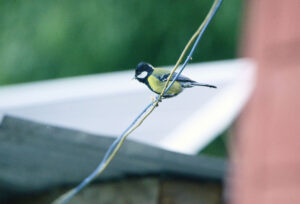
Green-backed tit, feeding on a moth, Sherpagaon, Langtang Valley, central Nepal. (Photo copyright © by Kaj Halberg)
Pseudopodoces humilis Tibetan ground tit
This bird, the only member of the genus, is living on the Tibetan Plateau, and also in dry areas of extreme north-western Pakistan and India, north-western Nepal, and northern Bhutan.
The nest is very unusual for that of a passerine, being built inside a burrow which the birds excavate themselves into a bank, sometimes reaching a depth of 1.8 m.
The peculiar appearance of this bird confused German palaeontologist and zoologist Johann Gotthelf Fischer von Waldheim (1771-1853), who worked in Russian service 1804-1853. He assumed that it was a kind of small ground jay, naming it Pseudopodoces, from Ancient Greek pseudos (‘false’), and Podoces, the genus name of ground jays, with the specific name humilis, from the Latin humus (‘ground’).
Genetic research has since revealed that it is a tit, with its closest relatives in the genus Parus.
Tibetan ground tit, Shigatse, Tibet. (Photo copyright © by Kaj Halberg)
Passeridae Old World sparrows, snowfinches
As the family name implies, these birds, comprising about 43 species in 8 genera, are restricted to the Old World. They are not closely related to the New World sparrows, which belong to the family Passerellidae. When the European settlers arrived in America, these birds reminded them of the sparrows back home, so they named them ‘sparrows’.
Montifringilla Snowfinches
A small genus of 3 high-altitude passerines, distributed mainly in Central Asia. A single species, the white-winged snowfinch (M. nivalis), has a patchy distribution in montane areas further west, reaching northern Spain.
The generic name is derived from the Latin mons (‘mountain’) and fringilla (‘finch’). Initially, these birds were regarded as finches, of the family Fringillidae (above). However, genetic research has shown that they are in fact sparrows.
Formerly, five other birds were included in this genus, but 4 have been moved to the genus Pyrgilauda, one to Onochostruthus.
Montifringilla adamsi Black-winged snowfinch
This is a common resident on the Tibetan Plateau and in western China, and is also found in the extreme northern regions of Pakistan, India, Nepal, and Bhutan, living in open stony areas, shrubland, and near villages. In north-western Nepal, it breeds at elevations between 4,200 and 5,100 m, descending to between 2,500 and 3,500 m in winter.
The specific name honours Scottish physician and naturalist Andrew Leith Adams (1827-1882), who served as army physician in India 1849-1854, where he spent his spare time studying the natural history of the area.
Previously, this bird was called Tibetan snowfinch. However, that name is now reserved for M. henrici, also referred to as Henri’s snowfinch.
Black-winged snowfinch, drinking from a spring, Puga Marshes, Ladakh. (Photos copyright © by Kaj Halberg)
Black-winged snowfinch, eating a seed, Nagarze, southern Tibet. (Photo copyright © by Kaj Halberg)
Passer Typical sparrows
A genus with about 28 species, widely distributed in Africa and Eurasia.
The generic name is the classical Latin word for sparrows.
Passer domesticus House sparrow
This well-known bird was originally native to Europe, northern and north-eastern Africa, and most temperate and subtropical areas of Asia, but has been introduced to almost the entire planet. In the Himalaya, where it was previously a common resident below 2,000 m, and uncommon up to 3,000 m, it has declined dramatically in later years, mainly due to the increased usage of chemical fertilizers and insecticides.
The specific name is Latin, meaning ‘belonging to houses’, from domus (‘house’).
Other pictures, depicting this species, may be seen on the pages Animals: Urban animal life, and Nature: Invasive species.
House sparrows, observed at Kielang, Lahaul, Himachal Pradesh, at an altitude of about 3,000 m. (Photo copyright © by Kaj Halberg)
Passer montanus Tree sparrow
The distribution area of this bird is huge, from western Europe across Central Asia to Japan, and thence southwards through Indochina to Indonesia and the Philippines. In the Himalaya, it is a common and widespread resident up to elevations around 4,300 m.
The specific name is Latin, meaning ‘belonging to mountains’, from mons (‘mountain’). An odd name for this bird, which is very common in lowlands.
Other pictures, depicting this species, are shown on the pages Animals – Birds: Birds in Taiwan, and Animals: Urban animal life.
Tree sparrow on a tree root, Kathmandu. (Photo copyright © by Kaj Halberg)
Tree sparrow on a house roof, Dhunche, Langtang National Park, central Nepal. (Photo copyright © by Kaj Halberg)
Phasianidae Pheasants and allies
This family, containing about 190 species, includes pheasants, partridges, junglefowl, Old World quails, peafowl, grouse, and many others. These birds are found worldwide, except in Antarctica.
According to the latest genetic research, guineafowl and New World quails are treated as separate families, Numididae and Odontophoridae, respectively.
Alectoris Rock partridges
A genus of 7 species of small game birds, distributed in southern Europe, northern Africa, the Arabian Peninsula, and from the Middle East eastwards to north-eastern China. A single species is found in the Himalaya.
The generic name is derived from Ancient Greek alektoris (‘chicken’).
Alectoris chukar Chukar
This bird is distributed from Greece, Bulgaria, and Egypt eastwards across the Middle East to Central Asia and north-eastern China. It has also been introduced as a hunting object to many other areas and has formed feral populations in several countries, including the United States and New Zealand.
In the Himalaya, it is distributed as far east as western Nepal, found at elevations between 2,100 and 4,000 m. It is very common in Ladakh.
The specific and popular names refer to the bird’s call, a far-reaching chuck-chuck-chukar-chukar.
A pair of chukar with almost full-grown chicks, near Hemis Gompa, Ladakh. (Photo copyright © by Kaj Halberg)
Chukar, Gya River Valley, near Rumtse, Ladakh. (Photo copyright © by Kaj Halberg)
Chukar, drinking from a stream, Gya River Valley. (Photo copyright © by Kaj Halberg)
Ithaginis cruentus Blood pheasant
The male of this relatively small species, the only member of the genus, has a striking plumage with several blood-coloured streaks on breast and rump. It is widespread and fairly common, found from western Nepal eastwards to northern Myanmar and large parts of western China. In the Himalaya, it is resident at elevations between 3,200 and 4,400 m, mostly in rhododendron shrubs.
It is rather tame around the Sherpa monastery of Tengboche, Khumbu, eastern Nepal, where hunting is banned for religious reasons. It is the state bird of Sikkim.
The generic name is a Latinized version of Ancient Greek ithagenes (‘noble’), whereas the specific name is Latin, meaning ‘bloody’, like the common name alluding to the red streaks on the breast and rump of the male.
Male blood pheasant, Deboche, Khumbu, eastern Nepal. (Photo copyright © by Kaj Halberg)
Lophophorus Monal pheasants
A genus of 3 gorgeous gamebirds, distributed from Afghanistan eastwards along the Himalaya to central China.
The generic name is derived from Ancient Greek lophos (‘crest’) and phoros (‘bearing’), alluding to the small crest of the Himalayan monal (below).
Lophophorus impejanus Himalayan monal
This species, which is sometimes called Impeyan pheasant, is distributed from Afghanistan eastwards along the Himalaya to Bhutan, in summer found at elevations between 3,300 and 4,600 m, in winter at slightly lower altitudes.
It is the national bird of Nepal, locally called danphe, and often referred to as ’the bird of nine colours’. In sunshine, the brilliant plumage of the male is glittering in almost all imaginable colours. The female is brownish and heavily streaked, with naked blue skin around the eyes and a pale patch on the throat.
It is also the state bird of Uttarakhand.
The specific name commemorates Lady Mary Impey, wife of Sir Elijah Impey (1732-1809), who was chief justice of the Supreme Court at Fort William, the first settlement of the British East India Company in Bengal.
As with most other gamebirds, the meat of monal is delicious, and for this reason it is hunted in many places. However, it is still common locally, and in the Khumbu area of eastern Nepal it is very common, as the local Buddhist Sherpas are against killing. So even though the monal does some damage by digging up potatoes and eating them, they are not persecuted here.
Male Himalayan monal, surveying his territory from a rock, Kyangjuma, Khumbu, eastern Nepal. (Photo copyright © by Kaj Halberg)
Female monal, between Pangboche and Phortse, Khumbu, eastern Nepal. (Photo copyright © by Kaj Halberg)
During a hike in the Great Himalayan National Park, Himachal Pradesh, we encountered this monal chick. (Photo copyright © by Kaj Halberg)
Tetraogallus Snowcocks
A genus of 5 large species of game birds, distributed in montane areas from eastern Turkey and the Caucasus eastwards to Central Asia and western China.
The generic name is a combination of two other genus names, Tetrao (capercaillie) and Gallus (junglefowl).
Tetraogallus tibetanus Tibetan snowcock
This species is widely distributed in Central Asian mountains, from Tajikistan southeast along the Himalaya to Arunachal Pradesh, thence northwards through western China to Qinghai, and from there westwards to the Kunlun Mountains. It avoids desert areas of the Tibetan Plateau.
It is rather common in drier areas of the higher parts of the Himalaya, breeding mainly at altitudes between 4,500 and 5,500 m, descending to slightly lower elevations in winter.
At dawn, the call of this bird can be heard from a considerable distance, a penetrating gukka-gukka-guk-guk-guk-grrr.
Tibetan snowcock, Merak, Makalu National Park, eastern Nepal. (Photo copyright © by Kaj Halberg)
Tibetan snowcocks, feeding near Tughla, Khumbu, eastern Nepal. (Photos copyright © by Kaj Halberg)
Phylloscopidae Leaf-warblers
In former days, members of this family were placed in the large warbler family (Sylviidae). However, genetic studies have had the effect that this family has been split into a number of families.
Leaf-warblers are about 80 species of small insectivorous birds, all belonging to the genus Phylloscopus. Previously, the family included the genus Seicercus, but recent genetic studies concluded that members of this genus should be moved to Phylloscopus.
The generic name is derived from Ancient Greek phyllon (‘leaf’) and skopos, from skopeo (‘to watch’), in this connection presumably meaning ‘to search’ (for insects).
Phylloscopus burkii Golden-spectacled warbler, green-crowned warbler
This bird was formerly placed in the genus Seicercus. It is breeding in moist forests of the Himalaya at elevations between 2,000 and 3,800 m, from Kashmir eastwards to Bhutan, spending the winter in Bangladesh and eastern India. It has a broad yellow eyering, which gave rise to one of the common names.
The specific name honours British physician and naturalist William Augustus Burke (1769-1836), who served in India as Inspector General of Army Hospitals.
Golden-spectacled warbler, taking off from a branch, Phele, Ghunsa Valley, eastern Nepal. (Photos copyright © by Kaj Halberg)
Phylloscopus reguloides Blyth’s leaf-warbler
This species is widely distributed in moist montane forests, from northern Pakistan along the Himalaya eastwards to Indochina and southern China. In the Himalaya, it is found at elevations between 2,000 and 3,800 m in summer, the major part of the population wintering below 1,500 m.
The specific name is derived from the Latin regulus (‘kinglet’ or ‘petty king’) and oides (‘like’), alluding to the likeness of the bird to goldcrests and kinglets, genus Regulus.
The popular name refers to English zoologist Edward Blyth (1810-1873), who described a number of birds from the Himalaya. He worked as a curator of zoology at the museum of the Asiatic Society of India in Calcutta (today Kolkata).
Blyth’s leaf-warbler, sitting on a branch of a Himalayan birch (Betula utilis), Kyangjuma, Khumbu, eastern Nepal. (Photo copyright © by Kaj Halberg)
Blyth’s leaf-warblers, observed between Thangshyap and Ghora Tabela, Langtang Valley, central Nepal. (Photos copyright © by Kaj Halberg)
Phylloscopus trochiloides Greenish warbler
A rather non-descript warbler, brownish with a faint white eyebrow and a faint black eye-stripe. Divided into 3 subspecies, it has a huge distribution area, found from eastern Europe eastwards to south-central Siberia and Mongolia, and thence southwards to the Himalaya and western China. In the Himalaya, it breeds in forests at altitudes between 2,700 and 4,300 m, in winter descending below 2,200 m.
The specific name means ‘resembling the chiffchaff’ (P. trochilos).
Greenish warbler, subspecies trochiloides, Phedi, near Gosainkund, Langtang National Park, central Nepal. (Photo copyright © by Kaj Halberg)
Phylloscopus xanthoschistos Grey-hooded warbler
A pretty bird with lemon-yellow underparts, greenish wings, and grey back and head with a broad white eyebrow and sometimes a white patch below the eye. It is common, occurring from northern Pakistan eastwards along the Himalaya to south-western China. It lives in forest, secondary growth, parks, and gardens, breeding at altitudes between 900 and 2,800 m, in winter usually descending below 2,000 m.
The specific name is derived from Ancient Greek xanthos (‘yellow’) and the Latin schistus (‘slate’), thus ‘the yellow and slate-coloured’ (bird).
Grey-hooded warbler, Dhulikhel, near Kathmandu. (Photos copyright © by Kaj Halberg)
Picidae Woodpeckers
Members of this family, comprising about 240 species in 35 genera, are found worldwide, except for Australia, New Guinea, New Zealand, Madagascar, and polar regions. Most species are known for their characteristic way of foraging, pecking on tree trunks and branches. In the breeding season, many species communicate by drumming with their beak on a tree trunk.
Dendrocopos
A widespread genus, found in Eurasia and North Africa. Formerly, it contained about 25 species, but many have been moved to other genera, leaving 12 species in Dendrocopos.
The generic name is derived from Ancient Greek dendron (‘tree’) and kopos (‘hard work’), of course alluding to their way of feeding.
Dendrocopos macei Fulvous-breasted woodpecker
This widespread species lives in drier forests, from northern Pakistan eastwards along the Himalaya to south-western China, and also in northern Myanmar, Bangladesh, and along the north-eastern coast of India. In the Himalaya, it is restricted to lower altitudes, mainly below 1,800 m.
The specific name commemorates French captain and explorer Marc Joseph Macé Marion-Dufresne (1724-1772), who explored the Indian and Pacific Oceans, making important new discoveries in Tasmania and New Zealand. He was killed by Maoris, when the expedition made a prolonged stay ashore in New Zealand.
Male fulvous-breasted woodpecker, feeding on the trunk of a dead coral tree (Erythrina stricta), Corbett National Park, Kumaon, Uttarakhand. (Photo copyright © by Kaj Halberg)
Picus
This genus contains about 13 species, found in the major part of Eurasia, and also in North Africa.
The generic name is the classical Latin word for woodpecker.
Picus squamatus Scaly-bellied woodpecker
A rather large, mainly green woodpecker, identified by the characteristic scaly pattern on breast and belly. It is found from Turkmenistan and Afghanistan eastwards across Pakistan and north-western India to eastern Nepal, living in forests from the lowlands up to elevations around 3,100 m.
The specific name is Latin, meaning ‘scaly’.
Scaly-bellied woodpecker, sun-bathing, Ghora Tabela, Langtang Valley, central Nepal. (Photos copyright © by Kaj Halberg)
Pnoepygidae Wren-babblers, cupwings
This family contains a single genus, Pnoepyga, comprising 5 species of tiny birds, which were previously regarded as babblers of the family Timaliidae. However, following genetic research, they have been moved to a separate family.
The generic name is derived from Ancient Greek pnoe (‘puffed’) and pyge (‘rump’). The name cupwing alludes to the short, rounded wings of these birds.
Pnoepyga albiventer Scaly-breasted wren-babbler
This tiny bird, also known as scaly-breasted cupwing, is found in the Himalaya, from Kashmir eastwards to Myanmar, in the mountains of north-eastern India, and in northern Vietnam. In the Himalaya, it breeds at altitudes between 2,400 and 4,000 m, descending to the lower valleys in winter.
The specific name is derived from the Latin albus (‘white’) and ventris (‘belly’).
Previously, birds in Taiwan were treated as a subspecies of the scaly-breasted wren-babbler, but have now been elevated to a separate species, P. formosana.
Scaly-breasted wren-babbler, Deorali, Upper Modi Khola Valley, Annapurna, central Nepal. (Photo copyright © by Kaj Halberg)
Prunellidae Accentors
A small group of passerines, comprising 13 species in Prunella, the sole genus of the family. Most species are restricted to Asia, with 2 species, the dunnock (P. modularis) and the alpine accentor (below), also found in Europe. They live in montane areas, except the dunnock, which is mainly a lowland bird.
The generic name can be traced back to Historiæ animalium, Liber III, published in 1555 by Swiss physician and naturalist Konrad Gessner (1516-1565). The name was adapted from Braunelle, the German name of the dunnock, a diminutive of braun (‘brown’), thus ‘the small brown’ (bird).
Prunella collaris Alpine accentor
This species has a very wide distribution, from Morocco and Spain across central Europe and the Middle East to Central Asia, the Himalaya, China, Japan, and Taiwan. In the Himalaya, it is found at high elevations between 4,200 and 5,500 m, descending to between 2,500 and 3,800 m in winter.
The specific name is Latin, meaning ‘collared’, presumably alluding to the grey neck and nape.
Its breast feathers ruffled by a fierce gust of wind, this Alpine accentor is singing from a lichen-encrusted rock in Gokyo Valley, eastern Nepal. (Photos copyright © by Kaj Halberg)
Prunella fulvescens Brown accentor
This bird has a very wide distribution in Central Asia, found from southern Kazakhstan, southern Siberia, and Mongolia southwards to Afghanistan, the northern outskirts of the Himalaya, eastwards to western and north-eastern China. It lives in shrubby vegetation and avoids the harshest areas of the deserts.
It is a rather common resident in Ladakh and the driest parts of northern Nepal, found in summer at altitudes up to about 4,900 m, in winter descending to between 2,300 and 4,000 m.
The specific name is derived from the Latin fulvus (‘tawny’ or ‘yellowish-brown’).
Brown accentor, Tajung, Ladakh. (Photo copyright © by Kaj Halberg)
Brown accentor, Gyantse, southern Tibet. (Photo copyright © by Kaj Halberg)
Prunella himalayana Altai accentor
This species is found from the Altai Mountains of southern Siberia and western Mongolia southwest via the Tien Shan Mountains to the Pamir Mountains of eastern Afghanistan, spending the winter from Afghanistan along the Himalaya eastwards to Bhutan. In the Himalaya, it is a fairly common winter visitor in shrubby vegetation and grassy areas at elevations between 2,000 and 4,300 m.
Altai accentor, Jarsang Valley, Upper Marsyangdi Valley, Annapurna, central Nepal. (Photos copyright © by Kaj Halberg)
Prunella rubeculoides Robin accentor
This bird is found from eastern Afghanistan along the Himalaya eastwards to the major part of eastern Tibet and western China. It is common in the Himalaya, breeding in shrubby vegetation at altitudes between 4,200 and 5,000 m, descending in winter to between 2,600 and 4,000 m.
The specific and popular names both allude to the breast of this species, which is of the same warm reddish colour as the breast of the Eurasian robin (Erithacus rubecula).
Robin accentor, Lhonak, Upper Ghunsa Valley, eastern Nepal. (Photo copyright © by Kaj Halberg)
Robin accentor, feeding on insects at a mountain stream, Gokyo Valley, Khumbu, eastern Nepal. (Photo copyright © by Kaj Halberg)
Prunella strophiata Rufous-breasted accentor
This species has about the same distribution as the robin accentor, but is also found in northern Indochina. Its altitudinal distribution overlaps with that of the robin accentor, but it is generally found at slightly lower elevations, between 3,500 and 4,900 m in summer, descending to between 1,600 and 3,700 m in winter. The two species seem to co-exist in the same shrubby habitat.
The specific name is derived from Ancient Greek strophion (‘breaststrap’), originally a band worn around the breasts, like a bra. Naturally, it refers to the reddish-brown breast band of this bird.
Rufous-breasted accentor, Merak, Barun Valley, eastern Nepal. (Photo copyright © by Kaj Halberg)
Rufous-breasted accentor, sitting in a juniper, Pheriche, Khumbu, eastern Nepal. (Photo copyright © by Kaj Halberg)
Psittaculidae Asian and Australian parrots
Previously, all parrots were placed in the family Psittacidae, with about 360 species in 92 genera. However, genetic research has had the effect, that Asian, Australian, and Indian Ocean island parrots, and the African lovebirds (Agapornis) have been placed in a separate family with 55 genera and about 195 species.
Psittacula Ring-necked parakeets
A genus of 13 medium-sized, mainly green parrots, most of which live in Asia, with a few representatives on islands in the Indian Ocean, off the African coast.
The generic name is a diminutive of the Latin word for parrots, psittacus, thus ‘small parrot’.
Psittacula himalayana Slaty-headed parakeet
This is mainly a bird of the Himalaya, found from northern Pakistan eastwards to Arunachal Pradesh, but it also occurs in montane areas of western Pakistan and eastern Afghanistan. It is one of the few parrots with annual altitudinal movements, found up to elevations around 2,500 m in summer, but moving to the lower valleys in winter, usually below 1,000 m.
Slaty-headed parakeet, Corbett National Park, Kumaon, Uttarakhand. (Photo copyright © by Kaj Halberg)
Pycnonotidae Bulbuls and allies
A family of medium-sized passerines, comprising 27 genera with about 150 species. They are distributed in much of Africa, across the Middle East and South Asia to Japan, and thence southwards to Indonesia.
Sub-Saharan members of the family, called greenbuls, brownbuls, leafloves, and bristlebills, are mainly forest birds, whereas the majority of North African and Asian species live in open areas.
Hypsipetes Black bulbuls
A genus of about 19 species, found from Madagascar and various islands in the Indian Ocean eastwards to the Indian Subcontinent, southern China, and Taiwan, and thence southwards through Indochina to Indonesia.
Formerly, the black bulbuls of Asia were regarded as subspecies of the Malagasy bulbul (H. madagascariensis), but most authorities now recognize two separate Asian species, the Asian black bulbul (below), which is widely distributed, found from north-eastern Afghanistan along the Himalaya to Indochina, China, and Taiwan, and the square-tailed bulbul (H. ganeesa), which is restricted to montane areas of South India and Sri Lanka.
The generic name is derived from Ancient Greek hypsi (‘high’) and petes (‘flyer’), thus ‘the one that flies high’.
Hypsipetes leucocephalus Asian black bulbul
This bird is predominantly black, or slate-black, bill and gape are bright read, and the feet are orange. Sometimes white-headed morphs are seen.
The specific name is derived from Ancient Greek leukos (‘white’) and kephale (‘head’), so the species must have been described from a white-headed specimen.
In the Himalaya, subspecies psaroides is distributed from eastern Afghanistan eastwards to northern Myanmar, living in forests from the lower valleys up to elevations around 3,000 m. It is much greyer than the other subspecies, with a conspicuous grey patch behind the eye.
Asian black bulbul, subspecies psaroides, between Surkhe and Shyabrubesi, Langtang Valley, central Nepal. (Photo copyright © by Kaj Halberg)
Singing black bulbul, ssp. psaroides, Yamphudin, Kabeli Valley, eastern Nepal. (Photos copyright © by Kaj Halberg)
Pycnonotus Typical bulbuls
Members of this genus, comprising about 32 species, are widely distributed in Africa, and from the Middle East across the Indian Subcontinent to southern China and Taiwan, and thence southwards to Indonesia.
The generic name is derived from Ancient Greek pyknos (‘thick’ or ‘compact’) and noton (‘back’), applied in 1826 by German zoologist and lawyer Friedrich Boie (1789-1870), who described many new species and several new genera of birds. Presumably, Boie found that these birds were quite compact.
He and his brother Heinrich also described about 50 new species of reptiles.
Pycnonotus leucogenys Himalayan bulbul
This bird, also called white-cheeked bulbul, is common and widespread in the Himalaya, found from eastern Afghanistan eastwards to south-western China. In the Himalaya, it lives in scrubland and secondary growth from the lower valleys up to altitudes around 2,500 m.
The specific name is derived from Ancient Greek leukos (‘white’) and genys (‘cheek’).
Himalayan bulbuls on banana leaves, Begnas Tal, central Nepal. (Photo copyright © by Kaj Halberg)
Himalayan bulbul, Tatopani, Kali Gandaki Valley, Annapurna, central Nepal. (Photos copyright © by Kaj Halberg)
Recurvirostridae Avocets and stilts
Avocets and stilts are wading birds, characterized by their very long and thin legs. They are widely distributed around the world.
Himantopus Stilts
Stilts are found on all continents, except Antarctica. According to the latest genetic research, 6 species are recognized, all belonging to this genus with the exception of the banded stilt (Cladorhynchus leucocephalus), a strange nomadic bird, which is restricted to Australia, where it only breeds after ample rain, when large salt lakes are created at various places in the desert.
The first part of the generic name is derived from the Latin amentum, a leather strap, which was attached to a javelin, used in classical Greek athletics, hunting, and warfare. This strap helped to increase the range and stability of the javelin in flight. (Source: E. Gardiner 1907. Throwing the Javelin. The Journal of Hellenic Studies, 27: 249-273)
The second part of the name is derived from Ancient Greek pous (‘foot’). Thus, Himantopus may be translated as ‘strap-leg’, which of course refers to the very long, thin legs of these birds.
Himantopus himantopus Black-winged stilt
This species is distributed in most temperate, subtropical, and tropical regions of the world, but is restricted to areas with shallow water. Northern populations are migratory. In the Himalaya, it is a rather uncommon passage migrant.
The male is usually a little larger than the female, with black wings and back, often with a greenish sheen, whereas back and wings of the female are dark slate-coloured. Head and neck can be pure white, but have more or less extended parts of dark on many birds. Immature birds, up to one year old, have more greyish legs, but are difficult to distinguish from adults.
Black-winged stilts, Sissu, Lahaul, Himachal Pradesh. The bird to the right is an immature. (Photos copyright © by Kaj Halberg)
Black-winged stilt, feeding in a stream, near Niki La, Ladakh. (Photos copyright © by Kaj Halberg)
Sittidae Nuthatches
Nuthatches are a family of c. 29 species of small passerines, with only a single genus, Sitta. These birds are characterized by their feeding behavior, creeping up and down tree trunks in search of larvae, which they extract from the wood, using their powerful bill.
The generic name is derived from Ancient Greek sitte, a bird like a woodpecker, mentioned by Greek grammarian Hesychius of Alexandria (5th or 6th Century A.D.), and also by Greek philosopher and scientist Aristotle (384-322 B.C.).
Sitta himalayensis White-tailed nuthatch
A common resident in forests at elevations between 1,800 and 3,200 m, from Himachal Pradesh eastwards along the Himalaya to northern Myanmar, northern Vietnam, and the Yunnan Province of China, and also in mountains along the India-Myanmar border. Some birds descend to the lower valleys in winter.
Despite the name of this bird, the white at the base of the upper tail is difficult to see in the field.
White-tailed nuthatch, Dhunche, Langtang Nationalpark, central Nepal. (Photo copyright © by Kaj Halberg)
Strigidae Typical owls
A large cosmopolitan family, comprising 25 genera with about 220 species. These birds are found on all continents, except Antarctica.
Glaucidium Owlets, pygmy owls
This genus of small to very small owls, comprising about 30 species, is found worldwide, with the exception of Australia and Antarctica. The largest diversity is in South America.
The generic name is derived from Ancient Greek glaukidion (‘small owl’), diminutive of glaux (‘owl’).
Glaucidium cuculoides Asian barred owlet
This species lives in forests, from northern Pakistan along the Himalaya to Bangladesh and north-eastern India, the entire Indochina, and the southern half of China. In the Himalaya, it is found from the lowlands up to elevations around 2,500 m.
The specific name is derived from cuculus, the old Latin name for cuckoos, and Ancient Greek oides (‘resembling’), presumably alluding to the cuckoo-like plumage of this owl.
This Asian barred owlet is illuminated by a patch of late afternoon sunshine, penetrating the thicket, in which it is sitting, between Ilam and Jamuna, eastern Nepal. (Photo copyright © by Kaj Halberg)
Glaucidium radiatum Jungle owlet
This owlet is distributed in drier forests in almost the entire Indian Subcontinent, including the eastern part of Sri Lanka. In the Himalaya, it is restricted to the lower valleys below an altitude of 1,000 m.
The specific name is Latin, meaning ‘barred’, derived from radius (‘ray’).
Birds in the western wet zone of Sri Lanka were once considered a subspecies of jungle owlet, but is now regarded as a separate species, called chestnut-backed owlet (G. castanotum).
Jungle owlet, Corbett National Park, Kumaon, Uttarakhand. (Photo copyright © by Kaj Halberg)
Ketupa Fish-owls
Following genetic research, this genus of large owls now contains 12 species, as several species, which were formerly included in the genus Bubo, have been moved to this genus. They are distributed from the Middle East eastwards to Japan, The Philippines, and Southeast Asia, and also in Africa south of the Sahara.
Some authorities still include these birds in the genus Bubo.
The generic name is derived from the Malay word for fish-owl, ketupok.
Ketupa flavipes Tawny fish-owl
This owl, by some authorities named Bubo flavipes, is very widely distributed, found from Uttarakhand along the Himalaya eastwards to north-eastern India, the eastern part of Indochina, and the southern half of China. In the Himalaya it is quite rare, restricted to valleys below an elevation of 500 m.
It has yellow feet, reflected in the specific name, from the Latin flavus (‘yellow’) and pes (‘foot’).
Juvenile tawny fish owl, Corbett National Park, Kumaon, Uttarakhand. (Photo copyright © by Kaj Halberg)
Strix Wood owls
A genus of 19 or 23 species, depending on authority. These owls are distributed almost worldwide, on all continents except Australia and Antarctica.
Strix nivicolum Himalayan wood owl
This bird lives in montane forests, from the western Himalaya eastwards to northern Indochina, most of China, Taiwan, and Korea. In the Himalaya, it is fairly common at elevations between 2,000 and 4,000 m.
In the past, it was regarded as a subspecies of the widespread tawny owl (S. aluco), but its call is different, and the shorter tail is barred.
The specific name is derived from the Latin nix (‘snow’) and colere (‘to inhabit’), alluding to this bird living at high altitudes.
Himalayan wood owl, Sanasa, Khumbu, eastern Nepal. (Photo copyright © by Kaj Halberg)
Sturnidae Starlings and mynas
Starlings and mynas constitute a family of about 118 species of medium-sized passerines, divided into c. 30 genera. Their natural area of distribution includes Europe, Africa, Asia, northern Australia, and some Pacific islands.
Many species have been introduced elsewhere, including North America, Hawaii, and New Zealand. They often compete with native birds, and many are regarded as invasive species, especially the common myna (below), and in North America the common starling (Sturnus vulgaris), described on the pages Nature: Invasive species, and Animals – Birds: Birds in the United States and Canada.
Acridotheres Mynas
A genus with 10 species, found from Kazakhstan, Turkmenistan, and Iran eastwards to China and Taiwan, southwards to Sri Lanka and Indonesia.
The generic name is derived from Ancient Greek akridos (‘locust’) and theras (‘hunter’). When locusts or grasshoppers are abundant, starlings and mynas gorge themselves on these insects. An example is described on the page People: Pehr Forsskål – brilliant Swedish scientist.
Several species in this genus are described on the page Animals – Birds: Birds in Taiwan.
Acridotheres fuscus Jungle myna
This bird lives mainly in hilly areas, found in the major part of the Indian Subcontinent, including the entire Himalaya, and also in western Myanmar and Thailand, and in the Malaccan Peninsula. In the Himalaya, it may be found up to elevations around 2,000 m.
It has been introduced elsewhere, often escaping to form feral populations, for example in Japan, Western Samoa, and Fiji. In the latter country, it was introduced around 1890 to control insect pests in sugarcane, and from there it has spread to other Pacific Islands, including Niuafo’ou, where it has become a threat to native bird species, competing for nesting holes.
The population of subspecies torquatus, which lives in Malaysia, is declining, probably being outcompeted by Javan mynas (A. javanicus), with which it forms hybrids. (Source: David Wells 2010. The Birds of the Thai-Malay Peninsula, Vol. 2. Bloomsbury Publishing)
The specific name is Latin, meaning ‘brown’, alluding to the brownish tinge on the otherwise slate-coloured plumage of the bird.
Jungle myna, Pokhara, central Nepal. (Photos copyright © by Kaj Halberg)
Acridotheres tristis Common myna
A widespread bird, distributed from Kazakhstan and Turkmenistan southwards to eastern Iran, and from the Indian Subcontinent eastwards through Indochina and the Malacca Peninsula to south-western China.
In the Himalaya, it is mainly restricted to the lower parts, but may be encountered up to elevations around 3,000 m in summer.
The common myna was originally a woodland bird, but has adapted very well to agricultural as well as urban environments.
Escaped cage birds have established populations in numerous other countries, including South Africa, Madagascar, several Arabian states, Japan, Taiwan, Indonesia, Australia, and New Zealand. In many places it has become a pest, which expels native birds, especially in Australia, where it has been called “a most important problem”. The IUCN Species Survival Commission has declared it one of the world’s most invasive species and a threat to “biodiversity, agriculture, and human interests”.
The specific name is Latin, meaning ‘sad’ or ‘gloomy’. Apparently, Swedish naturalist Carl Linnaeus (1707-1778), who named the bird in 1766, found its plumage rather drab.
Common myna, near the Bhumeshwor Shiva Temple, Pokhara, central Nepal. The bird in the upper picture is shaking its feathers. (Photos copyright © by Kaj Halberg)
Saroglossa spilopterus Spot-winged starling
This is the only member of the genus, breeding in the Himalaya, from Himachal Pradesh eastwards to Bhutan, spending the winter in north-eastern India, Bangladesh, Myanmar, and northern Thailand.
It is declining rather drastically due to loss of suitable habitat, which is moist lower-montane forests, which are cleared to create farmland. In the Himalaya, it is mainly found below an elevation of 1,000 m, but may occasionally stray up to about 1,800 m.
The generic name is derived from Ancient Greek saron (‘broom’) and glossa (‘tongue’). Maybe the tongue of this bird is split into more than two points? The specific name is derived from Ancient Greek spilos (‘spot’) and pteron (‘wing’).
The Madagascar starling (Hartlaubius auratus) is placed in this genus by some authorities. It is endemic to Madagascar.
Male spot-winged starling, Manigaon, Trisuli Valley, central Nepal. The female is a uniform brownish. (Photo copyright © by Kaj Halberg)
Tichodromidae
Tichodroma muraria Wallcreeper
This is the sole member of the family. Formerly, it was placed with the nuthatches in the family Sittidae.
It is very widely distributed in montane areas, from Spain eastwards across southern Europe, the Middle East, and the Caucasus to the southern parts of Central Asia. Some movements take place in the winter. In the Himalaya, it is a rather scarce breeding bird at altitudes above 3,000 m. It is more common in the winter, and may sometimes be observed in the lower valleys.
The generic name is derived from Ancient Greek teikhos (‘wall’) and dromos (‘to run’), alluding to the habit of this bird, feeding on steep rocks and cliffs. The specific name is derived from the Latin murus (‘wall’).
Wallcreeper, feeding on a bare slope along a road, Gangtsemu Mountains, Yunnan Province, China. The lower picture shows its crimson wings. (Photos copyright © by Kaj Halberg)
Turdidae Thrushes
Thrushes constitute a large, almost global family of small to medium-sized birds, which spend much time feeding on the ground for worms and other invertebrates, and many species also eat fruit. Previously, this family was much larger, including many genera which are today included in the Old World flycatcher family (Muscicapidae).
The word thrush is derived from Old English throstle, from Proto-Germanic þrustlō, an ancient name for the song thrush (Turdus philomelos). In Old Saxon, þrustlō became throsla, in German Drossel. The latter name was adopted by the Danes, whereas the Swedes use the name trast for these birds, and the Norwegians trost.
A number of thrush species are dealt with on the page Animals – Birds: Thrushes.
Grandala coelicolor Grandala
This species, the only member of the genus, is distributed from Kashmir along the entire Himalayan chain, and thence northwards through eastern Tibet to western China, from northern Yunnan northwards to eastern Qinghai. It breeds at very high altitudes between 4,000 and 5,500 m, moving to slightly lower elevations in winter.
The male is a gorgeous bird, with a plumage an almost iridescent hue of blue, whereas the female is greyish with faint white stripes on head, nape, and breast, and a brownish tinge to the wings.
Classification-wise, this species has been knocked about a great deal. Initially, it was regarded as belonging to the thrush family, but following genetic studies it was then transferred to the flycatcher family (Muscicapidae). However, recently it has been moved back to the thrush family!
Its behaviour shows traits from both families. It may feed on the ground like a thrush, but may also hover like a flycatcher to snap a flying insect (see picture text below).
The generic and common names are derived from the Latin grandis (‘grand’) and ala (‘wing’). However, in a broader sense the name may mean ‘grand bird’. The specific name is Latin, meaning ‘of sky-colour’, i.e. ‘sky-blue’, derived from coelum (‘sky’ or ‘heaven’) and color (‘colour’).
From a stone in a mountain stream in the Gokyo Valley, Khumbu, eastern Nepal, this male grandala would take off and flutter about butterfly-like to snap an insect, before returning to its vantage point. (Photos copyright © by Kaj Halberg)
Zoothera Asian thrushes
Formerly, c. 46 species were placed in this genus. However, at an early stage, two American species were transferred to other genera, the Aztec thrush to the genus Ridgwayia, and the varied thrush to Ixoreus. In 2008, following a number of genetic studies, c. 22 other species were transferred to the genus Geokichla.
The generic name is derived from Ancient Greek zoon (‘animal’) and theras (‘hunter’), referring to the habit of these thrushes to be searching for invertebrates on the forest floor.
Zoothera mollissima Alpine thrush
This bird is found from northern Pakistan along the Himalaya eastwards to south-eastern Tibet and south-western China. Previously, birds of central China were included in this species, then known as plain-backed thrush. However, genetic studies have had the effect that it has been split into 3 separate species, the alpine thrush, the Himalayan thrush (Z. salimalii), which breeds from Sikkim eastwards to the Yunnan Province in China, and the Sichuan thrush (Z. griseiceps), found in central China.
The specific name is Latin, meaning ‘very soft’. It may refer to the plumage of the bird.
Alpine thrush, Dhunche, Langtang National Park, central Nepal. (Photo copyright © by Kaj Halberg)
Upupidae Hoopoes
Previously, the genus Upupa, the sole genus of the family, contained only one species. Today, however, many authorities recognize 3 species, the common hoopoe (below), African hoopoe (U. africana), which is found in Africa south of the Sahel zone, and the Madagascar hoopoe (U. marginata), which is endemic to Madagascar.
Upupa epops Common hoopoe, Eurasian hoopoe
This striking bird has a very wide distribution, found in southern Europe, northern Africa southwards to the Sahel zone, excluding desert areas, and most of temperate and subtropical areas of Asia, southwards to Sri Lanka and the Malaccan Peninsula. In the Himalaya, it is a fairly common breeding bird, in summer found up to altitudes around 4,400 m, descending to below 1,500 m in winter.
Upupa and epops are the old Latin and Greek names for the hoopoe. Like the English name, they are onomatopoeic, imitating the call of the bird, a most characteristic hoop-up-up.
Hoopoe, Tso Kar, Ladakh. (Photo copyright © by Kaj Halberg)
This hoopoe is feeding by poking its long bill into the grass turf in search of worms, insect larvae, and other invertebrates, Puga Marshes, Ladakh. (Photos copyright © by Kaj Halberg)
Vangidae Vangas and allies
This family comprises a group of shrike-like birds, distributed in Madagascar, Africa, and Asia. In addition to the Malagasy vangas, to which the family owes its name, a number of other genera have now been placed here, including helmet-shrikes (Prionops), woodshrikes (Tephrodornis), and flycatcher-shrikes (Hemipus).
The family name is derived from the Malagasy word vanga, the name of the hook-billed vanga (Vanga curvirostris).
Hemipus Flycatcher-shrikes
This genus contains only two species, living in forests from the Indian Subcontinent eastwards to south-western China, and thence southwards through Southeast Asia, Sumatra, and Borneo to Java and Bali.
Classification-wise, this genus has been knocked around a great deal. First it was thought to belong to the shrikes (Laniidae), then it was moved to the cuckooshrikes (Campephagidae), then to the woodshrikes (Tephrodornithidae), and finally to Vangidae.
The generic name is derived from Ancient Greek hemi (‘half’, in this connection meaning ‘small’) and pous (‘foot’). Presumably, British naturalist and ethnologist Brian Houghton Hodgson (1801-1894), who erected the genus in 1844, found that these birds had small feet.
Hemipus picatus Bar-winged flycatcher-shrike
This bird is distributed in hilly areas of southern and eastern India and in Sri Lanka, from the western Himalaya eastwards to south-western China, and thence southwards through Indochina and Malaysia to Sumatra and Borneo. It is common in the Himalaya, found at elevations up to about 1,800 m.
The specific name is Latin, strictly speaking meaning ‘smeared with tar’, but in a wider sense ‘black-and-white’.
Bar-winged flycatcher-shrike, Dehra Dun, Uttarakhand. (Photo copyright © by Kaj Halberg)
Tephrodornis Woodshrikes
A small genus with 4 species, found in tropical Asia. Similar to flycatcher-shrikes, members were previously thought to belong to the shrikes (Laniidae), then moved to the cuckooshrikes (Campephagidae), then to Tephrodornithidae, and finally to Vangidae.
The generic name is derived from Ancient Greek tephrodes (‘like ashes’, i.e. ‘ash-coloured’) and ornis (‘bird’).
Tephrodornis pondicerianus Common woodshrike
This species has a rather drab plumage, greyish with a black face mask, although the latter is often fairly faint. It is distributed in warmer regions in the Indian Subcontinent and Indochina. In the Himalaya, it is distributed from Uttarakhand eastwards, ascending to about 1,600 m.
The specific name refers to Pondicherry, a former French colony in southern India, today called Puduchcheri. The type specimen was collected there.
Common woodshrike, Dhulikhel, near Kathmandu. (Photo copyright © by Kaj Halberg)
(Uploaded September 2022)
(Latest update November 2024)

